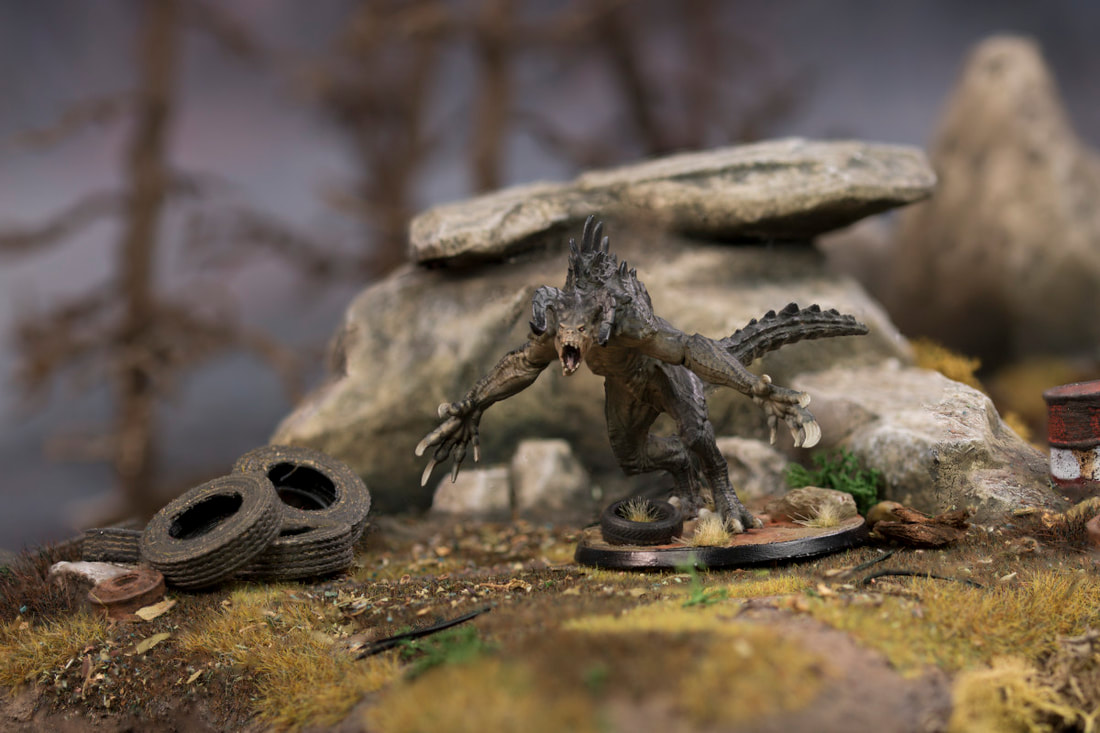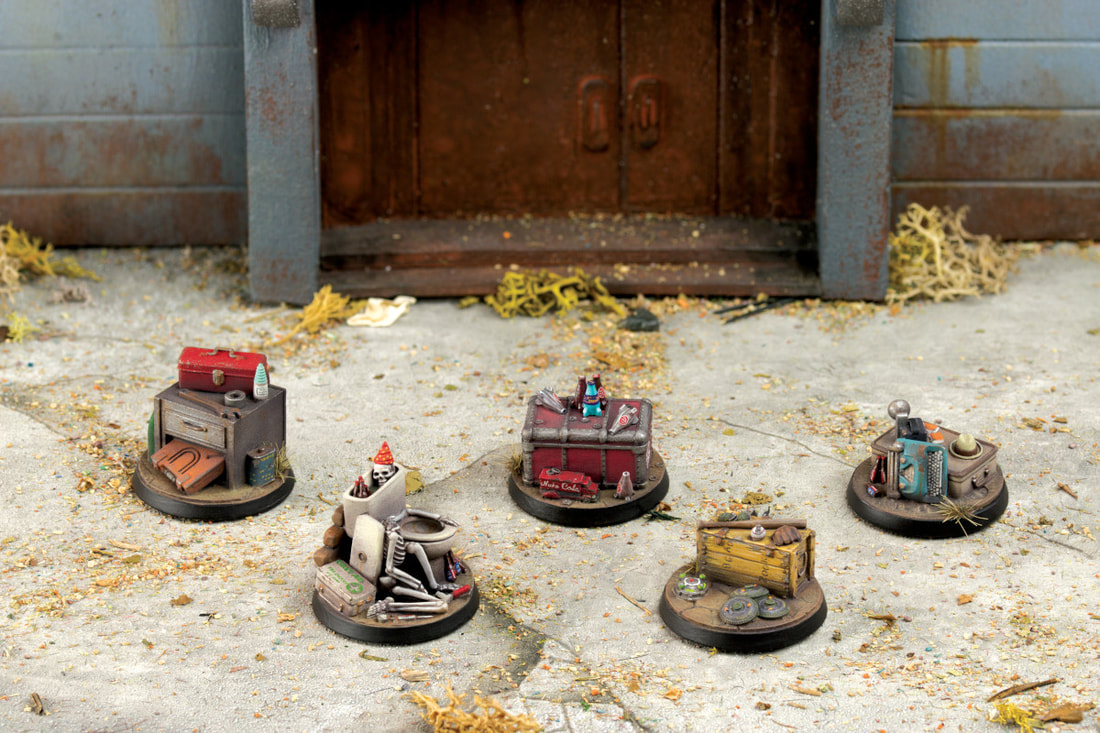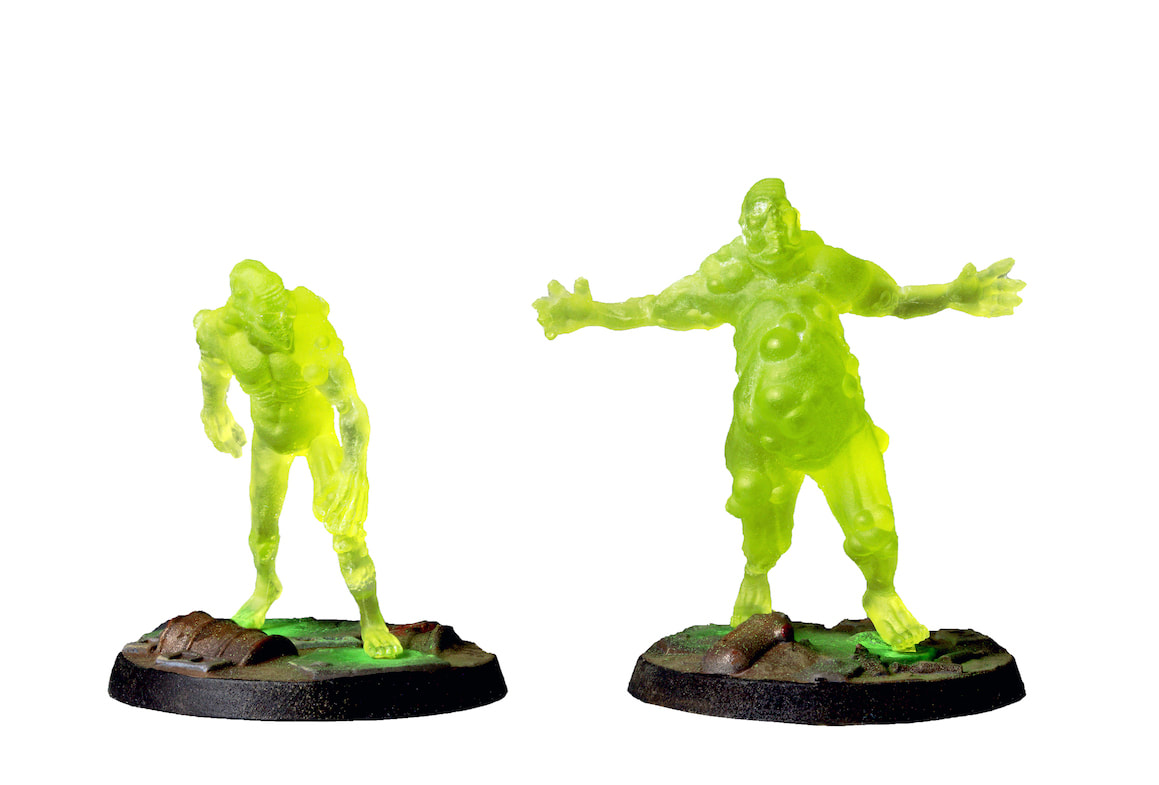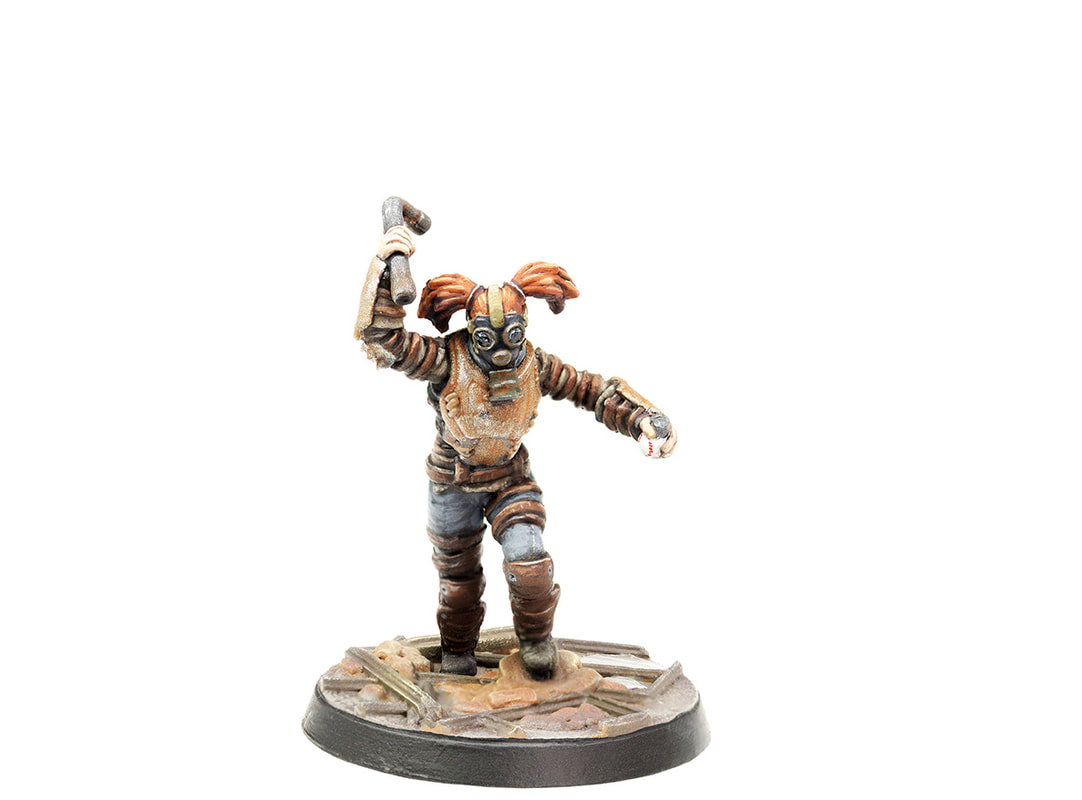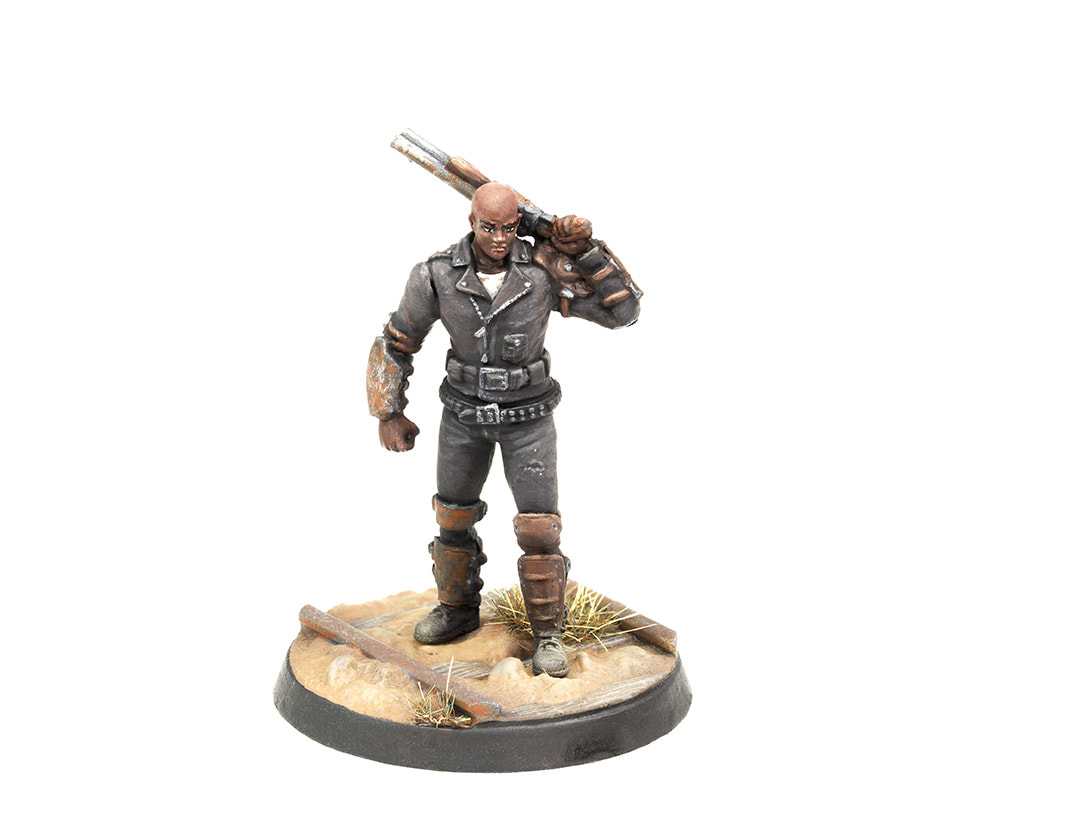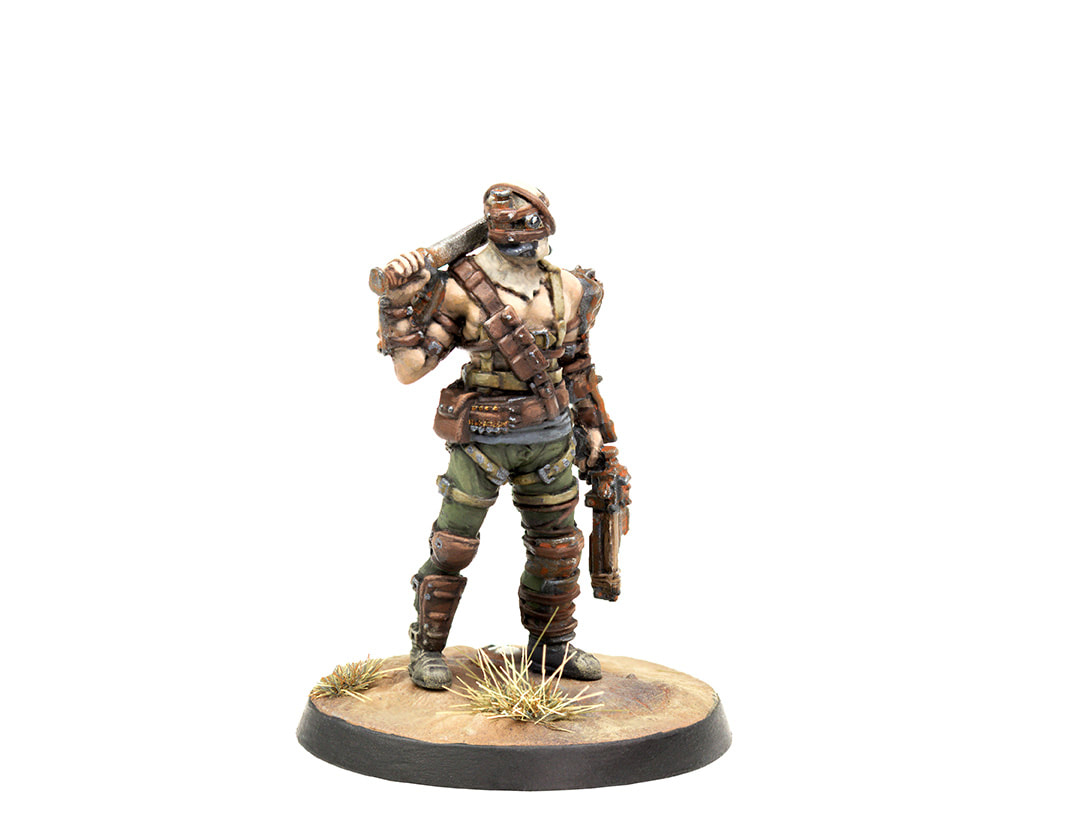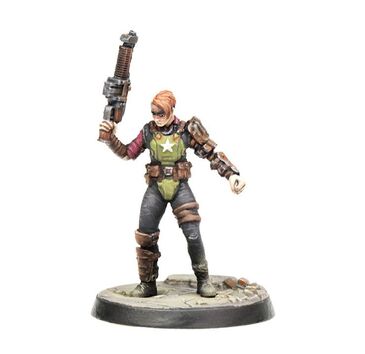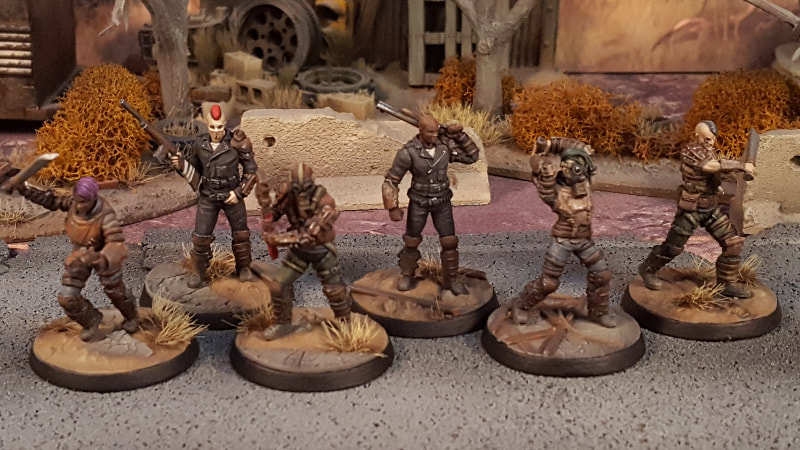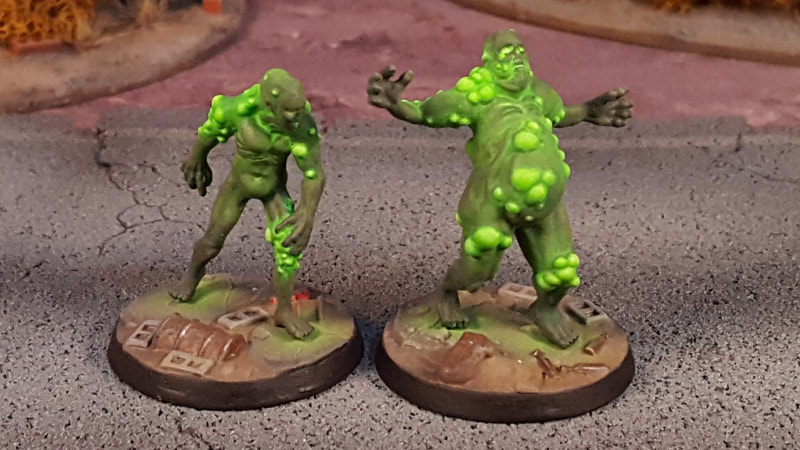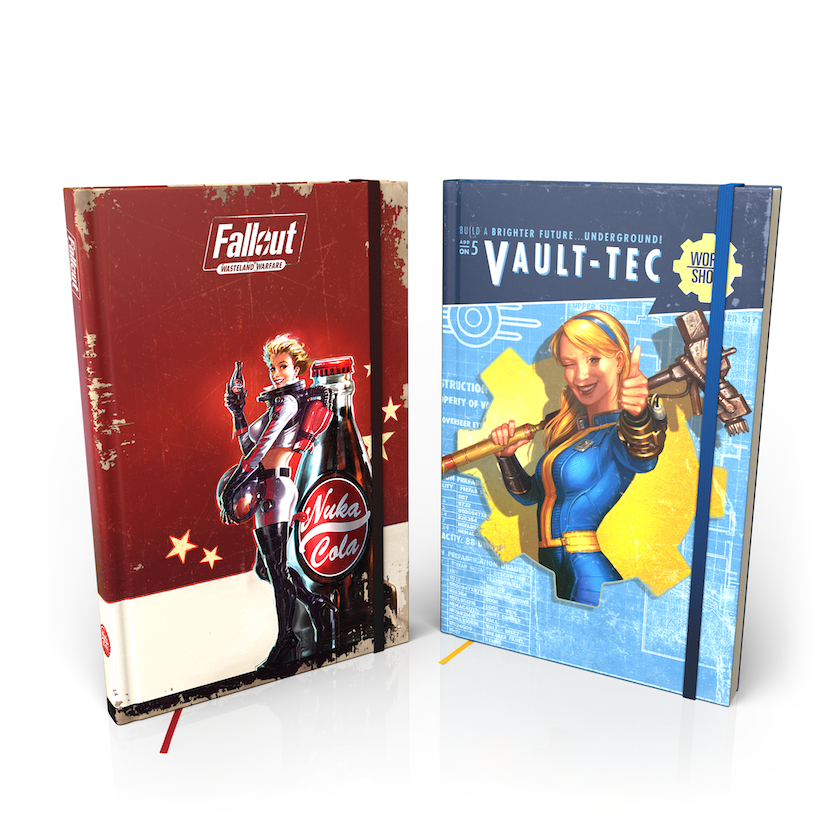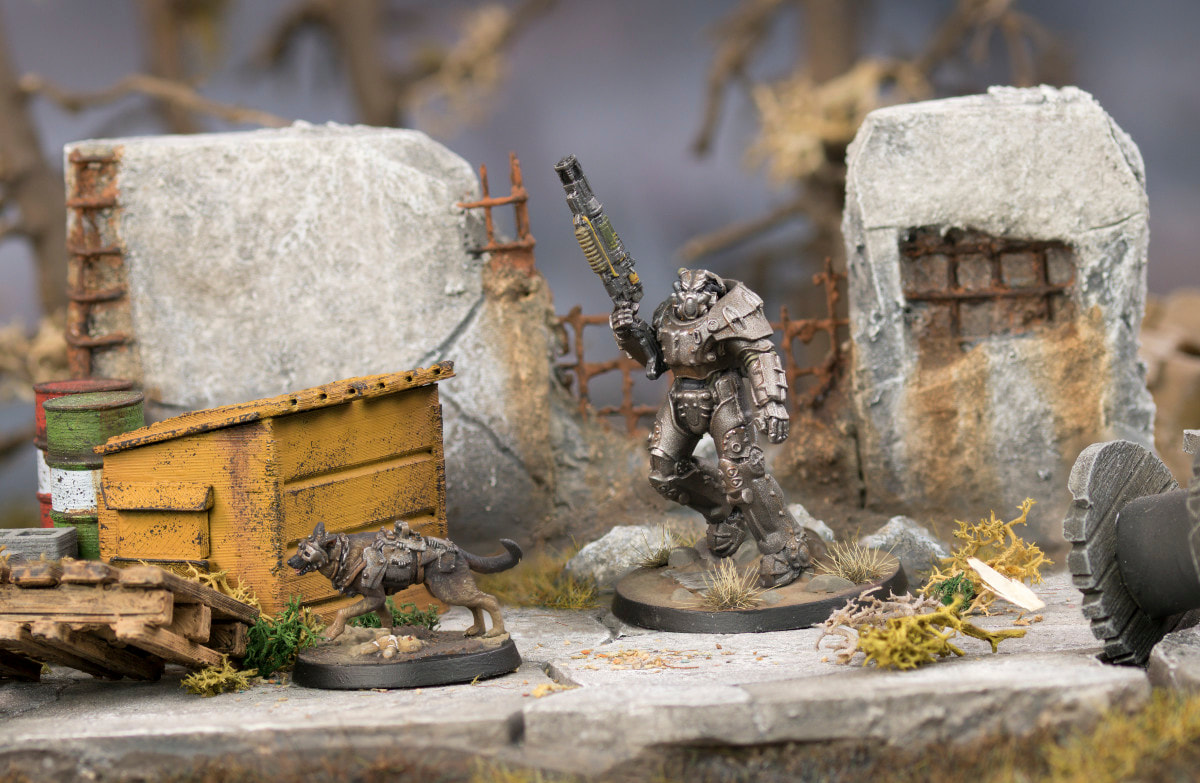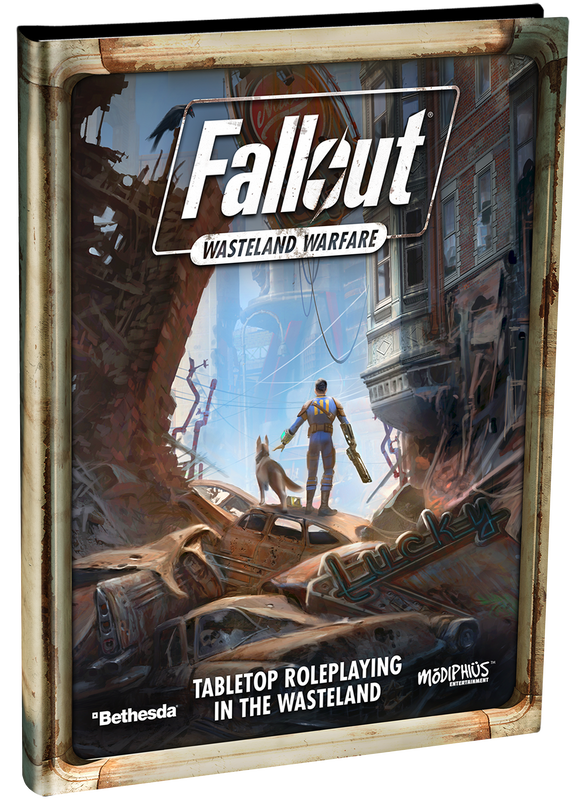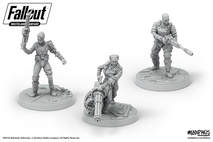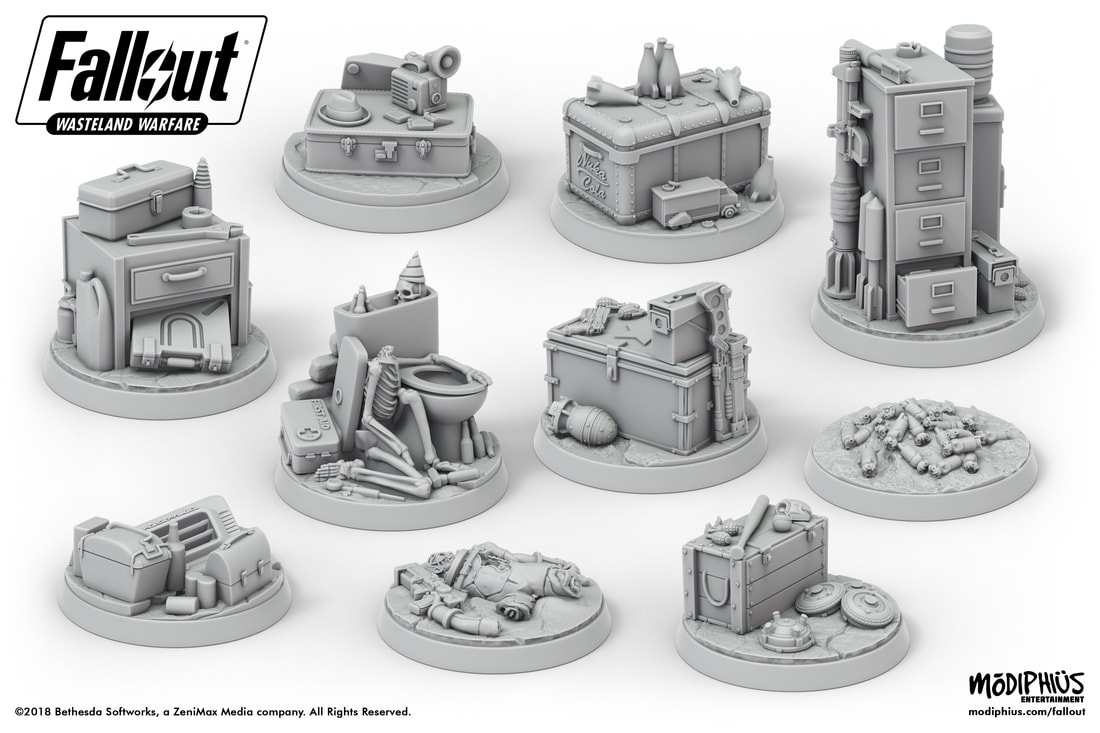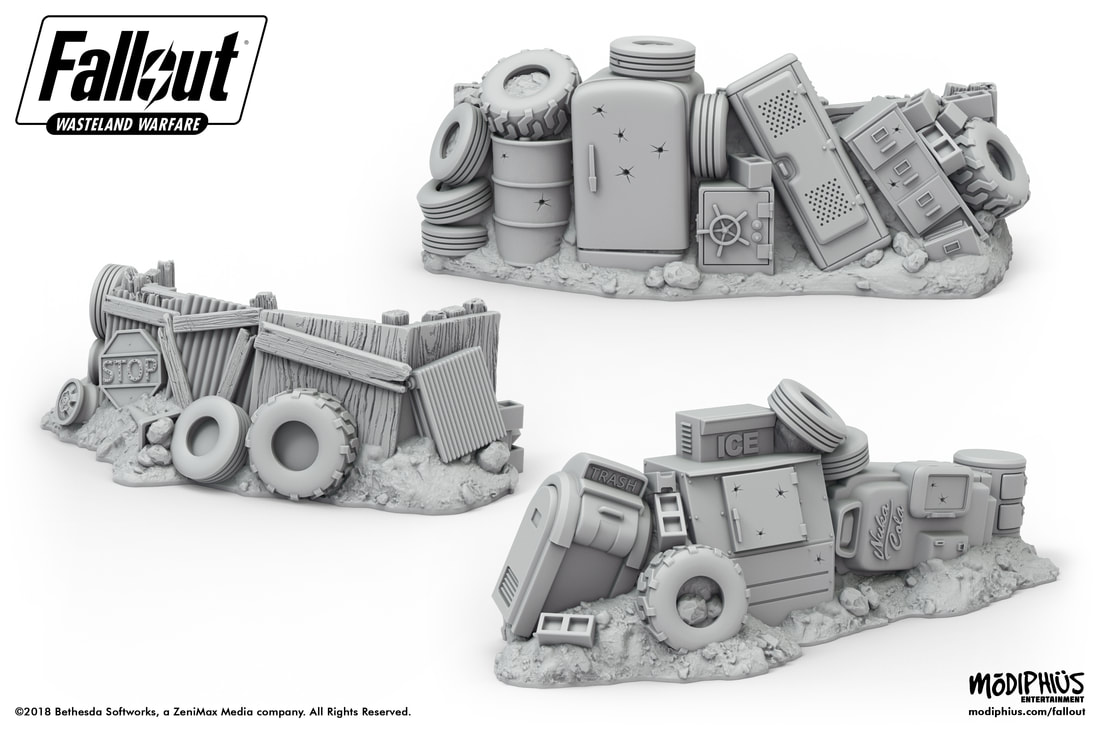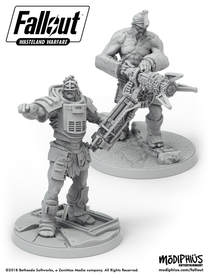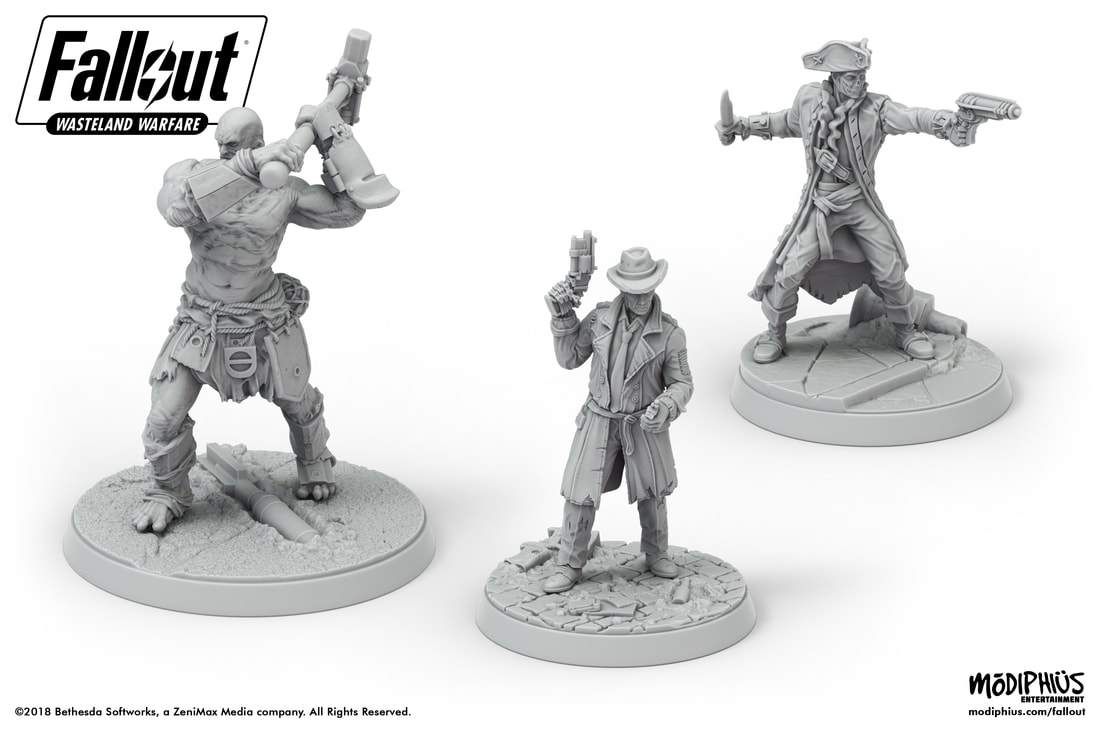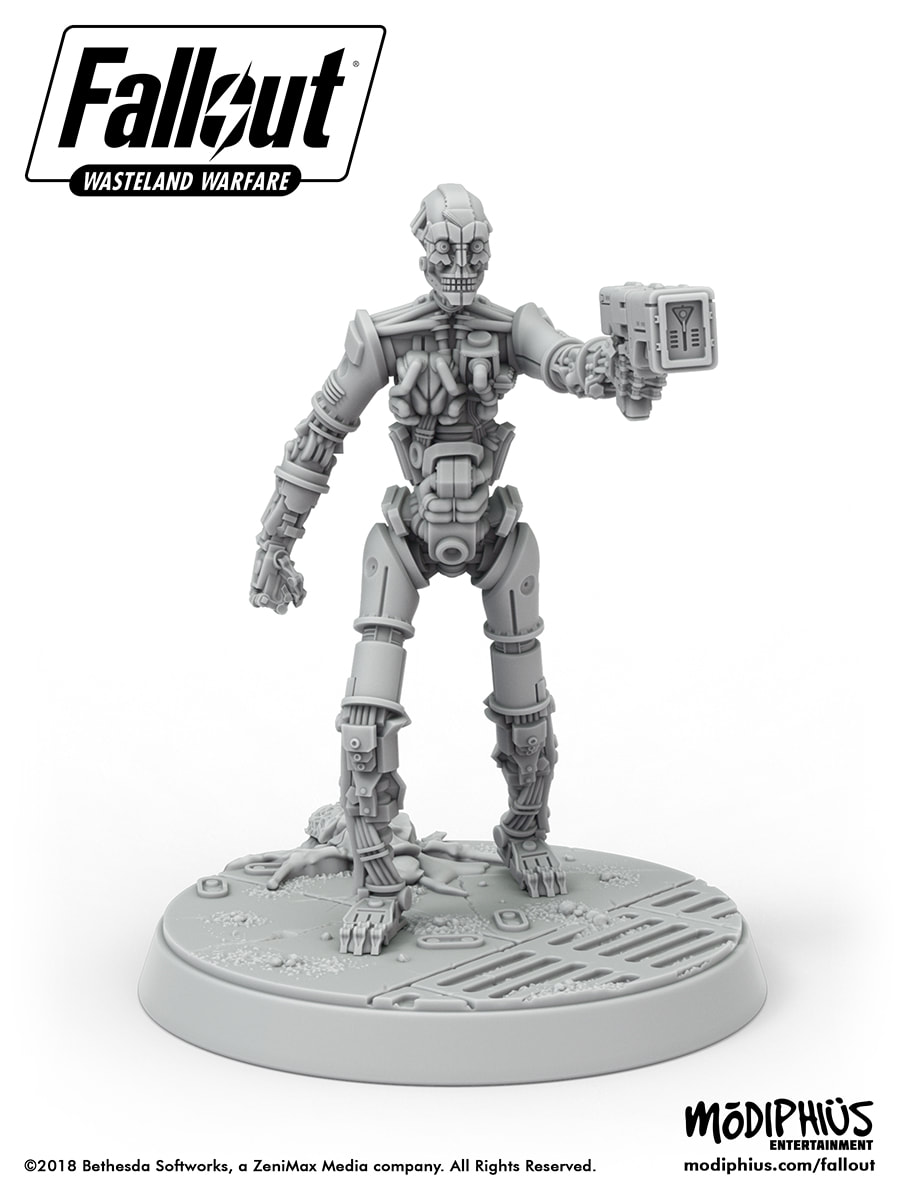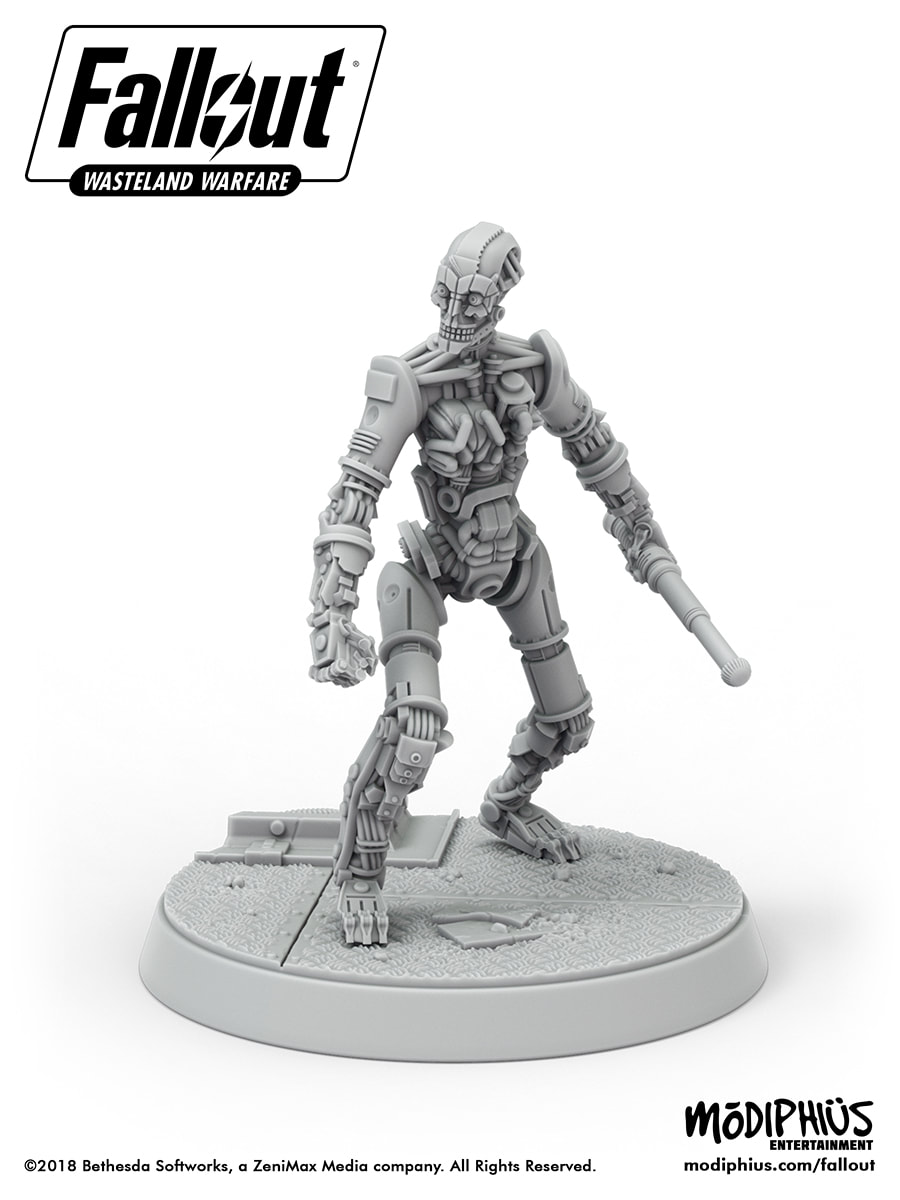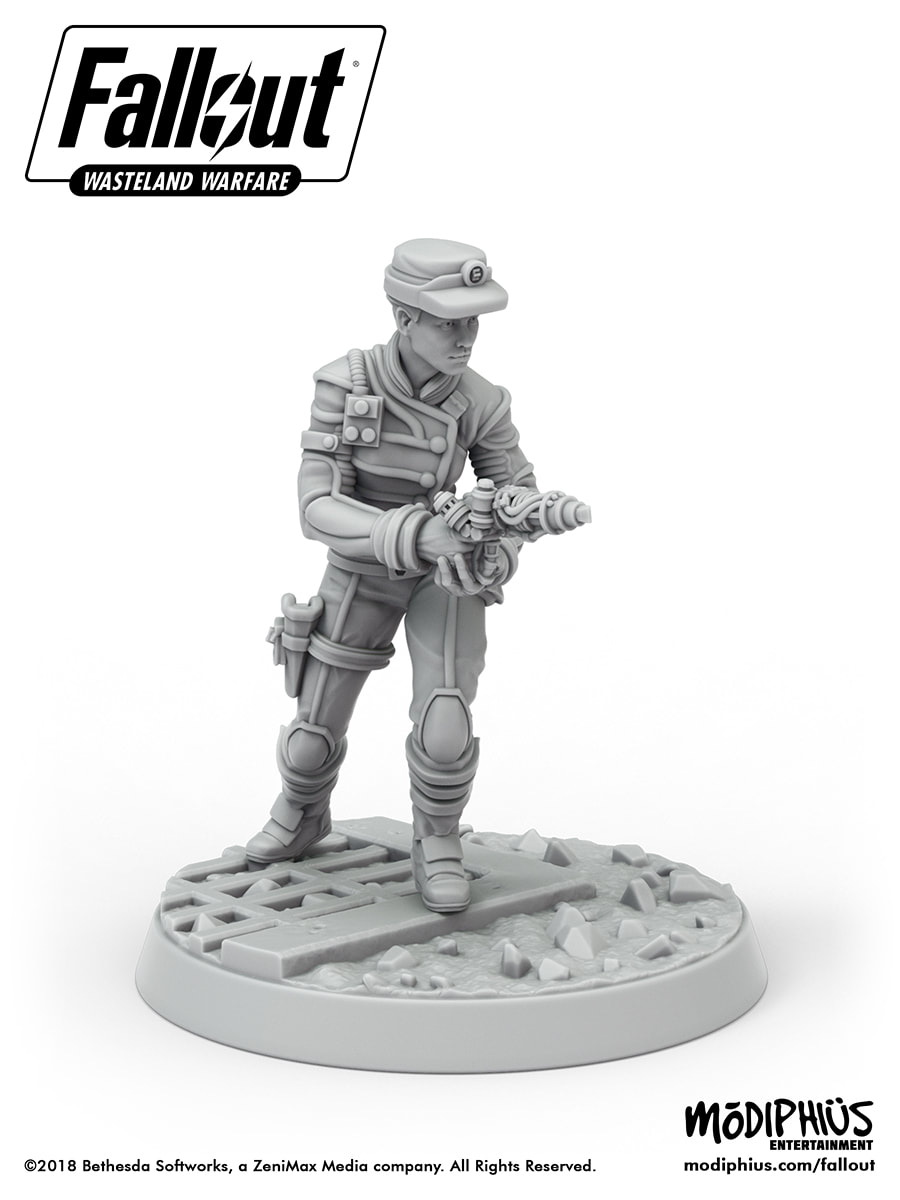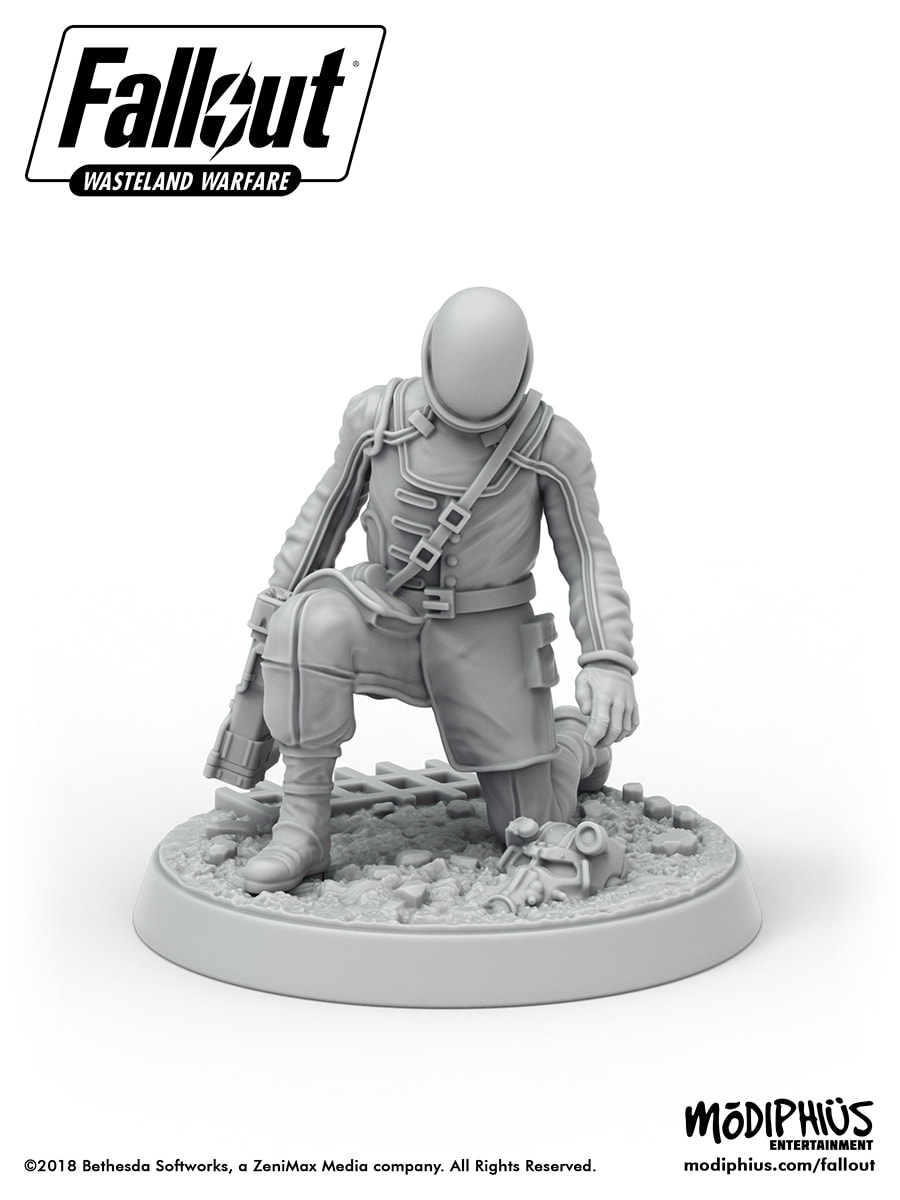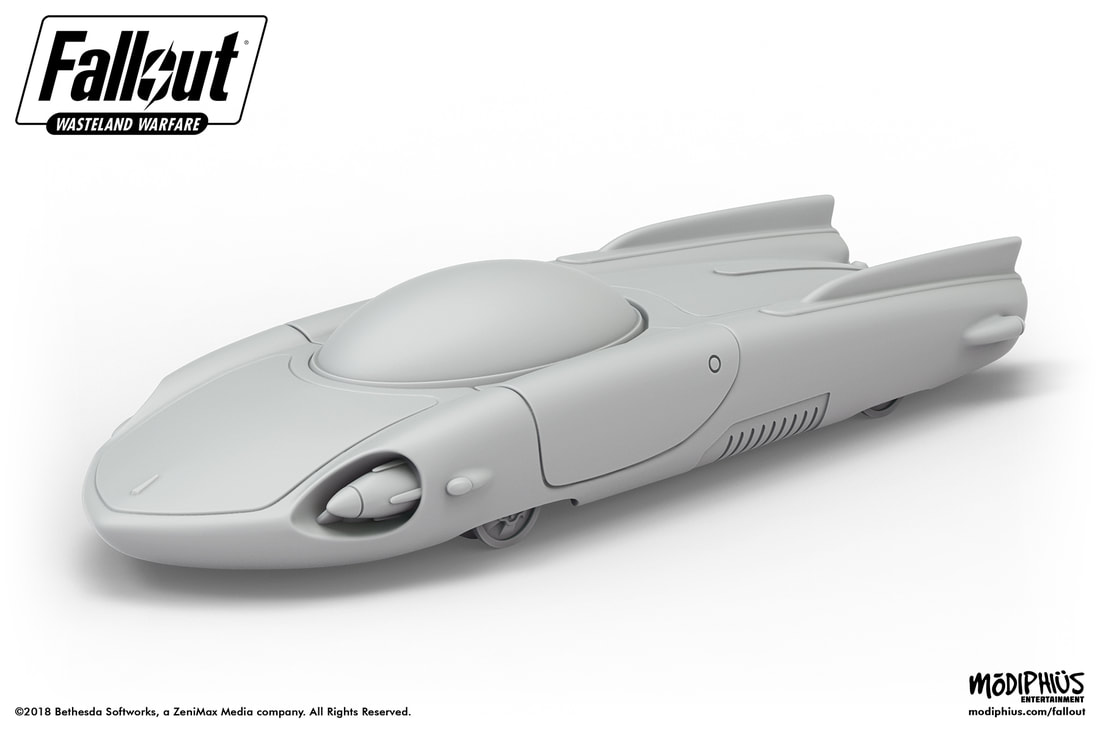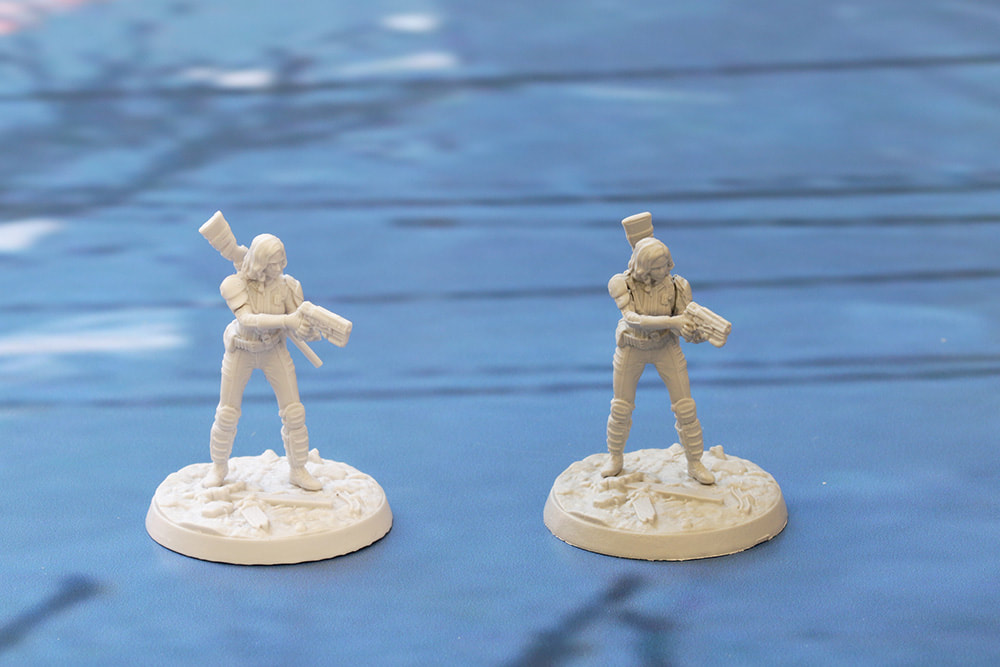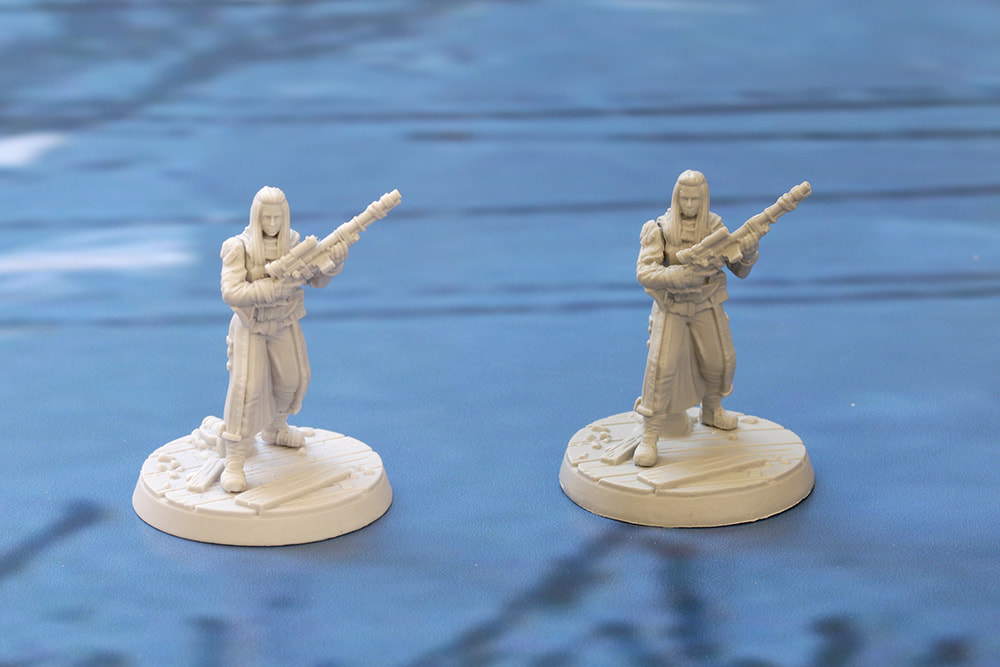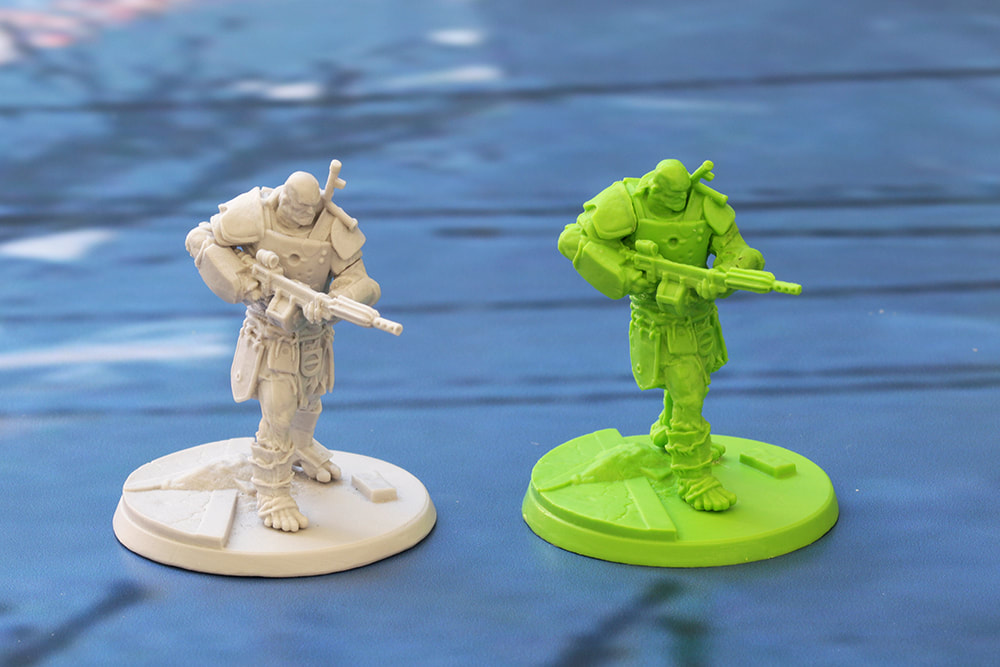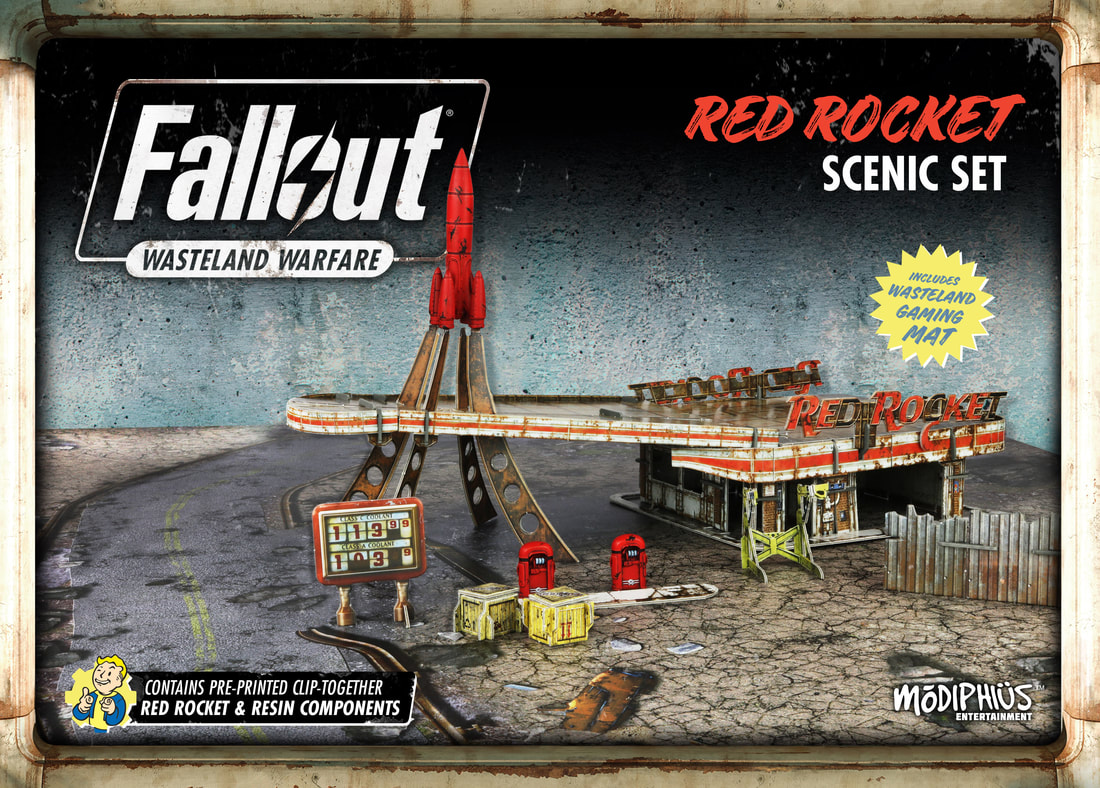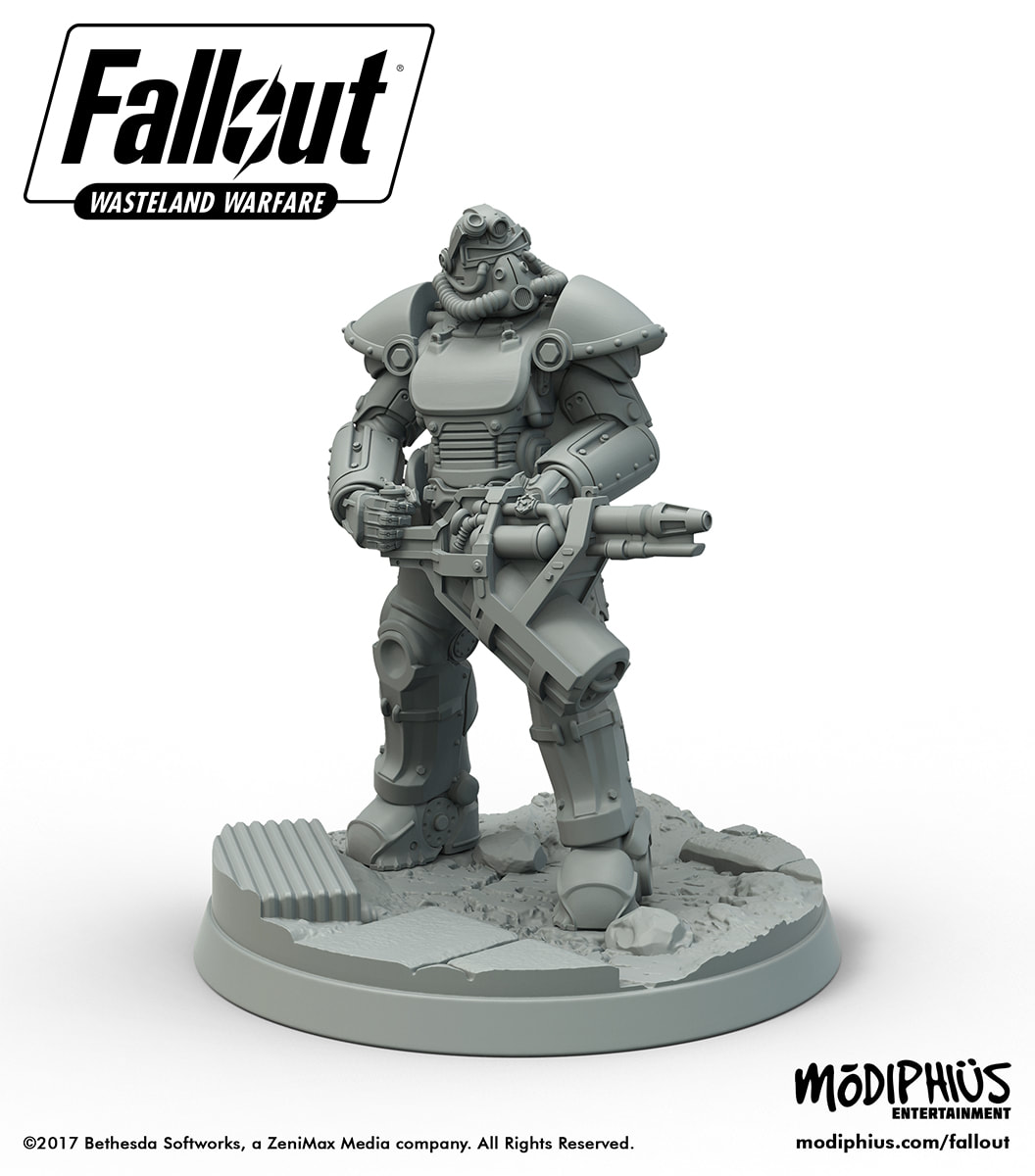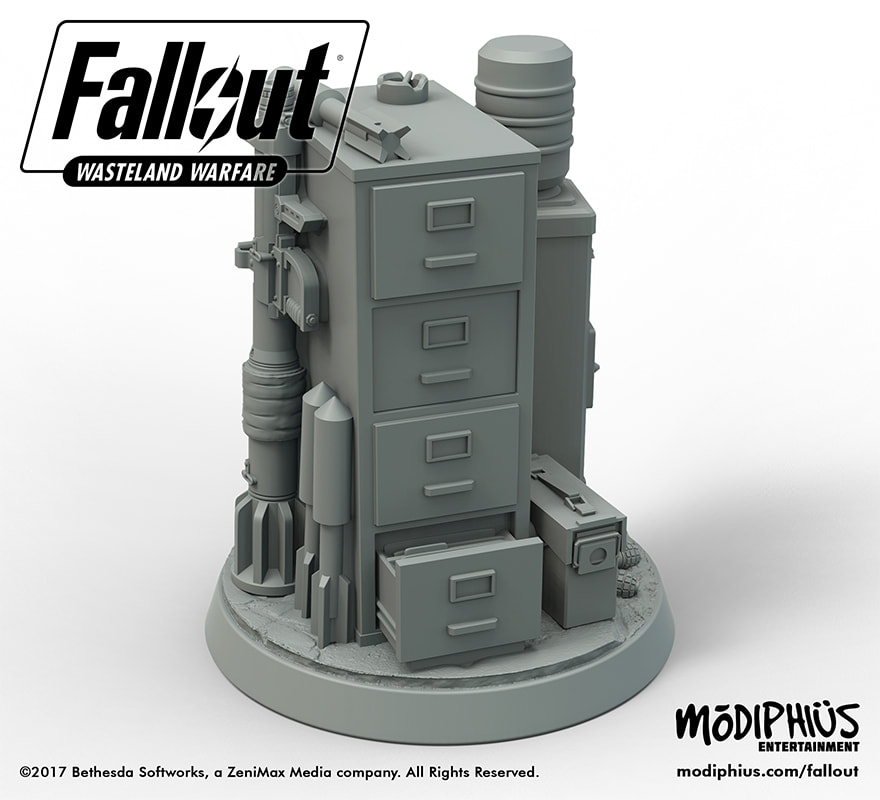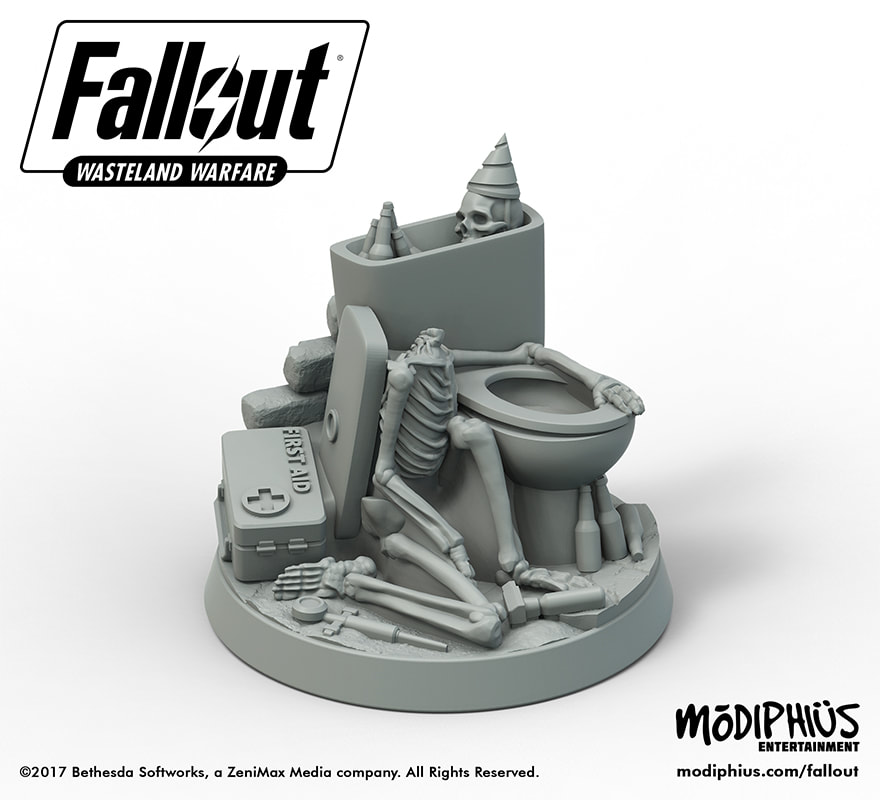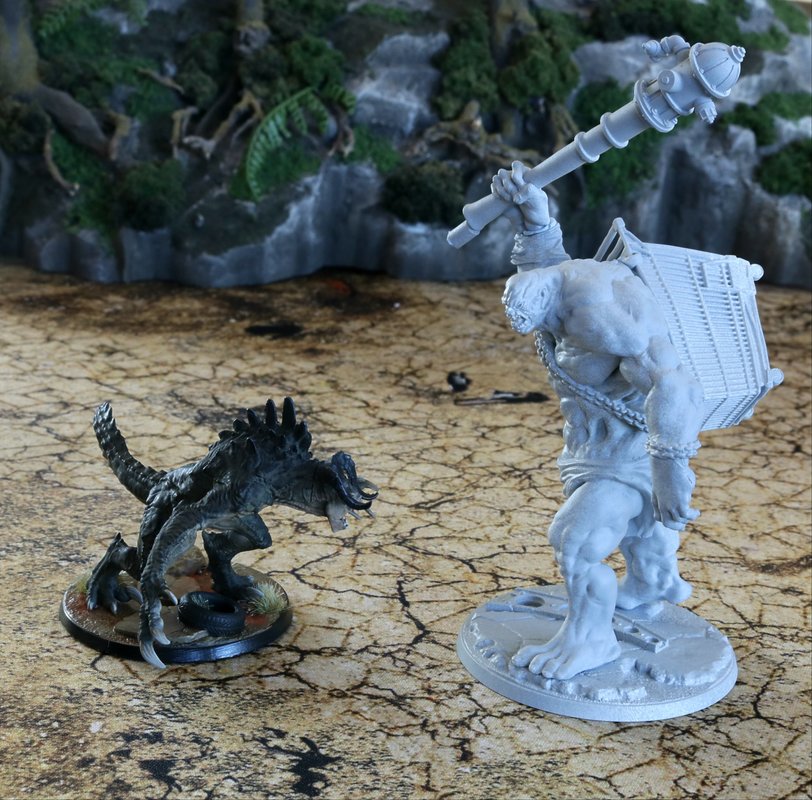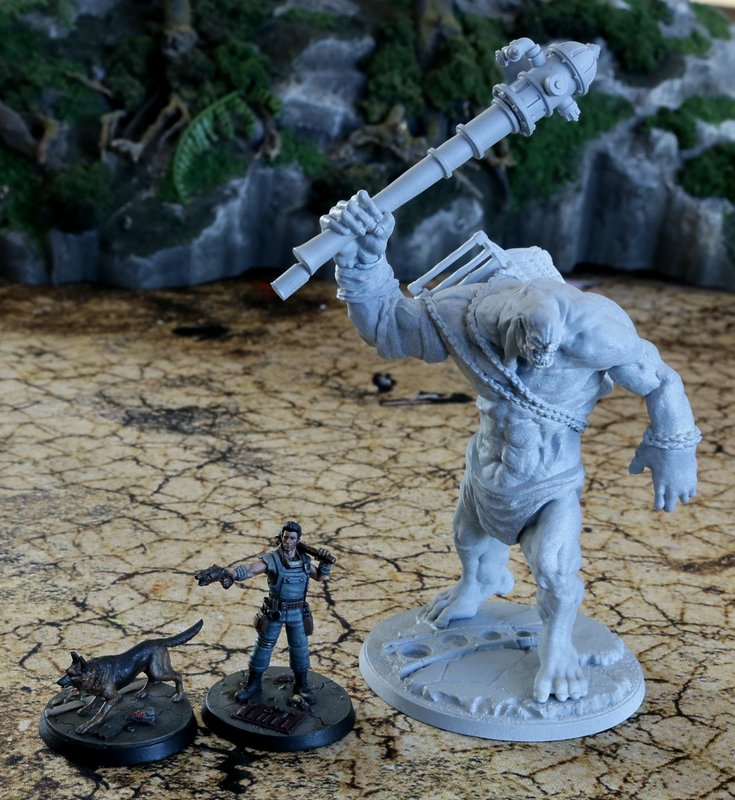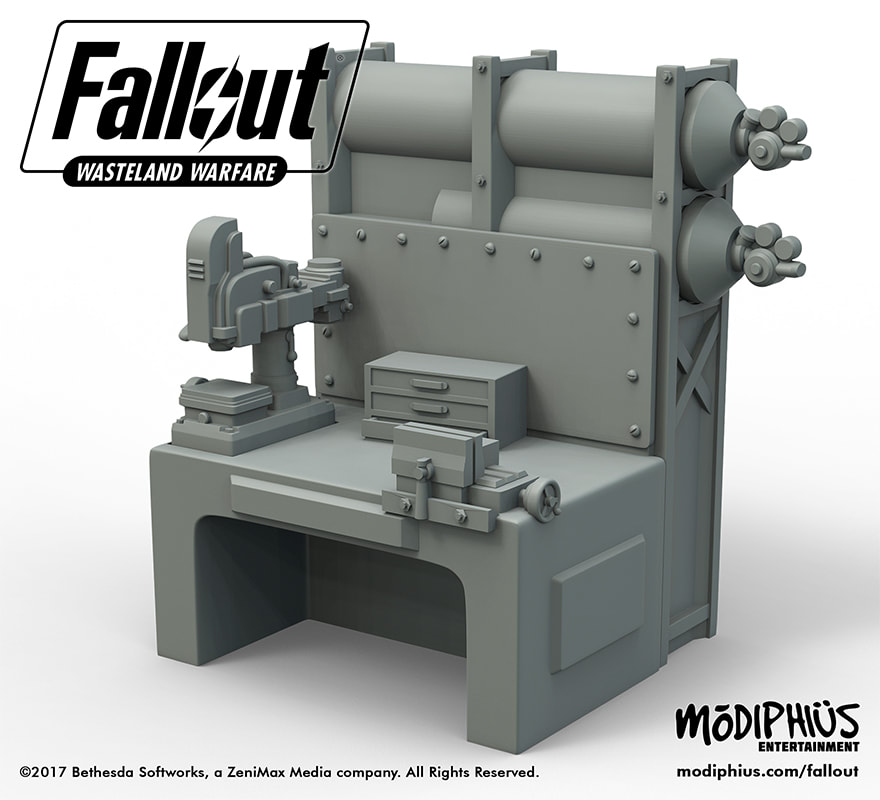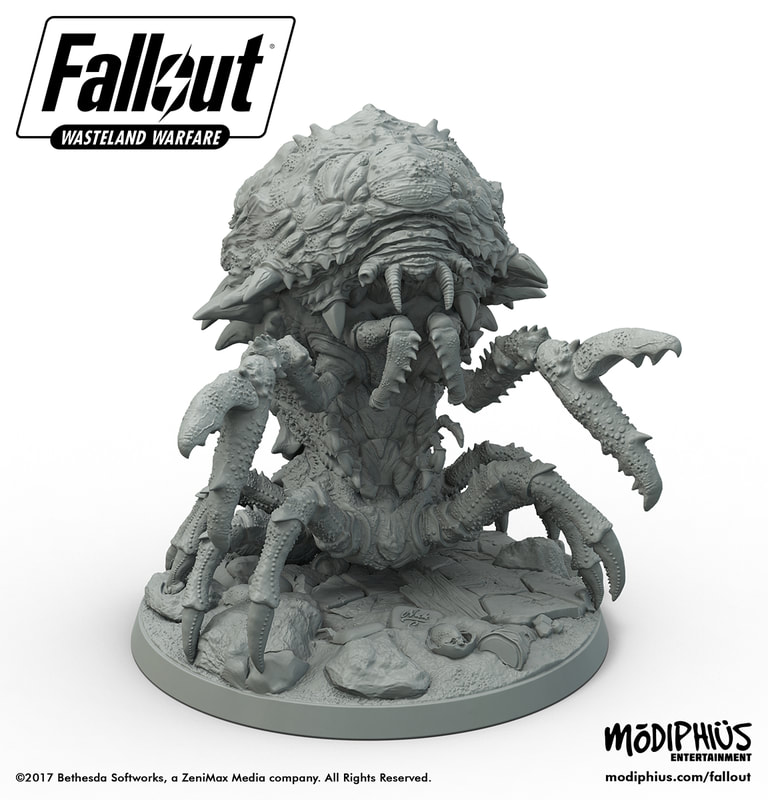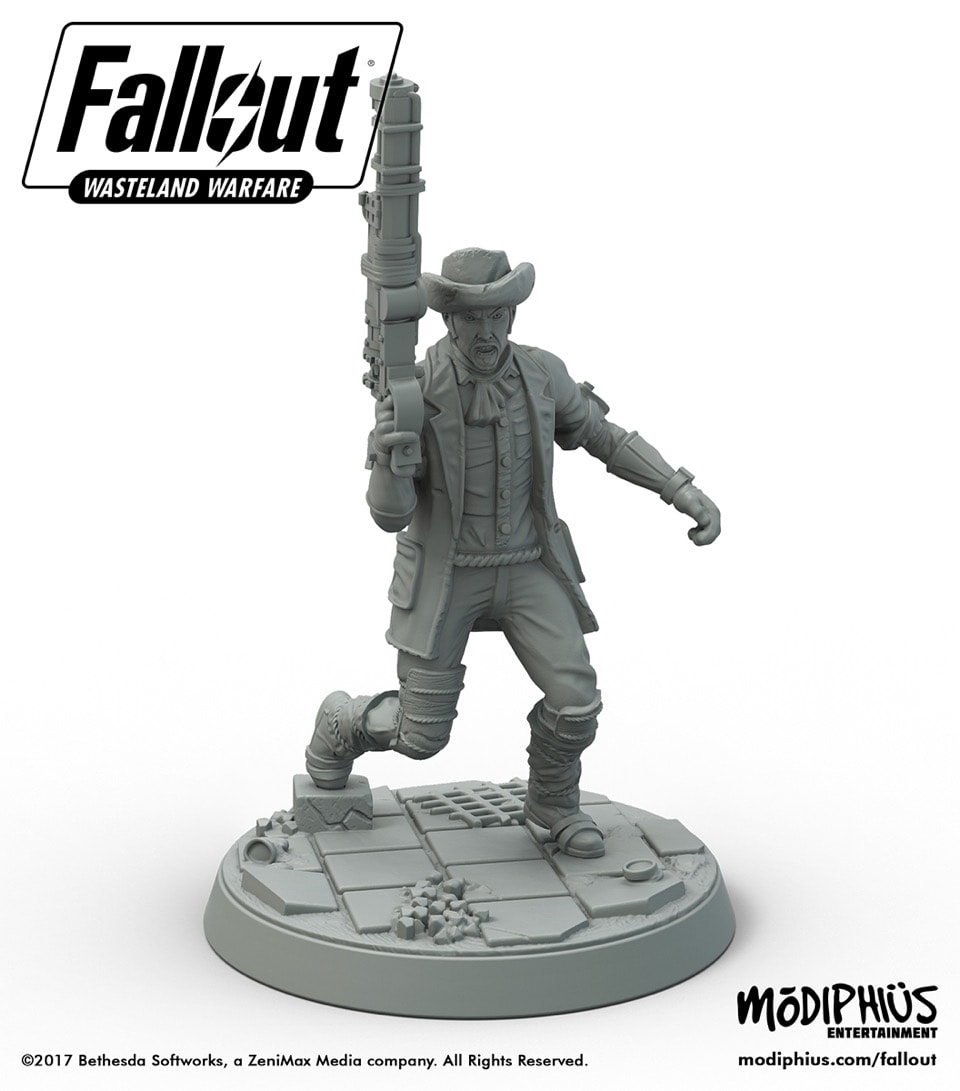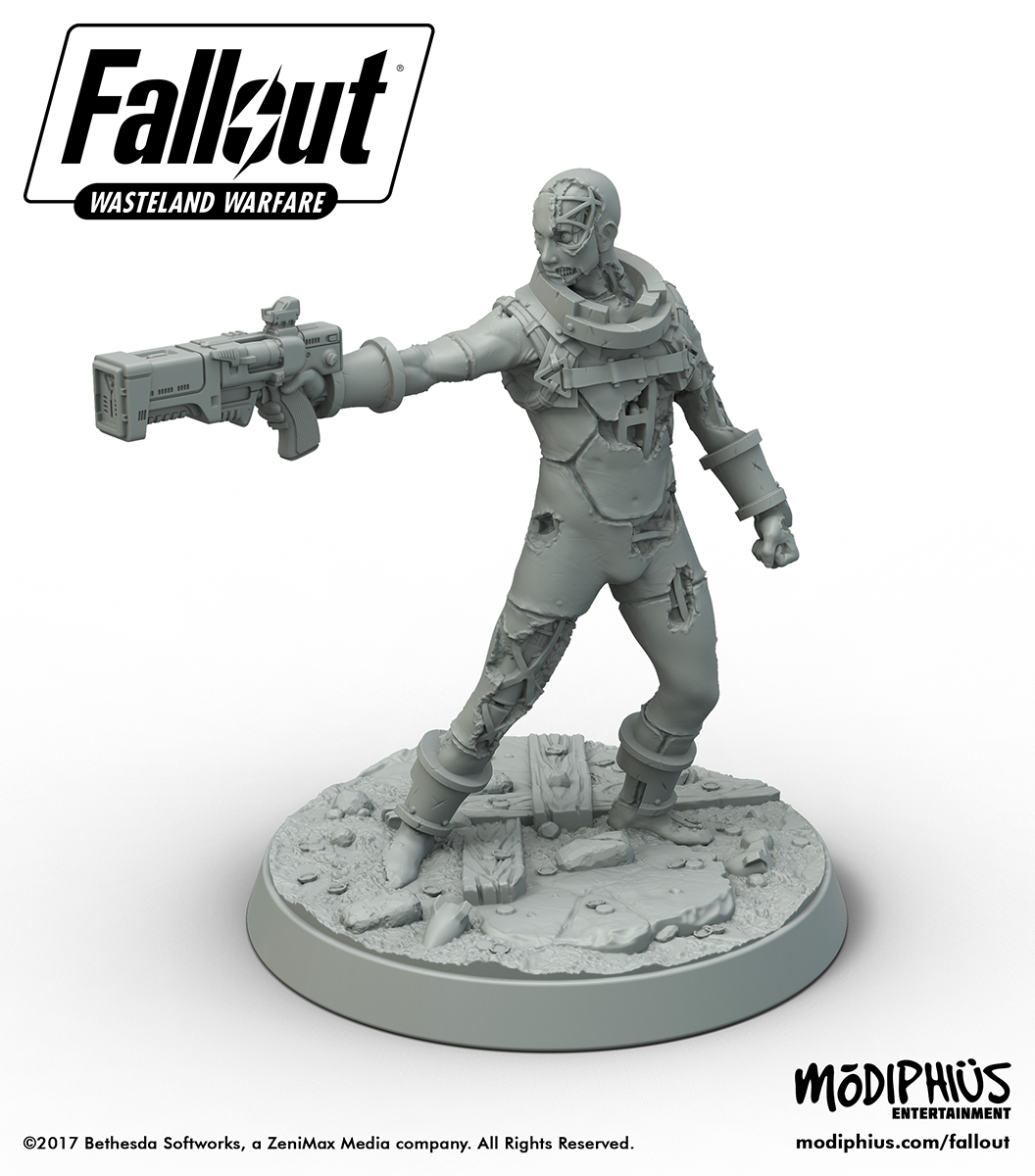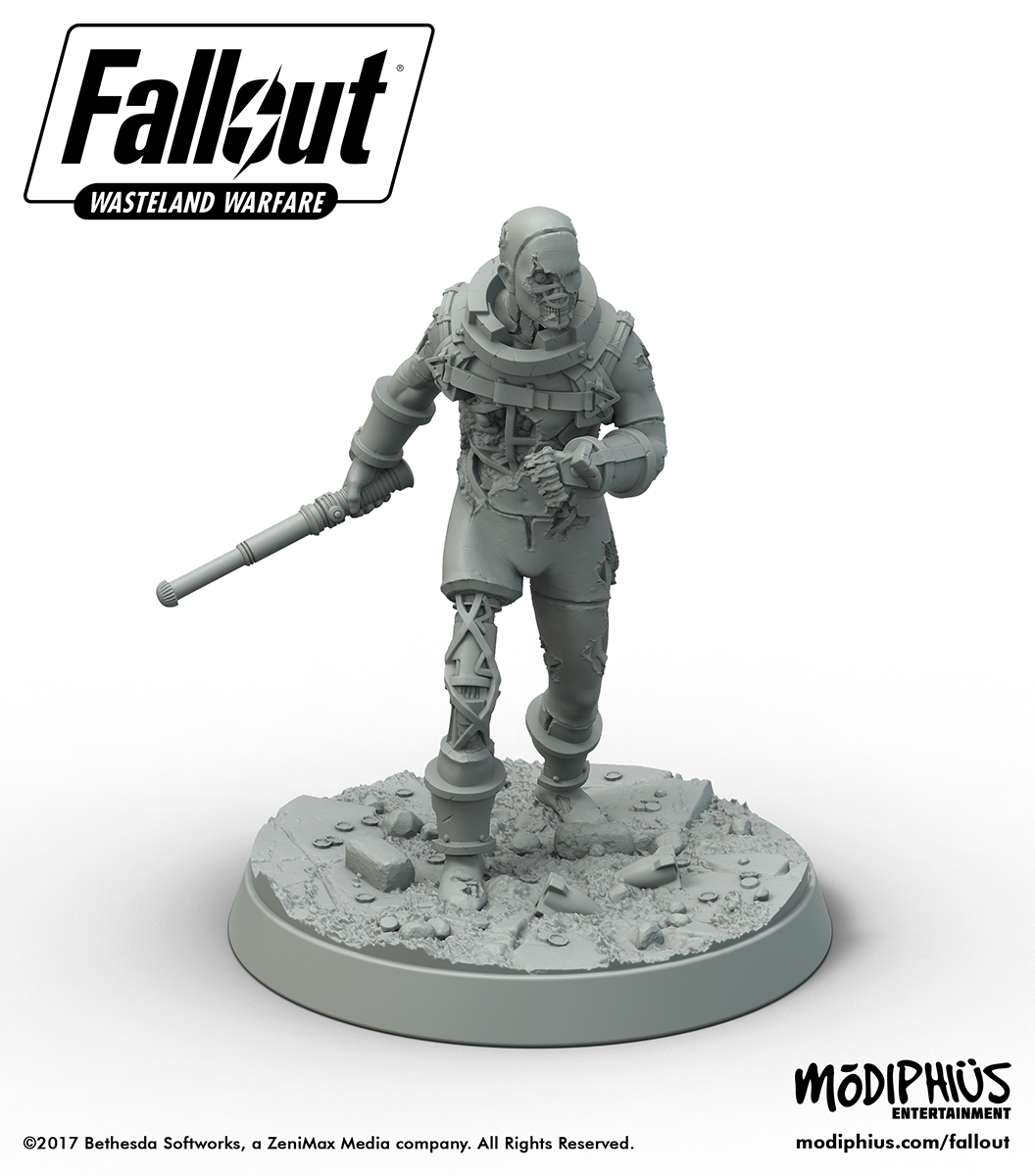FALLOUT: WASTELAND WARFARE
|
DEVELOPMENT BLOG #28: HE'S MORE MACHINE NOW THAN MAN
|
Wave 2 wrap up and wave 3 details
Head of Wargames Jon Webb returns to the blog to give details on the next few months of releases. With October right around the corner, you will shortly see the return of the Deathclaw, Feral Ghouls and Radroaches as these gribbly creatures return to store shelves and the webstore. Of course, they are not alone, bringing with them some new additions in the Glowing Ones and Mole Rats. Those of you who have picked up the Raiders Wave card pack will have seen a preview of what is coming for the creatures, with new profiles for some of the wave 1 releases as well as the cards to bring these welcome additions to the faction to battle. For those of you missing the Radscorpion, don’t worry. They will also be returning to the store shortly. As well as wave 2, no doubt you are all keen to see what we have planned for the next few months. Part of our recent efforts have been working with production to ensure we get regular releases for the game, and keep things in stock as much as possible. The plan has been to get monthly releases, ideally of at least two products hitting on the second Friday. So far, barring the slight hitch in the USA with the X01 set, wave 2 has gone to plan. So, wave 3 is going to follow along starting in November right?… right…ish… Due to the vagaries of global shipping and dare I mention the dreaded Christmas period, things are going to be slightly out of sync over the next few months, but don’t worry there will still be plenty of Fallout goodies coming. Launching in late Q4 will come the Institute Wave. Featuring the familiar Core, Character and Trooper expansion, once again this wave features all unique sculpts. There will also be the supporting card pack and if you pick up the bundle then you will also get the Mechanist which is our timed exclusive promo figure for wave 3. December is going to be a little quiet, as distribution and shipping close over the festive period. So, there won’t be any new products releasing in December. Things kick off again in January, with the long teased Settlement Workbenches and two Objective Sets for those of you who prefer nice scenic sculpts over cardboard tokens to fight over. February sees Wave 3 continue with the Super Mutants getting a boost with two new leaders (Fist and an Overlord) bringing some serious firepower to the table, as well as a pack of new close combat focussed Super Mutant Skirmishers. March then has a new pack of Unusual Allies for the Survivors. These less than human companions give new options to your force. Also emerging into the sunlight are the Vault Dwellers, both civilians and the security forces that (allegedly) look after them. Also released that month will be the T51 Power Armour set. Containing three sets of Power Armour all with different weapons, this set will allow you to toughen up your troops, no matter what faction you play (well, except the Super Mutants… sorry Fist). Rounding out Wave 3 will be the Brotherhood of Steel packs in April. The Order of the Shield are the armourers of the Brotherhood, bringing repair abilities and new T60 sculpts to bring order to the wasteland. ~ Finally, Elder Maxson arrives to lead his troops to battle, with both a power armoured and foot version of the model, as well as his trusted officer Kells to give even more options when building lists. Anyone that has been with us since wave one should appreciate some new reinforcements and new profiles to flesh out their armies. Anyone who hasn’t picked up any of the initial three factions, now’s the perfect time to start building a new force. SYNTHETIC LIFEFORMS DETECTED... With the admin dealt with, lets go over to Fallout Wasteland Warfare designer James Sheahan for a catch up about what to expect from the Institute. The Institute was one of the first factions I created when originally designing the game along with the Super Mutants and Brotherhood of Steel, so it’s great players will soon be able to play them. It’s important that each faction has its own feel, so I considered how the Institute was different. Comprised primarily of synthetic humans, I wanted to create units that conveyed a solid, unshakeable, almost inevitable force with little capability within themselves for imaginative flourishes. As a result, few units have special abilities, the Synth units are immune to battle cry, have normal speeds (as they just get the job done slowly but surely), and their physical toughness is portrayed by having slightly less armor than other units but with higher health. The skeletal-looking Gen 1 Synths are more terrifying in their appearance than their capability - serving as the rank and file for the Institute, they are okay at shooting which is a little better than their melee, but their threat comes from their quantity. The Gen 2 Synths - Patroller and Trooper - are much more capable than the Gen 1 Synths: The Patroller is a light unit suited to hunting down and retrieving or stopping targets with excellent Search, good rifle/pistol skills and high health, but with less armor than other Synths. The Trooper is a capable combat soldier with good melee as well as shooting (including heavy weapons), better armor than Gen 1s, and slightly higher health than the Patroller. Gen 3 Synths are indistinguishable from humans - many infiltrate the human world in general, but some become Coursers specialising in tracking down runaway Synths. Their human physiology means their health is less than the hard-metallic Gen 2s, but the Coursers are highly skilled to fight, search and even pick locks; however, their most notable trait is their permanent Stealth Boy rendering them almost invisible. The Institute includes some specialist and unique units. The Scientist and Engineer are both quick across the ground (partly due to having little or no armor) and are weak combatants; however, the Scientist has excellent Computers skill, whilst the Engineer has a lesser but broader ability in all the expertise skills and can even repair Synths on the battlefield. Two unique Synths are A-2018 (a solid, armored, heavy weapons expert) and Z2-47 (a Courser slightly more suited to hand-to-hand combat). Last but not least is all-round bad news Conrad Kellogg whose Cybernetic Pain Inhibitor means he gains an extra dice on his next attack when he takes damage. For equipment, their weaponry (unsurprisingly) includes Institute Laser Rifles as well as the Institute Laser Pistol which is new to Fallout: Wasteland Warfare. Kellogg’s Pistol is a heavy-hitting beast which also gives any model wielding it the ability to use Criticals too - the pistol’s critical effect gives the wielder an action point which works especially well with Kellogg himself allowing him to potentially shoot again. Last and by no means least is one of my favourite weapons in Fallout: Wasteland Warfare: the Institute Relay Grenade. When these grenades land, they do not cause damage but, instead, immediately spawn a Gen 1 Synth in that location. Adding new Gen 1 Synths to the table at just the right moment/location (and without them being targets on their way to get there) can really change your fortunes - potentially, an appearing Gen 1 Synth can immediately engage a model which could limit its actions, like preventing it from hacking a computer or shooting at a target. Of course, protecting carriers of these grenades is important to ensure they get to use them. Overall, the Institute has a varied array of capable units as well as lower cost units too. They are a no-nonsense force with few special abilities making them simple to play. One slight weakness is that they are more susceptible to energy damage than regular damage, and another is most do not have lockpick skill. |
DEVELOPMENT BLOG #27: WAVE 2 DOCUMENT UPDATES
What’s New for Fallout: Wasteland Warfare?
Wave 2 - also called the Raiders Wave as it includes the release of the Raiders as a faction has launched. To accompany this launch we have updated a number of files on the website as well as added some new supporting material.
With so much content coming your way, we asked James Sheahan (designer of Fallout: Wasteland Warfare and the Fallout: Wasteland Warfare RPG expansion) to give us some details about all the new and updated files in the Downloads section.
https://www.modiphius.com/fallout-downloads.html
With the Wave 2 models and cards finally released, not only are the card PDFs for Wave 2 now available but there’s a new series of linked scenarios both for player versus players games and for players playing solo or co-op versus the AI too. There’s also a new FAQ as well as revised cards, card list, and more.
Let’s quickly go through what each new file is and what it provides you.
Wave 2 Linked Scenarios
https://www.modiphius.com/uploads/1/4/0/6/14062642/foww_the_beast_of_the_bottling_plant.pdf
A new campaign of 5 linked scenarios – The Beast of the Bottling Plant – has been created which utilises much of the new content in Wave 2. On one side are the Raiders who are looking to establish themselves in a new region by taking over a bottling plant - set to resist them are the locals who know any permanent Raider base will be bad news. The outcomes of each of the first 4 scenarios affect the next scenario as well as the finale too.
Suggested forces are provided to get you playing straight away, but you can also use your own forces of any faction if you wish. Suggested Wasteland Decks (Events, Dangers, Stranger, Creature, Items) have been provided too to thematically match the cards in the Wasteland to each scenario.
Players playing solo or co-op games against the AI can also play through the campaign as every scenario includes AI settings. Settings are provided for both sides too so players can play through as the Raiders or the Locals, or even play it twice - once as each side.
You can watch Twitch videos of Modiphius developers Ethan and Charlie (and Giles) playing these scenarios on YouTube now: https://www.youtube.com/watch?v=qfiJlWv1Lus&list=PLE8gwC4Miwd2cvNsDZTq-LqXqQvVa_UC0
Wave 2 Cards
As Modiphius announced previously, models no longer come with cards from Wave 2 onwards – this change allows for a faster and more reliable manufacturing process so new products are released more often and existing products remain in stock. From now on, each new wave will include a separate card pack which provides all the cards required for all the models in the wave as well as many more like AI, Quests, Explore, Events, Dangers, etc. Being able to buy all the Wave 2 cards in one pack means players can experience all the content of Wave 2 regardless of which models they purchase; plus, players of the RPG can expand their games easily too.
As with all waves, all cards in Wave 2 which have a cost (Units, Weapons, Items, Leaders, etc.) can be downloaded and these are now available. (The other cards without like Events, Dangers, AI, etc. are only available in the physical card deck.)
As well as new Items like the Gauss Rifle and Raider Power Armor, a few cards of note in Wave 2 are the Robot Controller and Creature Controller Leader cards. These allow almost any model to lead a force consisting entirely of Robots or Creatures. These are just the minimum required to do so, and Robot and Creature forces will be greatly expanded in Waves 3 and 4 too, but we wanted to allow players to field Robot or Creature forces now rather than wait.
Wave 2 cards also contain weaker versions of some creatures and robots from Wave 1 such as the Battered Assaultron and Young Deathclaw. These cards are for use with the existing models and allow players to use these inhabitants of the Wasteland more often as they have a lower cost. Conversely, there is a more dangerous version of the Radroach Swarm too – the Glowing Radroach Swarm – so Radroaches are not always a pushover.
Also, there are new reference cards which update the rules for Robots, Creatures and Dogs too.
FAQ v3
The new Fallout: Wasteland Warfare FAQ provides lots of new information as well as some updated rules. As F:WW is a living game, the FAQ also includes a table of every revised card – see Wave 1 Card Changes below.
https://www.modiphius.com/uploads/1/4/0/6/14062642/foww_errata_faq_v3.0.pdf
Wave 1 Card Changes
Some cards from Wave 1 have been revised – most of these changes are minor or superficial corrections so do not have a noticeable impact on gameplay, but there are two particular card changes players should be aware of. One is that Dogmeat, Dogmeat Scout and Dog have had their AGI reduced slightly to make them slightly less formidable, and the other is that X6-88 is no longer considered a Robot as he is a Gen 3 Synth so indistinguishable from humans. (More on Synths in Wave 3...)
As you probably know, all cards from Wave 1 which have a cost (Units, Items, Weapons, Mods, etc.) are available for download for free. This allows players to print additional copies of cards. All the existing downloadable Wave 1 card files on the Downloads page have been updated so they now include all the revised cards.
For players that just want to see all the revised cards in one place, and so you can print them all out without needing to print unchanged cards, all the revised cards can be downloaded as a single PDF too.
https://www.modiphius.com/uploads/1/4/0/6/14062642/wave_1_errata_cards_v1.pdf
Settlement Sheet
A new structure has been added to Settlements, called Lockers, which allows a player to retain items which they are not equipping for a battle but would still like to have in their pool after the battle when they next use their Settlement, rather than have to sell them off. Also, the cost of the Ranger Outpost has been altered from 500 to 100.
https://www.modiphius.com/uploads/1/4/0/6/14062642/settlement_sheet_v2.0.pdf
Full Card List
Since just after the game was launched, a list of every card and which cards were with which products has been available in the Downloads section. With cards now being released separate to the models, a new card list has been created which describes all the cards in the new products including Wave 2. The pre-July 2019 card list is also still there as reference for players who have products from Wave 1 that had cards accompanying them.
https://www.modiphius.com/uploads/1/4/0/6/14062642/fallout_-_full_card_list_-_pre-july_2019_v6.pdf
https://www.modiphius.com/uploads/1/4/0/6/14062642/fallout_-_full_card_list_-_july_2019_onwards_v1.pdf
Points/Caps Costs
As well as providing costs for all new Units, Items, Leaders, etc. in Wave 2, the costs of all existing cards have been fully reviewed and updated where necessary to further balance the game. If you have existing lists of forces, double-check you’re using the latest points values.
https://www.modiphius.com/uploads/1/4/0/6/14062642/foww_item_and_unit_costs_v2.2.pdf
Battle Mode and Force Lists
Battle Mode is a way of playing Fallout: Wasteland Warfare intended for organised play as it removes most of the narrative and random elements. The rules for Battle Mode have been revised, a Force List for Raiders has been added, and the other Force Lists have been updated too with new cards from Wave 2 and any updated costs.
Note that the Force Lists are only for Battle Mode and the limitations they add are not used when playing the game in its normal way.
RPG FAQ v1
https://www.modiphius.com/uploads/1/4/0/6/14062642/fww_rpg_errata_faq_v1.pdf
An FAQ has been released for the Fallout: Wasteland Warfare RPG. As well as some questions and errata, it provides some detailed advice experience points (how much XP to award, when and how to award it, etc.), as well as providing suggested equipment for the NPCs in the Introductory Scenario.
Phew – as you can see it’s been a busy time. It’s great the next phase of F:WW is now being released and the existing files are updated. No time to rest though as we have lots of really exciting things planned for new models in the next waves as well as new scenarios and content for player versus player and solo/co-op versus AI too.
The Raiders Wave Models and Card Pack are available to purchase from the Modiphius site and will be in retail from the 9th August.
DEVELOPMENT BLOG #26: LIMITED GENCON (& WEB) SPECIALS!
|
"What's that Dogmeat? Something glowing?"
GenCon is coming! With but a week until Chris, Sam, Jon and Adam make their way over to Indianapolis for the Best Four Days in Gaming, it’s time to pull back the curtain on what to expect from us at the show. The Raiders have emerged from their bases and are now attacking settlements across the Wasteland. If you haven’t yet picked up your Raiders bundle yet we will have a small amount of the Raider boxes and Raider wave card packs at the show. We'll have our own bit of the wasteland in Hall G, Booth #2569 so come find us! For those who haven’t yet dipped their toes into the game, we will have a show exclusive offer, allowing players to pick up a 2 Player core set, one of the existing Faction Core, one Faction Trooper Expansion and one Faction Character Expansion at a great bundle price (note this doesn’t include the Raider boxes). Fans of Grognark can also grab one of our Dragonborn Triumphant miniatures for our forthcoming Elder Scrolls: Call to Arms game as a handy stand in (or if you want to get the drop on the game and get ahead with your painting). Anyone paying attention to the Fallout Friday Twitch stream will no doubt have noticed the “glowing” Glowing Ones used as part of the wrap up to the Raider season. We can now reveal that they will be sold throughout the four days of GenCon, both on the stand and also via our webstore for those unable to attend the show (so if you can't make it to GenCon make sure to visit our store during the show and you can buy one). The Glowing Ones will also be accompanied by a set of Institute Coursers, all of whom have activated their Stealth Boys. Those paying attention will of course realise the Institute has not yet made their presence felt in the Wasteland so this the first chance to get your hands on two of the three models in this set. Again, these will be available online as well as at the show. Those who are at GenCon, don’t forget to check your Coupon book, as anyone spending over $20 at the booth on Fallout goodies will be able to pick up one of these Nuka Cola bottle objective markers for free (while stocks last)! |
CLICK ON THE IMAGES TO ENLARGE!
|
DEVELOPMENT BLOG #25: The Raiders are here!
|
The Fallout: Wasteland Warfare game is expanding to introduce many more factions from across the Fallout universe. For the first major expansion coming to retail from August (we call it wave 2) we're introducing the Raiders and you can read more about them below.
We've made a limited number of Raider Wave 2 bundles available in advance which include the three Raiders sets, the Wave 2 card pack described below and the special promo Mysterious Stranger (who'll be available on his own in Wave 3). These are ready to ship for those who want to jump in and gets you a saving of £26 / $33 on the MSRP. Otherwise you'll be able to pick up the individual items in in your local store or our webstore from August 9th. As wave two approaches, we touched base with some of the team behind the game to get their input on what to expect from the releases. With the wave release beginning in August, it won’t be long before you can introduce the Wasteland to roving bands of Raiders, as well as add some new options to your Creatures, Robots and Survivors. We sat down with Wasteland Warfare’s designer, James Sheahan to talk about the new profiles and cards in the card pack as well as some of the mechanics that will be coming to the game that are previewed in this wave. James - Designing the Raiders One of the biggest new elements in Wave 2 is the Raiders - bands of thuggish survivalists who take what they want and with little regard for others. Whilst the average Raider may be less skilled than most, they have decent armor as standard and can quickly charge into close combat – effectiveness over subtlety. Due to their illicit activities, almost every Raider knows how to lockpick which makes them suited to a wide variety of objectives. Within the Raider ranks are Scavvers who are excellent shots, and Psychos who are skilled at close combat and are fast so long as they do not wear any additional armor. The combination of these types makes the Raiders’ rank-and-file a force offering great flexibility for combat. The alternate versions of the Raiders, such as the Raider Outlaw, are slightly less capable than their standard counterparts but have computer skills and the ability to use Action Points for Expertise skills, making them perfect for non-combat objectives. Of course, the Raiders are not just a crew of manpower but also include talented individuals. The Veteran Raider is a grizzled, highly capable warrior, sometimes wearing custom-made Raider Power Armor – whilst not quite up to T-45 standards, it still makes for a strong and tough target. Shady and deadly ghoul Sinjin, heavy weapons specialist Ack Ack and sharp-shooter Avery are also very skilled and tough unique Units each with their own abilities. Wave 2 also brings the Sole Survivor Tech who is great with computers and Dogmeat Guard Dog who wears tough armor and may even take damage on behalf of a friendly nearby model. Good boy/girl! Inside Wave 2 are some iconic Fallout items such as X-01 Power Armor – rare and expensive but also incredibly tough – as well as weapons such as the Junk Jet, Railway Rifle, and Gauss Rifle which can be charged over time to deal greater damage. New creatures include Putrid and Bloated Glowing Ones – some of the toughest inhabitants to be found (or preferably avoided) in the wasteland - as well as the widespread scourge, Mole Rats. In addition, some new, weaker versions of existing robots and creatures are included in Wave 2 such as the Battered Sentry Bot and Young Deathclaw. These slightly less formidable versions allow players to encounter these robots and creatures more often, and their lower caps values (some less than half their normal value) makes it easier to include them in a force. Players wanting to create a force of robots or creatures will be able to do so using new Leader cards (Robot Controller and Creature Controller) which allow one model to lead an entire force of their chosen minions. This concept will be expanded in Wave 3 with the Automatron Deck (alongside the Institute release) which will allow a player to give their robot minions many extra abilities, and/or have the leader exert their control over them, and even add The Mechanist as their leader. Creatures will be similarly expanded in Wave 4. The Controller Leader cards are provided in Wave 2 in advance of these expansions as we know players have already expressed their desire to lead such forces. In addition to all of that, Wave 2 expands players’ Fallout: Wasteland Warfare games with many new items, mods, quests, perks, leaders, and explore cards, as well as cards to further add variety to your wasteland with new creatures, dangers, strangers and events. All the cards for Wave 2 are contained in the Wave 2 Card Pack so all players can have access to all this content regardless of which models they purchase. A free campaign of 5 linked scenarios specifically designed for Wave 2, containing AI settings for solo/co-op play will be available for download. Following that, departmental head Jon Webb had some thoughts about the models that are getting released. Jon The Raiders Wave, as we know it internally was a pretty special one for me as it contains the first released set of models I briefed with the various Raider poses we added to the initial seven sculpts previewed way back in the mists of time. Amusingly, these were not the first batch of briefs I have done, but due to the vagaries of release waves and production schedules, the Raiders get to shine before anyone else (hold out for Wave 3 for more of my “babies”). One of the things I was keen to push was not repeating sculpts. Given the Raiders are the most “swarmy” of the various factions in the game, they needed a decent number of models to ensure no two were the same. I was particularly proud of the sack hood Raider and getting to put some nods to the Fallout 4 concept art with the two extra Scavvers. Luigi, one of our sculpt team did a superb job with the briefs and I’ve had great fun building a number of pre-production copies for my own purposes (oh, and playtesting too... ) I just need to find some time to paint them. The other cool thing that we managed to sneak in to the wave was the extra profiles for the Robots and Creatures. James did a great job running with that, allowing players to build a more varied Robot force and hopefully make use of all the Assaultrons that will be booting up and looking for poor survivors to laser come September. That’s only the start of his plans for the Robots too… Wave 3 has something special for players looking to rule the Wasteland with a force of implacable steel. Hope everyone enjoys what we’ve put together here and it won’t be long before Wave 3 arrives, with the Institute coming to the surface looking to rebuild as well as more troops and profiles for the wave 1 factions. We had a chat with our studio painter Adam Huenecke, who painted every model in wave 2, about his experience prepping them for the boxes and promo shots we rely on to show how awesome the figures are. Adam - Painting the Raiders The Wave 2 miniatures were some of the most fun to paint- The raiders, glowing ghouls, and X-01 Power Armor are some of the most iconic characters in the series. They allow for lots of grime and weathering that allow you to have fun and get sloppy (and have the results turn out even more realistic). I’m not a huge fan of “paint formulas,” because they are only as good as what you do with them, but I can share the colors I used for the primary elements and perhaps that can help folks get good results on their own stuff. I’ll explain everything in terms of four elements- Base Coat, Shadow, Highlight, and “Special Effects.” Base Coat- The first main color you can ‘block’ out your colors with. In most cases, I’ll color out each of my basic elements in their ‘Base’ color before I do any shading or highlighting. This can help you plan out your overall scheme and get a feel for what the miniature will look like when you are finished. Shadow- These are the colors that will add depth to your base coat. These are typically a darker, richer tone than your base color. You can often add these colors as a thinned wash or a careful addition to the areas where shadows would naturally fall. Highlight- This is the color that you will use to make your colors ‘pop’ by adding a little additional light. These are typically a brighter version of the base color and should go on the surfaces that light would hit. Special Effects- These are the extra additions that give your color scheme a little more realism. They can range from rust, slime, glowing effects, or anything else to give your model a little more drama. Raider Armor Base Coat: Reaper Blackened Steel Shadow: Scale75 Petroleum Grey (Note- this is one of my favorite post-apocalyptic paints. It’s a great dark grey/brown that can add a gritty feel to nearly anything. I often use this in my airbrush to shade my terrain as well). Highlight: P3 Pig Iron / P3 Cold Steel Special: Rust- P3 Bloodstone (thinned). I don’t know what it is about this paint, but a well-thinned P3 Bloodstone, with perhaps a bit of glaze medium added, makes an amazing ‘wash’ for a realistic rust effect. When it dries, it tends to separate a bit into a flat orange/brown effect that tends to pool in all the right places. Play with this a bit and you won’t be disappointed. Works great in an airbrush as well. Raider Leather Base Coat: P3 Bloodstone Shadow: P3 Umbral Umber Highlight: P3 Bootstrap Leather Raider Cloth Base Coat: P3 Greatcoat Grey Shadow: Scale75 Petroleum Grey Highlight: P3 Bastion Grey Causasian Skin Tone Base Coat: P3 Beast Hide Shadow: P3 Battlefield Brown Highlight: Reaper Tanned Highlight Special: Blush- P3 Khardic Flesh- A thinned down Khardic Flesh (a pinkish tone), with a little acrylic drying retarder added X0-1 Power Armor Base Coat: P3 Pig Iron Shadow: Scale75 Petroleum Grey Highlight: P3 Cold Steel Glowing Ghouls Base Coat: P3 Necrotite Green Shadow: P3 Thornwood Green (This was less of a shadow, and more of the color that I used for the darker hands and feet) Highlight: P3 Cygnus Yellow (mixed with base color) Special: Radioactive Glow- Vallejo Game Color Fluorescent Green, via Airbrush. I applied some of this extra glow to the model with an airbrush, which gives it a glowing look (and makes it glow under blacklight!) Ethan and Charlie - Playing the Raiders Playing Raiders is wildly different from playing with any of the existing factions in Fallout: Wasteland Warfare. They are a group that prefer brawn over brain, Chems over Charisma and numbers over tactics. They can throw enough bodies at a problem to overwhelm most enemies, and have the speed to run away if the fight doesn’t go their way. Wherever there are Settlers desperately working to survive the desolate wasteland, there will always be Raiders nearby searching for easy prey. A perfect way to begin looting the Wasteland is with the Raider Core Box containing a Veteran Raider (modelled in Raider Power Armor), 3 Raiders, 2 Psychos and a Scavver. This is a solid start to any aspiring scourge of the wasteland. In most cases, the boss in your warband will have the best equipment and in this case that Veteran Raider can throw on a suit of Raider Power Armour and lead from the front. Whilst in the Power Armour, the Veteran Raider gains access to the strength bonus from being STR 7+, so load them up with a Melee Weapon that packs a mean punch or a Heavy Weapon that can fire with deadly accuracy. As much as they would like to be able to, the boss can’t do everything on their own! Make sure they have some backup, such as allowing the Veteran Raider to use a nearby friendly model as a Meat Shield. Raider units are well rounded and can fit into many roles, be that long range support with a Rifle or up close and personal with a Machete. Where the Raider faction really comes into its own is with its specialised bands of Psychos and Scavvers. Load up a Psycho with a Melee Weapon and a ton of Throwing Weapons and watch your opponent panic at the fast moving whirlwind of chaos tearing its way across the battlefield. Scavvers on the other hand are the workhorses of the faction, able to reliably provide long range support. If you’re in need of someone a little more suited to objectives than fighting, the Outlaw variants of all 3 basic Raider units sacrifice a small amount of agility to gain a large boost to intelligence, along with the skills to hack into any terminals in their way. There is always the choice of bringing along one of the infamous Raider bosses for the ride. Ack Ack, Sinjin and Avery are the paragons that all Raiders aspire to be, if Raiders have aspirations that is. If you feel that your Raiders aren't killing enough, fast enough; Ack Ack and her Minigun are an excellent addition to your force. Even better, if you activate other models in the same turn as her, Ack Ack’s Bullet Storm ability allows them to hit even more often. Sinjin on the other hand prefers the careful approach. Unlike his crew, he can’t throw out a lot of damage, but he can do it reliably. The free Silenced Mod fitted to any Pistol he brings means you have a good chance to not trigger any enemy models waiting in ambush. Finally you have Avery, an expert in exploiting the enemies Weak Point, allowing her to turn a blank face on a black dice she rolls into an Armour Break. Load her up with a Combat Shotgun and watch as she tears through the ranks of any force that dares stand up to the might of your Raider warband. In addition to all these great units and abilities, make sure you stock up on a load of Chems. For Raider faction models, the final round of an active Chem lasts one additional round. Load up on Fury and dish out devastating damage in melee, take some Overdrive and charge up that critical attack even faster or pop some Orange Mentats to steady your aim whilst waiting in ambush. Follow Ethan and Charlies Raider games on Youtube - Episode 1 here. So, get out there and make me some Caps! |
|
DEVELOPMENT BLOG #24: Fallout: Wasteland Warfare - Scenario Competition!

As we approach the release anniversary of Fallout Wasteland Warfare, and now the launch of the RPG expansion, we wanted to give all you budding writers who've been experimenting in the wasteland with your sets, a chance to show your skills and maybe even be rewarded for your talent!
We are running our second Fallout: Wasteland Warfare design competition, this time focussing on scenario and adventure writing!
There are two categories for the competition
1) Fallout Wasteland Warfare Scenario
Entrants must submit either a single scenario (this can be Narrative, Solo, Battle Mode or Co-Op, bonus points if it works for multiple modes) playable in 2 hours or under.
2) Fallout: Wasteland Warfare Roleplaying Game Adventure.
A single one shot roleplaying adventure with at least three story phases of which one must make use of miniatures, playable in 4 hours or under.
Modiphius will review all entries and shortlist the ones they feel best represent the game. These will then be uploaded to the website and our community can vote on the winner of each category!
No entry can win more than one category, but entrants are free to enter each category once (ie Scenario and Adventure). We will accept your first entry only for each category, so make sure you submit the right version of your document. All documents must be submitted in PDF. If you want to include maps or diagrams, include them inside the PDF. Entrants must wholly create their work. We will reject entrants who plagiarise other’s text, however you are allowed to include names, locations, adversaries, events and characters from the Fallout universe. Submissions will not become cannon but are designed to encourage the community to create awesome fun content for each other to enjoy.
Each category will have one winner that receives $250 of credit to spend on the Modiphius webstore, with three runners up prizes of $50.
Entrants must use the form below to submit their entry by midnight Pacific time, 31st August 2019. We'll announce the short list by the end of September for voting. This should give you all enough time to get creative.
*Vault Tec would like to remind entrants that this is a family vault and entries should be suitable for all ages. Any entry not deemed suitable will be disqualified.
** Full terms and conditions can be found at https://www.modiphius.com/tcs.html
Get cracking survivors!
We are running our second Fallout: Wasteland Warfare design competition, this time focussing on scenario and adventure writing!
There are two categories for the competition
1) Fallout Wasteland Warfare Scenario
Entrants must submit either a single scenario (this can be Narrative, Solo, Battle Mode or Co-Op, bonus points if it works for multiple modes) playable in 2 hours or under.
2) Fallout: Wasteland Warfare Roleplaying Game Adventure.
A single one shot roleplaying adventure with at least three story phases of which one must make use of miniatures, playable in 4 hours or under.
Modiphius will review all entries and shortlist the ones they feel best represent the game. These will then be uploaded to the website and our community can vote on the winner of each category!
No entry can win more than one category, but entrants are free to enter each category once (ie Scenario and Adventure). We will accept your first entry only for each category, so make sure you submit the right version of your document. All documents must be submitted in PDF. If you want to include maps or diagrams, include them inside the PDF. Entrants must wholly create their work. We will reject entrants who plagiarise other’s text, however you are allowed to include names, locations, adversaries, events and characters from the Fallout universe. Submissions will not become cannon but are designed to encourage the community to create awesome fun content for each other to enjoy.
Each category will have one winner that receives $250 of credit to spend on the Modiphius webstore, with three runners up prizes of $50.
Entrants must use the form below to submit their entry by midnight Pacific time, 31st August 2019. We'll announce the short list by the end of September for voting. This should give you all enough time to get creative.
*Vault Tec would like to remind entrants that this is a family vault and entries should be suitable for all ages. Any entry not deemed suitable will be disqualified.
** Full terms and conditions can be found at https://www.modiphius.com/tcs.html
Get cracking survivors!
DEVELOPMENT BLOG #23: Fallout: Wasteland Warfare - Synergy between the RPG & miniatures game
In our final blog post about the Fallout: Wasteland Warfare RPG, we look at how the miniatures game and RPG can potentially be used together. James Sheahan (designer of Fallout: Wasteland Warfare and the Fallout: Wasteland Warfare RPG expansion) provides some details on how the two styles of game fit together and what this can deliver.
Integration
The RPG has been designed specifically so it integrates as much as possible with the miniatures game and vice versa. The core mechanics are the same. We have loosened some restrictions to allow the Gamesmaster more agency and some rules which are there to ensure balance in a two player game are not required. For example we do not have the same limitations on how many attacks a creature has in the miniature game as the GM may desire to make it more dangerous. Player characters from the RPG can be used in the miniatures game, and Units from the miniatures game can be used in the RPG (in fact, they are the GM’s NPCs). As a result, there is excellent potential to use both styles of game. Potentially, GMs can create a miniatures campaign with elements that are resolved using the RPG and vice versa. Using the miniatures game for combat during the RPG is likely to be less required as the RPG’s combat is very similar but with less emphasis on exact model position.
Expansions
As the RPG uses the same cards as the miniatures game, most new cards for the miniatures game are new content for the RPG too. (I say ‘most’ as some card types are not specifically used in the RPG, although they can be useful and we’ll look at this a bit later on.) Prior to the release of Wave 2 of the miniatures game, it was announced that the new waves of products for the miniatures game will include a card pack for that wave, containing all the cards for that wave (as no cards will come with the models). These card packs will contain further weapons, items and Units (NPCs) which can also be used in the RPG too.
Tokens and Cards
The RPG has been written without using tokens; however, players can use any tokens from the miniatures game they find useful such as to show conditions (each of which already has an icon on the character mat to use for tracking), activation tokens, Critical Points, and so on.
Whilst some types of cards are not used in the RPG, the GM can use some to trigger ideas, randomly create situations, etc. For example, Danger cards can be used to generate random dangers such as when failing a test to open a trapped lock, and Creature cards can be used to generate random creatures such as when investigating an old ruin.
Similarly, Explore cards can be used to generate minor encounters during a journey. For example, it takes 2 days to reach the outpost during which time 3 Explore cards are drawn and resolved each day. The incidents on the cards may just be a starting point for the GM who may read the card and create a larger scene around it. Event cards can be used the same way. The RPG rulebook includes some advice on how these cards can be used with the RPG.
AI and the RPG
Someone asked if the AI can be used in the RPG. It’s an interesting idea but they’re not specifically used as the GM determines all the NPCs’ actions; however, if they really wanted to a GM could potentially use the AI cards to give them some inspiration.
On a side note, I have joked previously that players could make AI cards for their own RPG character and have the GM use those if a player can’t attend a session. It made me think if no players made it to a session, the GM could still run a game with no players and just their AI :) That’s certainly not the intention and I was only joking - interesting thought though.
Until next time, happy wandering in the Wasteland. You can pre-order the Fallout: Wasteland Warfare RPG Expansion here.
Integration
The RPG has been designed specifically so it integrates as much as possible with the miniatures game and vice versa. The core mechanics are the same. We have loosened some restrictions to allow the Gamesmaster more agency and some rules which are there to ensure balance in a two player game are not required. For example we do not have the same limitations on how many attacks a creature has in the miniature game as the GM may desire to make it more dangerous. Player characters from the RPG can be used in the miniatures game, and Units from the miniatures game can be used in the RPG (in fact, they are the GM’s NPCs). As a result, there is excellent potential to use both styles of game. Potentially, GMs can create a miniatures campaign with elements that are resolved using the RPG and vice versa. Using the miniatures game for combat during the RPG is likely to be less required as the RPG’s combat is very similar but with less emphasis on exact model position.
Expansions
As the RPG uses the same cards as the miniatures game, most new cards for the miniatures game are new content for the RPG too. (I say ‘most’ as some card types are not specifically used in the RPG, although they can be useful and we’ll look at this a bit later on.) Prior to the release of Wave 2 of the miniatures game, it was announced that the new waves of products for the miniatures game will include a card pack for that wave, containing all the cards for that wave (as no cards will come with the models). These card packs will contain further weapons, items and Units (NPCs) which can also be used in the RPG too.
Tokens and Cards
The RPG has been written without using tokens; however, players can use any tokens from the miniatures game they find useful such as to show conditions (each of which already has an icon on the character mat to use for tracking), activation tokens, Critical Points, and so on.
Whilst some types of cards are not used in the RPG, the GM can use some to trigger ideas, randomly create situations, etc. For example, Danger cards can be used to generate random dangers such as when failing a test to open a trapped lock, and Creature cards can be used to generate random creatures such as when investigating an old ruin.
Similarly, Explore cards can be used to generate minor encounters during a journey. For example, it takes 2 days to reach the outpost during which time 3 Explore cards are drawn and resolved each day. The incidents on the cards may just be a starting point for the GM who may read the card and create a larger scene around it. Event cards can be used the same way. The RPG rulebook includes some advice on how these cards can be used with the RPG.
AI and the RPG
Someone asked if the AI can be used in the RPG. It’s an interesting idea but they’re not specifically used as the GM determines all the NPCs’ actions; however, if they really wanted to a GM could potentially use the AI cards to give them some inspiration.
On a side note, I have joked previously that players could make AI cards for their own RPG character and have the GM use those if a player can’t attend a session. It made me think if no players made it to a session, the GM could still run a game with no players and just their AI :) That’s certainly not the intention and I was only joking - interesting thought though.
Until next time, happy wandering in the Wasteland. You can pre-order the Fallout: Wasteland Warfare RPG Expansion here.
DEVELOPMENT BLOG #22: Fallout: Wasteland Warfare RPG - Spotlight on what's new
Previous blog posts have covered the RPG in general, the skills system and character creation. In this post, we look at a few other areas that are new to Fallout: Wasteland Warfare or different for the RPG. As ever, James Sheahan (designer of Fallout: Wasteland Warfare and the Fallout: Wasteland Warfare RPG expansion) sheds some light on these areas.
Initiative
When action occurs in the RPG, the game uses Action Play to break events into turns and rounds. To determine the order in which characters act during Action Play, the RPG uses the same activation system as the miniatures game. Each side in the scene (usually the players and the GM) take turns making one of their Unready characters Ready and then deciding whether to activate all of their Ready characters or not. This gives players lots of control over the order in which the characters act, plus it allows them to co-ordinate so they can work together such as one opening fire to suppress the enemy whilst the other makes a run for it, or lifting the broken door that’s too heavy for one character on their own. Also, having an initiative system with no dice roll means players are not frustrated by an unlucky, poor initiative roll leaving their character in a precarious position, plus using the same system as the miniatures game means all abilities and Perks that affect turn order work seamlessly too. The system also provides some mechanics the GM can use to add extra detail to a situation tool; for example, characters caught by surprise may start ‘Stunned’ or ‘Used’ so they miss their first one or two actions respectively.
Chase
Giving a visual element to a chase can really help players and the GM keep track and understand where different characters are. To facilitate this, the RPG includes a framework for chases using the range rulers. Before a chase starts, the range rulers are placed so they are all side-by-side in order of length with their ends aligned at one end. Where they all line up represents the target the characters are chasing. The players each place their model (or something representing them) at the end of a range ruler representing the relative distance to the target where they start.
The chase is broken into ‘moments’ and, during each moment, the GM gives the characters a choice which may move them to a shorter range ruler than their current location if the gap narrows, to a longer range ruler if the gap increases, or keep them where they are if the gap remains the same. If a character reaches the target, they immediately catch the target.
Let’s take the example of chasing a target through the alleyways of Diamond City. The characters all start at Green distance away. One moment in the chase may be as simple as the target running around the shell of a rusted sedan and the characters can either go around too, or can try and jump and slide over it as a shortcut; those that choose to jump it, make an Acrobatics skill test: a success means they close the gap and move one range ruler closer (i.e. if they were on Green then they are now on Red), but failure means dropping back 1 distance. Another moment in the chase is that the target throws a door shut behind them as they enter a dwelling. The nearest character, as they’ll be the first to reach the door, chooses whether to open the door (which will take time) or slam into it to try and barge it down. If they succeed, all the following characters can just go straight through too and narrow the gap to the target; however, failure means losing time and the next character will find it more difficult to barge it down (given their friend still shaking their head to stop the ringing in their after their collision). One more example of a moment is a group of sick-looking people in the alley arguing who is next to see the doctor – the characters could avoid it for no change, but could make a Presence skill test to shout at them to clear the way. If the shout is successful, they move and the character closes the gap, but fail and the crowd is just confused so the character has to muscle their way through losing some ground. After the chase, the characters that went through the crowd must test to see if they caught Mole Rat disease off the waiting patients (with a penalty to their roll if their shout failed and they got very close to the sick).
Using chases can add some exciting split-second decisions for players, and the same system can be used for when the characters are being chased too. Just like all elements of an RPG, the GM can choose to use the chase system or d it a different way, but it does add an easy framework for those wanting a visual system.
Crafting and Repairing
Crafting and repairing items in Fallout is just a way of life. Apart from some basic weapons, characters can not create new weapons or armor so scavenging the Wasteland can be key to gaining new equipment; however, characters can create mods as well as attach and change the mods attached to items. Complications that occur during skill tests, or other incidents, can result in damage to equipment and repairing these broken, damaged or jammed items is necessary to get them working again.
To craft or repair an item, a character needs the relevant ‘Repair & Craft’ skill, plus they need to be using the relevant workbench or station too, and have any resources the GM deems required too (which can come from scrapping other items). For example, to repair a weapon, a character needs the Repair & Craft Weapons skill, a weapons workbench, plus the resources – if the weapon is a Pipe Pistol then a few screws, gears and steel from a Desk Fan will likely be enough, but if it’s to repair a Laser Rifle then the resources required will be more advanced (such as Fiber Optics) and, most likely, be more scarce. Food, drink and chems can be crafted in the same way using a cooking station or chemistry station respectively, plus some ingredients too.
Settlements
The settlement is the main homestead or camp for many inhabitants of the Wasteland. Characters may want to remain in an area and build up a settlement to serve as their base of operations. At other times, characters may come across settlements that need assisting, investigating, controlling, attacking, etc. Settlements come in many different forms and the section on settlements in the RPG provides some advice for GMs on what a settlement might contain and what characters may want to include when building their own.
Luck
All player characters can use Luck (as they are the equivalent of being Heroic). In the same way as the miniatures game, Luck Points (LPs) can be spent during a scenario to tweak moments in the character’s favour such as nudging a failure into a success (or vice versa), reducing damage slightly, or gaining an extra critical point. In the RPG, characters can also spend LPs to add Effect Dice to a test too, adding one dice for each LP spent.
Characters can gain Luck Points over time and the GM awards LPs at fitting moments such as after they rest or after they complete a task. Also, the GM can award LPs as a reward and incentive for good roleplaying, clever thinking, noticing clues, etc.
As you can see, the Fallout: Wasteland Warfare RPG provides many additional or revised elements to ensure the world away from the battlefield has all the depth needed to tell your Fallout story.
Next time, we’ll look at combining the tabletop and RPG for an even bigger Fallout: Wasteland Warfare experience. Until next time, happy wandering in the Wasteland. You can pre-order the Fallout: Wasteland Warfare RPG Expansion here.
Initiative
When action occurs in the RPG, the game uses Action Play to break events into turns and rounds. To determine the order in which characters act during Action Play, the RPG uses the same activation system as the miniatures game. Each side in the scene (usually the players and the GM) take turns making one of their Unready characters Ready and then deciding whether to activate all of their Ready characters or not. This gives players lots of control over the order in which the characters act, plus it allows them to co-ordinate so they can work together such as one opening fire to suppress the enemy whilst the other makes a run for it, or lifting the broken door that’s too heavy for one character on their own. Also, having an initiative system with no dice roll means players are not frustrated by an unlucky, poor initiative roll leaving their character in a precarious position, plus using the same system as the miniatures game means all abilities and Perks that affect turn order work seamlessly too. The system also provides some mechanics the GM can use to add extra detail to a situation tool; for example, characters caught by surprise may start ‘Stunned’ or ‘Used’ so they miss their first one or two actions respectively.
Chase
Giving a visual element to a chase can really help players and the GM keep track and understand where different characters are. To facilitate this, the RPG includes a framework for chases using the range rulers. Before a chase starts, the range rulers are placed so they are all side-by-side in order of length with their ends aligned at one end. Where they all line up represents the target the characters are chasing. The players each place their model (or something representing them) at the end of a range ruler representing the relative distance to the target where they start.
The chase is broken into ‘moments’ and, during each moment, the GM gives the characters a choice which may move them to a shorter range ruler than their current location if the gap narrows, to a longer range ruler if the gap increases, or keep them where they are if the gap remains the same. If a character reaches the target, they immediately catch the target.
Let’s take the example of chasing a target through the alleyways of Diamond City. The characters all start at Green distance away. One moment in the chase may be as simple as the target running around the shell of a rusted sedan and the characters can either go around too, or can try and jump and slide over it as a shortcut; those that choose to jump it, make an Acrobatics skill test: a success means they close the gap and move one range ruler closer (i.e. if they were on Green then they are now on Red), but failure means dropping back 1 distance. Another moment in the chase is that the target throws a door shut behind them as they enter a dwelling. The nearest character, as they’ll be the first to reach the door, chooses whether to open the door (which will take time) or slam into it to try and barge it down. If they succeed, all the following characters can just go straight through too and narrow the gap to the target; however, failure means losing time and the next character will find it more difficult to barge it down (given their friend still shaking their head to stop the ringing in their after their collision). One more example of a moment is a group of sick-looking people in the alley arguing who is next to see the doctor – the characters could avoid it for no change, but could make a Presence skill test to shout at them to clear the way. If the shout is successful, they move and the character closes the gap, but fail and the crowd is just confused so the character has to muscle their way through losing some ground. After the chase, the characters that went through the crowd must test to see if they caught Mole Rat disease off the waiting patients (with a penalty to their roll if their shout failed and they got very close to the sick).
Using chases can add some exciting split-second decisions for players, and the same system can be used for when the characters are being chased too. Just like all elements of an RPG, the GM can choose to use the chase system or d it a different way, but it does add an easy framework for those wanting a visual system.
Crafting and Repairing
Crafting and repairing items in Fallout is just a way of life. Apart from some basic weapons, characters can not create new weapons or armor so scavenging the Wasteland can be key to gaining new equipment; however, characters can create mods as well as attach and change the mods attached to items. Complications that occur during skill tests, or other incidents, can result in damage to equipment and repairing these broken, damaged or jammed items is necessary to get them working again.
To craft or repair an item, a character needs the relevant ‘Repair & Craft’ skill, plus they need to be using the relevant workbench or station too, and have any resources the GM deems required too (which can come from scrapping other items). For example, to repair a weapon, a character needs the Repair & Craft Weapons skill, a weapons workbench, plus the resources – if the weapon is a Pipe Pistol then a few screws, gears and steel from a Desk Fan will likely be enough, but if it’s to repair a Laser Rifle then the resources required will be more advanced (such as Fiber Optics) and, most likely, be more scarce. Food, drink and chems can be crafted in the same way using a cooking station or chemistry station respectively, plus some ingredients too.
Settlements
The settlement is the main homestead or camp for many inhabitants of the Wasteland. Characters may want to remain in an area and build up a settlement to serve as their base of operations. At other times, characters may come across settlements that need assisting, investigating, controlling, attacking, etc. Settlements come in many different forms and the section on settlements in the RPG provides some advice for GMs on what a settlement might contain and what characters may want to include when building their own.
Luck
All player characters can use Luck (as they are the equivalent of being Heroic). In the same way as the miniatures game, Luck Points (LPs) can be spent during a scenario to tweak moments in the character’s favour such as nudging a failure into a success (or vice versa), reducing damage slightly, or gaining an extra critical point. In the RPG, characters can also spend LPs to add Effect Dice to a test too, adding one dice for each LP spent.
Characters can gain Luck Points over time and the GM awards LPs at fitting moments such as after they rest or after they complete a task. Also, the GM can award LPs as a reward and incentive for good roleplaying, clever thinking, noticing clues, etc.
As you can see, the Fallout: Wasteland Warfare RPG provides many additional or revised elements to ensure the world away from the battlefield has all the depth needed to tell your Fallout story.
Next time, we’ll look at combining the tabletop and RPG for an even bigger Fallout: Wasteland Warfare experience. Until next time, happy wandering in the Wasteland. You can pre-order the Fallout: Wasteland Warfare RPG Expansion here.
DEVELOPMENT BLOG #21: Fallout: Wasteland Warfare RPG Character Creation
|
As mentioned in the previous blog post, one new area in the Fallout: Wasteland Warfare RPG is character creation. James Sheahan (designer of Fallout: Wasteland Warfare and the Fallout: Wasteland Warfare RPG expansion) explains what this system is and how it works.
Every person, creature, robot (and alien) in the Fallout: Wasteland Warfare miniatures game is represented by a Unit card which shows their S.P.E.C.I.A.L. attributes, skills, movement distances, armor ratings, abilities, etc. In the RPG, players can create their own characters and the first step is to choose one of the 16 starting character profiles which are just like Unit cards (but called Character cards). These set a character’s starting S.P.E.C.I.A.L. attribute values, which skills are associated with attributes, and other details. The starting character profiles cover a wide variety of basic types from a Forager to a Fixer, from a Handyman to a Sniper, from a Pilot to a Thug. There are a couple of Super Mutants and a Mr Handy to pick from too. The starting character profile cards shows all the details you would expect on a Unit card, plus each profile also gives some free skills they start with too. Next, the player creates their character’s back story. The character profiles are not for specific factions so players have freedom to create their own story - after all, we all want to tell and experience out own stories in the Wasteland, plus Fallout is full of exceptions too such as Super Mutants that work alongside settlers, synths working against the Institute, etc. After this, the player selects 2 Gifts (which are positive abilities from the character’s past, such as having a useful contact, being a good liar, or being resistant to disease) and 2 Scars (which are negative outcomes from the character’s past, such as having a fear of creatures, being a loud mouth, or having an enemy). Finally, the player receives some experience points (XP) to spend on skills and Perks. Perks from the miniatures game can be used, plus there are some new ones specifically for the RPG which cover areas not required in the miniatures game like Aquaboy/Aquagirl which allows a character to hold their breath underwater and not take radiation damage from swimming. During play, characters gain XP which they can use to develop their character further by buying skills, specialities and/or Perks. Some Perks increase attribute values which can be purchased multiple times, though these get increasingly expensive. To provide a bit more detail, let’s answer some common questions about character creation: Why can’t a player start with a blank character? The reason for this is that the values of the attributes, which skills a character starts with and which attributes those skills are attached to needs careful crafting to ensure each character has strengths and weaknesses. A core design principle in Fallout: Wasteland Warfare is that nothing and no-one is great at everything. Additionally, this is important so that characters created in the RPG can be used in the wargame without causing major balancing issues. Also, it makes it quicker to get started too and requires fewer rules. Of course, a player could create a character with any attributes, skills and details they want with the GM’s approval. Models in the miniatures game can die quite easily. Will the RPG be quite deadly? As the weapons in the RPG and wargame use the same cards and details, they do the same amount of damage and armor gives the same protection. However, surviving an RPG scenario requires more endurance than lasting one 6-round scenario in the miniatures game, so there are a few factors to aid a character’s life-expectancy in the RPG. One is that a character that is reduced to zero Health is incapacitated rather than immediately dead – the GM will decide on what their fate is at the end of the current scene based on the damage taken, situation, etc. (so be nice to your GM...). Also, in addition to Stimpaks, food and drink that can restore lost health, characters can also rest to restore some Health too. Finally, characters have a minimum amount of Health regardless of the value of the attribute next to their Health icon so many start with a bit more Health than in the miniatures game. Still, having some decent armor certainly wouldn’t be a bad idea either... Can player characters be Heroic? By default, all player characters are Heroic as they have V.A.T.S., can use Luck, Criticals and have some Action Point Use Icons too. The icons showing this are all incorporated onto the character mat (similar to tucking a Heroic card under the top of a Unit card in the miniatures game). Can a player play a character from the miniatures game? Yes. With the GM’s agreement, a player can use any Unit card from the wargame as their character card. The GM and player agree any skills, Perks, Gains and Scars so the character is the right level of experience/ability to match the scenario and the other players. Does the GM use the Unit/Character cards? Yes. The Unit cards from the miniatures game are really useful reference for NPCs. Need a band of Super Mutants? Grab the Super Mutant card, plus a weapon card or two, and you’re ready to go. The GM also has the option to apply some simple filters to a Unit card to make it a major, regular or minor NPCs. After all, the life of a GM is demanding enough so (like the miniatures game) we want the F:WW RPG to make the bookkeeping as simple and quick as possible so they can focus on the story. Overall, character creation is simple so players can get playing quickly but offers way to develop your character in any direction you wish. Next time, we’ll look at some of the other areas in the RPG that are new for Fallout: Wasteland Warfare. Until next time, happy wandering in the Wasteland. You can pre-order the Fallout: Wasteland Warfare RPG Expansion here. |
DEVELOPMENT BLOG #20: Fallout: Wasteland Warfare RPG Skills System
|
As mentioned in the previous blog post, one new area in the Fallout: Wasteland Warfare RPG is the skills system. James Sheahan (designer of Fallout: Wasteland Warfare and the Fallout: Wasteland Warfare RPG expansion) explains what this system is and how it works.
The Fallout: Wasteland Warfare miniatures game already includes non-combat skills such as hacking computers, picking locks, searching, etc. to give the real Fallout experience; however, an RPG needs to cover any activity and/or experience a world may throw at the characters. In the RPG, each character has a ‘character mat’ showing locations on which to place the character’s card and weapon cards, plus it has areas for other details about the character too. One main area is the Expertise Skills area where all the skills new to F:WW are listed – this not only allows players to track which skills their character has learned but also shows how proficient they are at each skill – more on that later. (The existing Expertise Skills like Lockpick remain displayed on the cards too so they integrate seamlessly with the miniatures game.) Before looking at the skills themselves, let’s look at how they work. In the F:WW miniatures game, Expertise Skills work in a similar way to the combat skills such as Rifle and Melee, but only require a successful roll to succeed. In the RPG, the Expertise Skill tests have more depth and function just like the combat skills. In combat, an attack does an amount of damage, the target may have armor that resists that damage, and a target has an amount of health before it is defeated. Expertise Skills in the RPG work the same way, except:
If a Skill Test needs multiple Impact to complete (as Difficulty is greater than 1), the total Impact can often be accumulated over several tests, i.e. the GM says tracking a synth where few signs of passage are shown has Difficulty 3, so each Impact gets the character(s) some way towards enough information to know which direction the target went – this allows characters to use Tracking in multiple places in the area and they will know when they have accumulated 3 Impact – if a character gets 3 Impact in one roll then they have all the info they need straight away. Some tests may require all the Impact to be accumulated in one go, such as persuading a guard to open the side gate later that night as they will not take action unless convinced enough. Some tests may have no effect until all the Impact is collected, i.e. hacking to gain access a computer; whereas, a door will get broken down bit by bit as STR tests to break it down have Impact (until enough is accumulated to totally destroy it). In combat, weapons are the primary source of Effect Dice, like a Hunting Rifle adding 2 Yellow dice for short range. For Expertise Skills, a character can gain Effect Dice from several sources to aid their attempts. One major source are their Skills themselves. The first time a character gains a skill, they gain 1 black Effect dice for any Skill Tests of that type. Each time a character spends experience points to gain a skill they already know, they gain 1 additional black, yellow or green Effect Dice of their choice. This allows a character to customise their development in a skill – for the Persuade skill, they could be more successful but with the same effect by taking green dice, have the same chance of success but be more likely to well-and-truly convince them when they do succeed by taking black dice, or be better at lowering people’s barriers by taking yellow dice. Other ways for characters to gain Effect Dice are from assistance (where one character attempts the test and those assisting them roll one Effect Dice each to add to the main test), equipment, Perks, Luck, and any awarded by the GM to represent the situation, a character’s knowledge, the way a character approaches a test, etc. As with all skills, each Expertise Skill is based on a specific attribute. Characters without a skill can still attempt that skill but suffer a -4 penalty, plus the quality of their success is only ever the most basic. The skills cover a wide-range of areas from Persuade to Stealth, from Track to Knowhow, from Medical to Repair & Craft. The Knowhow and Repair & Craft skills are each comprised of several skills covering different areas of expertise, such as Survival and Weapons respectively. Whilst skills can be gained multiple times, Specialities allow characters to specialise within a single skill they already know and this gives them +2 for such Skill Tests (just as they do in the wargame). A character with Track could gain a Speciality in tracking Deathclaws, or in tracking any targets in mountainous regions. A character can even gain a Speciality within a Speciality. Like the wargame, Opposed Skill Tests are used in the RPG when two characters are directly competing and the winner is the character with the most Impact. Of course, characters also mess up sometimes too and if the Skill Dice shows the X result then a ‘complication’ has occurred. Overall, the RPG’s Skills System can portray the very-varied world of Fallout by using the same dice system already used in combat. The dice rolls can tell the story of what happened (though the GM can still decide how the outcome manifests if they want too) and the system provides many ways to structure and adjust Skill Tests. The rulebook includes advice for GMs about how to create, adjust and use Skill Tests too. Next time, we’ll look at the character creation system which is another new area in Fallout: Wasteland Warfare. Until next time, happy wandering in the Wasteland. You can pre-order the Fallout: Wasteland Warfare RPG Expansion here. |
DEVELOPMENT BLOG #19: What is the Fallout: Wasteland Warfare RPG?
|
The recent announcement of the Fallout: Wasteland Warfare RPG expansion has created quite a buzz. We asked James Sheahan (designer of Fallout: Wasteland Warfare and the Fallout: Wasteland Warfare RPG expansion) to answer some of the main questions people are asking.
What is the Fallout: Wasteland Warfare RPG expansion? Fallout: Wasteland Warfare RPG is an expansion for the tabletop game. It is a full RPG requiring a GM and uses the core game mechanics from the miniatures game, plus some extra elements to handle the variety of activities a character will need to cope with tasks and challenges they face off the battlefield. Do I need to use models? The F:WW RPG definitely suits using models. Like other RPGs, you can represent situations using floorplans or just a sketched outline on paper with some models, and the coloured range rulers can be used to make movement quick-and-easy. However, not every situation in an RPG requires a floorplan with models, for example you might head in to the settlement to pick up some new gear, and there's no point layout out a scene with models for that. You can use theatre of the mind for any situation including combat (and the colour ranges convert into easy multiples of 10 feet). Does the RPG use the same rules as the miniatures game? Pretty much, though there are some differences to make it an RPG. Like most RPGs, the F:WW RPG uses two main types of play: Action Play (when the game is played using rounds such as during combat) and Free Play (when timing is not as important such as when investigating, traveling, etc.). During Action Play, the RPG rules are very similar to the miniatures game with a few alterations so it can be played with or without models and the GM determines many things rather than the exact battlefield. During Free Play, the game is not played by rounds but the same skills and skill tests are used. If you know the miniatures game rules, you already know a lot of what you need for the RPG, and the addition and changes just add that extra abstraction required for an RPG. Does the RPG use the same components as the miniatures game? Yes. I specifically designed the RPG to utilise the same cards and components. The same dice are used (as well as the range rulers if you are using models for a scene on a floorplan with a similar scale). Also, the same cards are used for characters, weapons, equipment, Perks, etc. too. Can I create my own character? Yes. Every character (whether a player character or non-player character) has a card that shows their S.P.E.C.I.A.L. attributes, skills, etc. which are the same as the Unit cards in the miniatures game. Whilst players can use the Unit cards from the miniatures game as their player characters, the RPG comes with starting character profiles which set a character’s starting attributes, which skills are associated with attributes, and other details. A player selects one of these character profiles and then develops it during character creation by adding some abilities due to their background (not always positive), some skills, Perks, etc. Over time, players earn experience points which they can use to develop their character further by gaining and improving skills, perks, specialities and attributes. We’ll look at character creation more in a future blog post. This makes life simple for the GM too – whenever they need an NPC (from a major enemy down to a small creature), they can simply use the corresponding Unit card for all the details they need (remember you can download all the unit cards for free if you don't own them). Equipment is simple too as a player just needs the corresponding card. For example, if a player equips their character with a Combat Shotgun then they simply take the Combat Shotgun card and they have all the information they need. Similarly, equipment, food, chems, Perks, etc. are easily added to a character by taking the corresponding card. Are there new game mechanics? Yes. The miniatures game already allows models to hack computers, pick locks, search, etc., but an RPG covers an even broader potential scope of activities and experiences. The new mechanics are all familiar though as they use the underlying mechanics of the miniatures game and the main example of this is the skills system. Characters in the RPG can use a much broader range of skills such as persuading people, crafting, tracking, etc. but the RPG uses the same dice system with the Skill Dice and Effect Dice. We’ll take a look at the skills system in more detail in the next blog post. Can I use characters from the RPG in the miniatures game? Yes. An RPG character’s card is the same as a Unit card so they are interchangeable. Do I need the Fallout: Wasteland Warfare 2-Player Starter Set to play the RPG? Is this a standalone game? As mentioned, the RPG uses many of the same components as the miniatures game – dice, cards, range rulers. The initial release in Summer will be the RPG rule book so players will either need the 2-Player Starter Set or just a set of the dice as the rulebook comes with a download of all the cards you need to be able to play if you're happy to print them off. For Christmas, a boxed set will be released including the rulebook plus the dice, cards, range rulers, etc., so that will be a standalone product to allow players to play the F:WW RPG with nothing further required. Can I use expansions of the miniatures game for the RPG? Yes. As you may have seen, in future, each wave of the miniatures game will include a card pack which contains all the cards for the new wave (Units, weapons, items, Perks, etc.) as well as models being sold separately. This means players of the F:WW RPG can buy these card packs to expand the content of their RPG too, as well as buy any models they wish of course. Most of what expands one game, expands the other. Does this expand the miniatures game with campaign scenarios for versus games or solo/co-operative games? No. This is an RPG - it does come with a whole RPG campaign which includes some great miniatures orientated encounters but they're designed for use with a games master. Do not worry though, in addition to the new waves of cards and models, we are working on some really interesting and unique campaigns, as well as other ways to explore the Wasteland for the miniatures game. Is this a board game? No. It’s a role-playing game played with a games master and players. How does the F:WW RPG in 2019 fit with the 2d20 RPG in 2020? The F:WW RPG uses the same core mechanics and same components as the F:WW miniatures game. The Fallout 2d20 RPG will use the 2d20 rules system which has been used for the Star Trek Adventures, John Carter of Mars, Infinity , Mutant Chronicles and Conan RPG's. Both Fallout RPGs will be RPGs but using different rules systems which will allow players to use what they feel suits their games and play-style best. The 2d20 RPG will be a more detailed game such as providing a more detailed character creation system, the F:WW version is designed to support both F:WW players who want a deeper experience, but also roleplayers who prefer using miniatures in their games. That’s all for now. Next time, we’ll look at the skills system which is new for the RPG and uses the familiar Skill and Effect Dice. Until next time, happy wandering in the Wasteland. The Fallout: Wasteland Warfare pre-order launches on Thursday 6th June |
|
DEVELOPMENT BLOG #18: THE BEST LAID PLANS...
|
Raiders reveal...
As part of wave 2, we have been long teasing the Raiders reveal. You have seen the initial renders but that wasn't the full picture. As part of our ongoing commitment to making each wave the best it can be, we had added six more unique sculpts to ensure anyone buying one of each Raider kit would receive no duplicates. Adam, our dedicated painter and talented member of the Fallout:Wasteland Warfare Facebook group has put together a stunning set of minis which we were planning on revealing at Adepticon. Unfortunately, due to some interesting grasp of geography by the shippers, our band of Raiders is currently setting up a new base somewhere in South Korea. Yes, you read that right... This is going to have an impact on the wave 2 release as without the miniatures we can't shoot box art photography. Adam is going to be painting a new set for us and we will be swapping the order of releases as part of wave 2, however those eagerly waiting on Raiders will have to wait just a little longer. Before he shipped, Adam did take some shots for us to approve, so in lieu of the Adepticon reveal I'm pleased to share these first (and unfortunately likely last) shots of the final Raider sculpts. As you can see we took the opportunity to add in the classic hooded Raider, as well as some nods to the Fallout 4 concept art book with the two new Scavvers (leather clad long range sharpshooters). We also mixed up the male and female options so you can now run both male and female Raiders and Psychos (chem fuelled close combat specialists). The good news is this wasn't the only reveal for Adepticon... we have something very special that we are announcing the week of the show and your first chance to pick up a model from the project will be then, both at the show or through our webstore for those not attending. Profiles and Points In better news the next iteration of the points costs and Battle Model force lists are now ready. They have been uploaded to the downloads page so you can start building your new lists. A few points changed and some new options were added, plus those waiting on the Raiders can start plotting your forces. Raider cards will be along in the near future for those looking to test them out prior to the miniatures arriving. Barricades and weapon sprues As we announced last week, a pre-sale of the junk and military barricades and the weapon sprues is coming. They are all cast and packaged and are on route to the warehouse. We are looking to launch the pre-sale next week so keep an eye on the store and social media feeds for more details. Stock will be limited so get in early. Shows Chris is on the road, appearing at Gama this week, before making his way over to Chicago in preparation for Adepticon where Lloyd and Jon will be joining him. We will be selling Fallout, Achtung! Cthulhu and a secret promo figure hinted at above so drop by the stand and say hi. Attendees can grab a demo of Fallout and chat with us about what's happening next with Wasteland Warfare, the RPG and more. Shortly after we are off to Salute in London, again running Fallout demos as well as Achtung! Cthulhu:Combat. This will be the first show for quite a few of our new team so come and meet some of the folks helping us develop ever better games and minis. |
DEVELOPMENT BLOG #17: WAVE 2 & BEYOND...
|
Fallout: Wasteland Warfare arrived late last year and has proven to be a major hit with our audience. Players around the world are mustering their forces and fighting narrative battles across the wasteland. However, that success has come with a few sharp lessons. The pre-order for the game exceed even our wildest hopes and forced us to rapidly revise production runs upwards, which had an ongoing impact on availability, particularly at retail.
Resupplying our retailers has been our focus since the game launched, we have already reordered the core set once and its about to hit its third reprint. We also turned our production capacity entirely over to more of the wave 1 product range rather than move on to wave 2. This has pushed our initial release plans back slightly, but we are almost at the end of the process and retailers should have an easier time getting stock from wave 1 in the near future, if not already. Production changes To ensure we don’t have the production capacity issues with wave 2 and beyond, we have taken a few steps. Firstly we have brought our own resin facility online. Tasked with taking over all the scenery, and larger pieces such vehicles, our team has been working on a range of products to further enhance your games, the first of which will be releasing as soon as you read this update. We have also begun to work with a US based factory. They are not quite ready to start shipping product yet, but by having a production facility both sides of the Atlantic we should be able to keep gamers in resin world wide. We will update as we get more news, but the first of the Raiders should be emerging from them soon for our American customers. Finally, we have had to make a few changes to the way we package and sell Fallout. This will be most notable with the Wave 2 product, but will in time be applied to Wave 1 and all future products. These changes were brought on due to the lessons learned from wave 1 and should help to smooth the way going forward. Cards Starting with wave 2, cards will no longer be provided with the miniatures. This was a decision we agonized over, but ultimately made the call for the following reasons: Card production has been one of the major hold ups on release. Having to sort the massive print runs into the smaller packs for each wave and product has been a task that created too many issues. By having one or more wave card packs containing every card a player buying in to that wave needs, this allows us to get more miniatures out sooner. By splitting the various narrative decks across different products, we found writing scenarios and game content trickier than anticipated as outside of the core set we had no real notion of what players would have in their card collection. As such, we were either restricted to just cards from the core set (which would become stale in time) or else had to leave deck contents up to player choice. While freedom of play is the beating heart of Wasteland Warfare, it’s clear some players would like a jumping off point and by moving cards into stand alone product this allows us to make structured, thematic scenarios based on locations and events from your favourite Fallout games. Finally, by moving cards into their own product, players can more easily pick up extra cards, allowing them to field multiple single model units and more accurately represent their weapon and equipment choices. Wave 1 product will see the removal of cards and scenarios as we sell through the remaining current stock, so future wave 1 product reprints will contain miniatures only. The wave 1 cards are being reprinted and will be sold in packs in the near future, combining the various decks into sensible thematic blocks and letting non-completionists access all of the narrative content they need to fill out their games. This move will see the Settlement Deck discontinued as all content there is being moved in to the new wave 1 card packs. The free PDFs of the majority of the cards will remain and continue to be added to, so players are still able to print and play the bulk of the game if they do not wish to purchase the card packs. Price Rise No one likes to see prices rise. However, since wave 1 production began, we have seen up to 30% cost increases in resin, card and printing. We are absorbing as much of this as possible and the removal of the cards and scenarios from boxes will help us keep prices fixed on as many products as we can. However, there are a couple of boxes that will go up price rises will be applied to re-stocks going forward: Settlement Deck - Increased to £15 until replaced by new Wave 1 card packs Paladin Danse & Knight Captain Cade - Increased to £25 Bridge
As mentioned, our new factory has been working on some new product The first fruits of this labour are going to be released into retail shortly. We are pleased to showcase the Military Barricades set and the junk Barricades set. Defend your settlement or take cover behind a solid defensive line with these two sets. Perfect for your Brotherhood of Steel bases or Survivor Settlements (or for your Super Mutants to knock down and get to the juicy meat behind them). For the convertors amongst you, we are also releasing a blister pack of a number of Fallout weapons, both melee and ranged. Some of us like our models to be WYSIWYG and this blister provides the ideal opportunity to chop and change your troops and ensure they are representative of your choices. Or maybe you just want more sledgehammers in your life. Containing pistols, rifles, melee weapons and even a Molotov, wasteland crafters will want to grab a pack or two of these for sure. What budding settler doesn't want to keep a record of their wasteland experiences? The Fallout: Wasteland Warfare Settlement notebook comes in two designs - Nuka Cola and Vault-Tec. The notebook features five 32 page sections - each section starts with a two page Settlement sheet to detail your growing base, and then a variety of lined, blank and squared pages with Fallout themed watermarks, borders and detailing. These sets will be ready for retail in the very near future, but read on to find out how you can get hold of them sooner. Wave 2 The Raiders are coming! Following on from the Barricade Sets and Weapons pack, we will finally unleash the Raiders onto the Wasteland. With now fewer than 16 sculpts in the first wave (with no duplicated sculpts!), Raider players will bring a mix of numbers, chem fuelled rage and deadly shooting skills to battle. Non Raider players will also be able to get their hands on a few extras. The X-01 Power Armour arrives, with alternate armour / Nora or Nate heads and a new Dogmeat sculpt in his armoured suit to lead your Survivors to victory. Watching on from the shadows, the Mysterious Stranger keeps a close eye on proceedings, waiting for the best moment to add his firepower to the fight. We are also bringing some of the Creatures and Robots from wave 1 into retail, with the Robots getting a release of the Sentrybot and a multipack of Assaultrons and Protectrons. Creatures players see a new swarm of vermin with a bucket of Radroaches and the new Molerats to swarm the foe, while the hideous Ghouls get even more support in the deadly form of the Glowing and Putrid Ones. The new models will also be sold in blister packs direct from the webstore to allow players who picked up the wave 1 models to bulk out their forces. For those looking for truly epic scenery keep an eye out for the Crashed Vertibird set. The Wave 2 card pack contains new profiles for many of these models to give wider list choices to Robots and Creatures players who want to field larger swarms of troops. Future waves will build even further on these two forces, so keep an eye out. Pre-Release Product
Building up stock of all the new releases takes time and we know players are keen to get their hands on some new toys. As such, we are going to be doing small runs of pre-release product for the truly dedicated. These products will likely ship in plain not retail packaging, but let mega fans get the drop on their painting queues and start trying out the new models and profiles. The first products will be available to order direct from the store shortly including the barricades and weapons. These are not pre-order items, but stock in the warehouse ready to ship. So, if you place an order, you will be receiving them shortly thereafter. Note, stock is limited so once its gone you will have to wait for retail release. Future products will be released in a similar fashion in time, starting with the Raiders, so keep an eye out for announcements of when there is stock. Development As part of our ongoing investment in the Fallout Game (and one or two secret projects) we have recruited a fair number of new developers. This new blood will help us more rapidly develop and playtest product, ensuring more regular releases and better balance (if they do their job properly). We’d like to welcome Gavin to our ranks of Line Manager and Aled, Giles, Ethan, Paul, Charlie, Jono and Jason to the development pool. Their efforts should be felt by players soon. RPG The big news that you should have seen is Wasteland Warfare is getting its own RPG (click here for more info)! Fans have been requesting this from before we even launched the game and we’ve even heard of players putting their own RPG ideas on the table. The Fallout: Wasteland Warfare RPG allows players to take small parties of archetypal characters into the furthest edges of the Wasteland, fighting all manner of creature and levelling up their stats and gear. The best bit, the game uses the core of Wasteland Warfare, the same miniatures, dice and many of the same cards. So, if you have a collection of models and cards you are already almost ready to go. Full details will emerge in the next few months and all being well players will get the chance to start adventuring by the end of the year. Beyond... We've got a lot on the slate and our ambition (with the new dev team and increased production capacity) is to see Wave 3 and 4 also land this year - that's the Institute and Enclave along with expansions for the existing Wave 1 . On top of that we're continuing to expand the game engine - you can expect the Wandering Mode which will let you use create truly random missions and adventures on the fly, the awesome Liberty Prime model, a special map mode, lots more linked narrative missions, and new campaign models to keep you busy. Summary That’s the end of the latest update. It’s been a while since we last posted and this has been quite a weighty update, but we wanted to keep players in the loop and give them a heads up on what has been happening behind the scenes and what is going to be changing going forward. If you have questions, please do shout on the forums and/or Facebook page so we can address them. Thanks for all your patience and support for the game, we have a huge amount in the pipe and all being well there will be two if not three new factions hitting the table by the end of 2019. |
DEVELOPMENT BLOG #16: LAUNCH PARTY REVEALS
|
We had a great launch party for Fallout: Wasteland Warfare in London at Sever Bar in Shepherds Bush - massive thanks to everyone who came down! Here's a peak at what you missed in the presentation we gave about Wave 2 and what's to come down the road...
First of all we've broken up the next Wave in to several smaller waves so we can get them out to you and retailers much quicker. Wave 1 was an enormous undertaking and I think has proven that we're committed to building the range however to keep the pre-orders quicker and more sensible we decided to split them up. The next wave will focus on the Raiders, more creatures and new scenery. Please click on the images for close-ups! THE RAIDERS ARE COMING!
We showed a peak at the Raiders Character set (Ack Ack, Sinjin & Avery) and will be revealing the updated versions of the other two sets (core box and expansion set) soon as we've been updating them with more unique models to bring them in line with the other existing factions. NEW FRIENDS You may have seen the X-01 armour suit before - this comes with variants of a male and female sole survivor head or the helmet itself, plus you get the awesome Dogmeat in armour. NEW CREATURES Wave 2 sees a set of Molerats plus the Putrid and Bloated Glowing Ones to add to your wasteland encounters. |
|
MORE COVER!
We are introducing some specific sets to help improve your wasteland cover - from Military barricades to junk barricades featuring recognisable items from the Fallout universe. The Objectives Markers set features some really fun themed objectives to use around the battlefield. |
|
WAVE 3
This next wave will follow quickly on and will see expansions for all the existing factions - such as Elder Maxson and Lancer-Captain Kells for the Brotherhood of Steel, or an Overlord and Fist for the Super Mutants. Meanwhile the Survivors get Strong, Nick Valentine and Hancock! You'll be able to expand your factions as well - for example with the Vault Dwellers or Power Armour expansions. There's more than this but this will give you a look ahead at what's in-store for on-going support. Our goal is to be able to deliver a sensible number of regular expansions to retail each month. |
|
CAMPAIGN BOXES
Over the coming year we'll be launching a number of campaign boxes which are linked to major DLC's for Fallout 4 (initially), introducing new rules and forces, plus new ways to play. One of the most exciting parts is going to be the special campaigns which will really open up a lot of new narrative gameplay options. The sets will also introduce the robots and creatures as playable factions. One of the sets is based on Far Harbor and gives you a lot more powerful creatures to face off against and a whole campaign around the Mirelurks. Another major campaign box is based around Liberty Prime and we'll be revealing more about that soon! |
THE INSTITUTE!
We showed off a selection of Gen 1 Synths from the Institute faction coming next year. We've already shown Institute Coursers, Gen 2 Synth's, the Institute scientist and there's more to come.
We showed off a selection of Gen 1 Synths from the Institute faction coming next year. We've already shown Institute Coursers, Gen 2 Synth's, the Institute scientist and there's more to come.
|
THE ENCLAVE
The Enclave will follow the release of the Institute - you may have seen the Scientist, Officers and Frank Horrigan before, but we also revealed the first looks at the Enclave power armour - both the standard and Tesla version! |
|
FINALLY!
We're planning more scenics for Wave 3 onwards including the well known cars from Fallout, as well as other special features such as the crashed UFO! Wave 2 will also have another special pre-order Bonus - Mysterious Stranger! Whilst Nuka Girl becomes the retail pre-order bonus, we'll have Alien Zetan and Mysterious Stranger for online orders. Later retail will then get Mysterious Stranger for pre-orders so everyone gets a chance to catch him! That's it for the overview of the launch party reveals hope you enjoyed the sneak peak, now we're back to shipping out orders! |
DEVELOPMENT BLOG #15: Meet our Merry Band!
|
The Wargaming team have started putting together their personal office Fallout Wasteland Warfare forces. We will be sharing updates of our force construction, painting progress along with posting details of internal office battle reports.
This first post is about meeting our merry band, so each member will introduce themselves and tell you why they have chosen the force they wish to collect. Jon – Wargaming Manager – Brotherhood of Steel As the guy in charge of our little wargaming team, I have to herd this crew of desperate Wasteland dwellers. What better faction reflects my attempts to bring order to chaos than the Brotherhood of Steel? Joking aside, the Brotherhood suit both my playstyle (small elite forces armed and armoured better than anyone else) and my painting style (slow and methodical). The vision of four or so suits of T-60 armour being all I need to get to the table, sweeping all before them with their armour might, was all I needed to make my choice. Ad Victoriam. James – Line Manager – Survivors I'm a long time wargamer who's been everything from a snow-covered robot to an Ork pirate, from a parasite in your head to a Prince of the Chaos gods. Also at one point I was a rotting corpse, but I got better. I tend to be a tournament gamer but like all types and styles of games, especially narrative games. Fallout is all about the community you build and protect, the characters you interact with, and taking care of another settlement that might just need your help! For those reasons I’ve chosen the Survivors as my faction. They work well together to make a whole that’s more than its constituent parts and have the greatest choice of characters and combinations in the game. I can go full loner and take a tanked-up Sole Survivor and Dogmeat, or I can role play with the minutemen protecting the gaggle of stragglers making their way through the wasteland. It’s all up to me to really enjoy the narrative elements of the game and build a faction that appeals to my style of play. And if all else fails, I’ll strap into the ol’ T-60 suit and take on whatever the wasteland can throw at me! Adam – Wargaming Developer – Super Mutants Hey all. I’ve recently joined Modiphius as part of the wargaming team. My gaming background is in wargaming, RPG’s and CCGs. I’ve played some CCG’s to a very high level, but mainly been involved in wargaming casually. More recently, having been working in tabletop gaming journalism, it meant that I played a lot of different war and skirmish games. I love the recent trend in the industry that looks to blend different elements of tabletop gaming. I enjoy the setting behind the game and the stories we create while we play and the push for more narrative that we’re seeing across the whole industry is great. I chose the Super Mutants because I like their blunt force trauma approach to warfare. Their high reliance on melee weapons and high strength means that they’re very reliable in close combat and brutes armed with heavy weapons are extremely effective. Their low armour means that getting them into combat alive can be an interesting tactical challenge and that’s where the joy of playing them comes from. Oh, and the behemoth is a literal monster. I think that they’re a very misunderstood faction in the Wasteland, yea they like to smash through things and eat anything that moves, but they’re just trying to survive in the Wasteland like everyone else and those damn settlers keep building stuff and ruining their view. Joel – Wargaming Playtester – Robots Hey! my names Joel, I'm a new member to the team here at Modiphius but I'm excited to get involved with everything. I've been playing tabletop wargames for coming up to about 8 years now and have played a vast range of games on the market. For Fallout Wasteland Warfare I've snatched up the Robots faction. Who doesn't love robots, the ceaseless grinding advance of crushing iron and blinding fire of scorching lasers. I will sweep aside all that stands between me and my objective in the wasteland. My sentry bots shall glide across the wastes bringing their devastating payload to bear only to drive you in to the bladed embrace of my Assaultrons. Try to run and my eye bots shall pierce your heart as they thud high in the sky. All shall fall before me, your automated overlord! Ahem, sorry got a bit maniacal for a second there. I'm excited to for what will undoubtedly be a good competition with some fine individuals. Each member of the team has started with the respective starter pack for their forces. Once they’re painted we will be building our forces from there.These are our initial hobby session photos as we put together the core forces for our faction choices and we’ll have more content soon! |
DEVELOPMENT BLOG #14: Here come the Raiders!
|
Whilst you're preparing for Wave 1 to arrive (latest update at the end of this blog) we thought you'd like a proper look at the Raiders faction who are coming in Wave 2. You can click on each of the images to get a close up.
We start with the Raiders Core Box, everything you need to get started with the Raiders. This includes a Veteran boss in Raider power armor, 2 Raiders, 2 Scavvers and 2 Psychos plus all the unit of course. The Raiders expansion will let you grow your little gang with another 2 Raiders, 2 Scavvers and 2 Psychos with new poses to add variety. Finally the Raiders get their very own leaders with Ack Ack, Sinjin and Avery - but who are you going to have leading your gang? Finally we thought you'd like a look at the military themed Terrain set for Wave 2 below, which features the crashed Vertibird and military barricades plus new turrets. If you look closely you'll see two of the turrets and manned versions and we expect you'll be able to set them up where needed! Production Update We had actual an boxed copy of the Fallout: Wasteland Warfare Two Player Starter Set at UK Games Expo to show off - yes it's real! The stock is currently inside a container on a massive ship heading towards Europe from China. It's due in to UK port on July 1st. Assuming customs don't give us any hold ups we expect to be shipping out online pre-orders about 10 days later. Meanwhile there's stock on the way to the USA from China for retailers and we'll also be shipping over wave 1 resin stock from the UK to hopefully arrive around the same time to allow retail pre-orders to ship mid August. Of course we'll update you on more accurate dates as things progress. Till next time Vault Dwellers! |
DEVELOPMENT BLOG #13: Wave 2 Scenics & Shipping Update
|
May 14. 2018.
Today we're showing off some of the new scenics coming in Wave 2 however first an update on the production of the Two Player Starter box and how this impacts the rest of the shipping of the pre-order. Any order including either PVC or Resin starter set is affected by the production of the PVC two player starter set. The resin starter set is basically the PVC set with the plastic minis swapped out for resin minis. The good news is we were really happy with the plastics (shown below in the last update). The factory had gone the extra mile to get the detail showing up and we were really pleased with the results. We were able to give the go ahead for the final stage of production - injection moulding the plastics and starting the packing. If that hadn't been the case it could have caused weeks of extra delays. However with the factory taking the extra time to get the plastics right we're not going to make the end of May release. The plastic samples were a critical point in the timeline and rather than keep changing the dates we decided to hold off until we had all the information to give you a confident delivery schedule. The shipment will leave early next week and takes about 6 weeks to the UK, this means the stock should be with our warehouse at the end of June. It will then take around a week to get the stock unpacked and prepare the worldwide shipments. We'll give you an update as this gets closer. For those waiting on pre-orders in stores, a ship will be taking a massive three container loads to our US distributors direct from China containing the PVC starter sets, dice sets and Red Rocket Scenic sets. As all the faction core sets and expansion sets are being made in the UK in resin they also have to go on a separate ship to the US, we'll be aiming to get that out to reach the US around the same time. It's been an epic journey getting the first Wave of Fallout: Wasteland Warfare ready for release - with consistently fantastic reviews of the sample miniatures sent out and really great feedback on the game system we're confident you're going to love playing in the expanding wasteland. Thanks so much for the patience on Wave 1, for those who pre-ordered on the Modiphius webstore before the cut-off date there will be a bonus as thanks for being first in line for the Vault. Wave 2 won't be quite as complex as all the production is taking place in Europe however we're already planning to break it up in to smaller more regular waves. This will mean we can turn it around quicker for you and keep the total cost down for those who want to go all in. In our forthcoming Development blogs we'll be looking in to more detail on the Settlement building and other aspects of Wave 1 plus news of a very special release in Wave 2. We'll be keeping you busy with lots of previews, unboxings and battle reports over these last few weeks before shipping begins. WAVE 2 SCENICS - We've got a sneak preview of some, mostly, military flavoured scenics coming your way in Wave 2 (which we'll be putting on pre-order once you've got Wave 1 in your hands). Remember to click on the images to see a closeup. As you can see the big crashed Vertibird terrain set is going to be perfect for adding some substantial cover to your table. A set of military barricades is expected of any defensive position and the new turrets are going to come in useful - especially the manned gatling gun. Not every self-respecting wasteland has access to high grade military supplies though, some have to make do with grabbing anything they can find to make a barricade, so you'll be able to pick up some awesome themed barricades made out of Nuka Cola vending machines, fridges, safes, stop signs and much more. Every settlement needs a shelf, and these shelves have Fallout written all over them. From a distinctive hat and syringe to the Nuka Cola bottles, mini nukes and power armour helmet, this modular set will let you make a variety of shelving to decorate your wasteland buildings. Alongside these we want to help you enhance the look of your own buildings so there will be sticker packs of Fallout posters in various sizes to add the final touch. |
DEVELOPMENT BLOG #12: Plastics Samples & AI Gameplay
|
This week we've received the plastic samples for the Two Player Starter Box from the chinese factory and have been checking them over to confirm we're happy with the details. So you can see the process we've shown some closeup photos below with the resin version on the left, and the PVC version on the right.
Jon Webb our wargames manager has made some notes which you can check out below. Overall we're really happy as the detail has really come through - you can see for yourself though - click on the pictures to see a close up! On the right Chris has gone through an AI mission over on Youtube and we filmed a walkthrough video to give you some insight in to what you can expect and how the game works as well as the AI system. |
|
DEVELOPMENT BLOG #11: Frank Horrigan - The Enclave's special weapon!
|
Today we're revealing Frank Horrigan - the main enemy in Fallout 2 and one of the Enclave's main weapons in their fight to control the Wasteland! Frank Horrigan will be part of the Enclave faction releases in Wave 2. Though he's a super mutant he started as an Enclave special agent but was exposed to the F.E.V on a mission. The Enclave developed the armor specifically for him which pumps him full of drugs. His power armor lets him shrug off devastating firepower and his strength let's him take on powerful enemies in melee combat, making him one of the deadliest entities you'll encounter. Either use Frank Horrigan as part of your Enclave force or perhaps as an AI enemy creature roaming the wasteland!
Frank Horrigan get's his own special scenic base featuring a dead Deathclaw. Yes he's THAT big... Your very own wasteland nightmare is coming soon. |
DEVELOPMENT BLOG #10: AI Game Play!9th March 2018. I asked James to elaborate more on the AI system for Fallout: Wasteland Warfare, something I know a lot of you have been waiting on. This has been one of the features I've been particularly interested in seeing developed and I know many miniatures gamers don't often get to play with their groups as much as they'd like. Additionally the idea of being able to play a miniatures game co-op with friends is really exciting and I love the fact I could combine my Brotherhood force with your Survivors and we pool our Super Mutants for an epic game! I'm really glad we managed to build this in to the two player core box as I think that means it's a fantastic package for anyone to start gaming with miniatures.
Here's a quick preview of the Red Rocket Scenic box set on the right and the actual dice in our lovely new 'silent rolling' dice tray for the planned play through videos :-) Over to James! One of the interesting ways to play Fallout: Wasteland Warfare is to play against the Wasteland itself whether solo or co-operatively with another player. Any game with solo/co-op play requires rules to determine the actions of the opposing models - an artificial intelligence (AI). As I mentioned in previous articles, Fallout is about more than just combat as players need to find items, lockpick, reach specific locations, use computers, etc. and it was important that playing against the AI could perform these actions too. My ultimate goal was to create an AI that could substitute for another player as much as possible and play the same scenarios. As a result, there were three aspects that the AI system needed to deliver: first, it needed to be able to perform the non-combat actions in a meaningful way (not just charge in and fight); second, the AI needed to have awareness of the player’s, and its own, models and goals; and, third, each type of model needed its actions to be influenced by their own personality - a Super Mutant may charge into close combat, but a Field Scribe would be more likely to hang back and pick targets more suitable to its capabilities. Of course, all this needed to be simple to use too. Objectives One of the first important elements for the AI system is the Objective. Each scenario that involves AI has an objective for the AI models. This could be to remove a specific player model, obtain an item, reach a specific location, etc. These objectives can change during the game too as the AI responds to the action. For example, one AI scenario has the AI coming to steal an item and you need to stop them - the AI’s first objective is to go to the item and grab it. Once one of the AI models has the item, their objective changes: the AI model carrying the item’s objective is to leave the battlefield, and the objective of all the other AI models is to defend the model with the item. Responses So, how does the AI decide what to do? Each unit comes with its own AI card which shows a small grid that controls the its behaviour. When an AI model is to act, you roll one of the game’s blue special effect dice and the icon rolled determines which of the 3 rows on the grid to use. The icons on the special effect dice are not evenly weighted making some AI responses more likely than others, which is great for adding some personality but with some uncertainty too. Then, you check the column that matches the model’s Situation. In many cases, Situation is determined by the model’s Health; for example, as some models get damaged they are more likely to focus on the objective before they get taken out; whereas, others get more vengeful as they take damage so focus less on the objective and more on taking out the player’s models. Some models use factors other than Health to judge their Situation; for example, a Field Scribe checks how many friendly models are nearby (as they are more bold when they feel they have back-up), whilst Dogmeat is more aggressive when near a model like Sole Survivor who has the Dog Handler ability. As each grid has only a maximum of 3 columns, they are simple and quick to check. The combination of dice roll and Situation determine one cell on the grid and this determines which response the model will carry out. The AI system uses 5 general responses - Attack, Move, FallBack, Defend, and Objective. These are the heart of the AI system and are the same for all AI models. · Attack means the model will attack based on its own list of target priorities - each model has a list of up to 3 factors it uses to narrow down the available targets such as the model with the least armour, most damage, highest maximum health, nearest, etc. If a model can not attack then it will move to be able to attack. · Move means, unsurprisingly, the AI model moves towards the objective but it does not engage in combat. · Fall Back is similar to Move but moves a model back to where it entered battle. · Defend was a very interesting and challenging one to create as the AI needs to assess what danger whatever it is trying to defend is in and how it can best help. I’ll explain this using the example of a Knight defending a prisoner they are escorting. When the Knight performs the Defend response, it assesses what it would attack if it was in the prisoner’s position but using the Knight’s own criteria - that gives the Knight its target. If the Knight can use its actions to attack this target, it does; if not, it moves towards the prisoner so it can be close-by. Not only does this allow the Knight to play to its strengths, it also means the Knight will move with the prisoner when needed too. · Objective directs the AI model to carry out one of the other 4 responses which matches the objective but with a very specific target, i.e. attack but only the leader. Personalities I mentioned all models use the same 5 responses depending on their grid but every response is influenced by the personality of the model performing it too. One of these traits is whether the AI model performs their response recklessly or not - if the response’s cell on the grid is shaded it means it will act recklessly; for example, a Paladin in Power Armor is more likely to move straight across the open disregarding cover compared to a Field Scribe who will balance progress with safety. Reckless models will shoot into close combat (which could hit their team mate) but models being careful will not. As being reckless or not is determined by the specific cell on each grid, it means each AI has its own approach; for example, a Super Mutant Brute gets enraged as it takes damage so becomes more reckless the more injured it becomes; whereas, a Paladin in Power Armor starts reckless (because, let’s face it, Power Armor is super tough) but gets less reckless as it takes damage so it can try to finish the job it was assigned. Another personality factor is whether a model stays engaged in close combat or not. Leaving close combat gives the opponent a free attack, but this is often a valid and important choice because getting the battle’s objective done is the key to victory. If an AI model’s response on the grid is underlined, it means it will remain engaged and keep fighting regardless of what response it was set. Like recklessness, this is determined by the specific grid cell so delivers a lot of behavioural variety. For example, a Paladin remains engaged when attacking but will always breakaway if its response is Objective and needs to be elsewhere; whereas, Piper remains engaged when she is healthy (and feels pretty reckless) but withdraws from being engaged more if she has taken damage as she prefers to shoot. One other personality trait is that an AI model with a ranged weapon which is close enough to an enemy has the choice when attacking of either charging into close combat, or using the ranged weapon. Small icons on the right of each grid row (based on the icon(s) rolled on the special effect dice) determines which of these it performs. A Brotherhood of Steel Lancer (which has great rifle skill) is more likely to shoot; whereas, a Super Mutant is more likely to charge in and use their Board rather than shoot with their Bolt-Action Pipe Rifle. Overall Creating the AI system for Fallout: Wasteland Warfare was a very interesting design challenge and I am pleased it packs a lot of personality into a small grid whilst using simple rules that work across all the AI models. The flexible AI system can deliver many personalities which play to their strengths and alter during a battle, but without total certainty too. At one end of the spectrum a Mutant Hound always attacks recklessly and remains engaged; whereas, the Alien is careful and very skittish so tends to fall back when outnumbered and only attempts the objective when no-one else is nearby. The core box comes with 5 AI scenarios so you can dive in straight away, but making your own AI scenarios is easy too as you just need to set the AI’s objective. You can also play any of the other included and planned scenarios using the AI system. As every model comes with a matching AI card, you can use any model you own for the AI so you can attack a group of Survivors as they escort a Brahmin convoy, race against the Brotherhood as you try to hack the computers, free as many captives as possible before the Super Mutants take out your leader, or just head into the Wasteland where all the creatures and robots have no co-ordinated plan but will respond to your presence. You can even use the AI system to add to player-versus-player games by including some AI-controlled models to a battle, such as a Deathclaw roaming the area. Each expansions will include both unit cards and AI cards so every time you expand your collection you're adding to your potential AI forces and options - just like with the narrative system. We'll be diving back deeper in to Narrative and Settlement systems in the next update. DEVELOPMENT BLOG #9: Wave 2 Sneak Peak28th Feb 2017. Tomorrow (March 1st) is the last day of priority pre-orders. What this means is if you order by end of play March 1st (US Pacific time) we guarantee to ship your pre-order at launch. You can still order after this date of course, we'll be making as much of everything as we can, but at some point we may run out so we'll be prioritising orders by date. We will be getting stock weekly from our resin factory so if you order in a couple of weeks, it may ship a week later, if you order in May before we ship it maybe a few weeks later.
We've had a truly enormous response to the pre-order - our planned first production run of the two player PVC starter box sold out so we're extending the production run and don't expect any shortages of that. We're well underway with production of the faction core sets for the Super Mutants, Brotherhood of Steel and Survivors and the rest of the resin sets are now being set up for production. They take time to get up to speed with production which is why we set this date to allow us to prepare enough stock for pre-orders and subsequent months. FALLOUT STORE LOCATOR. if you've been thinking about ordering you can support your local store - we have a gradually updating store locator here where you can see local stores that have confirmed to us they are taking part in the pre-order - this is being updated every couple of weeks so if your local store isn't on there ask them to sign up! WAVE 2 SNEAK PEAK! As you can see on the right we've got a lot of exciting new stuff coming in Wave 2 - primarily the next three main factions which includes the Raiders, The Enclave and The Institute but also new groups like Reilly's Rangers, Vault Dwellers, new scenic sets as well as both T45 and T51 Power Armours. The crashed Vertibird hints at the scale of the real thing, which is a thing... but more likely later in the year. There will be more support for the Survivors, Super Mutants and Brotherhood of Steel, as well a big new scenic set and a lot of creatures. We'll be sharing a lot more about the factions and other planned sets but I wanted to give you a peak at what's coming tonight. Wave 2 will be launching around August (pending approvals) and you'll be able to pre-order it with bonuses in retail and online after Wave 1 has shipped. Our goal is to have 2-3 main Waves each year but in retail you can expect consistent monthly releases which expand each faction, introduces new creatures, robots or wasteland scenery. There will be major campaign boxes based on the big Fallout 4 DLC's like the Automatron, Nuka World, Far Harbor, Vault Tec Workshop and Wasteland Workshop - each will add new rules, new features, new ways to play, a whole campaign, special miniatures and much more. You'll be able to actually build your base with all the scenic pieces, and then defend it against a friend or the AI, trying out strategies again and again. Or maybe you want to explore the Vault that just opened up and see what lies within? Perhaps take it over as the base of your new settlement? We have an update on the AI rules shortly, along with the actual battle rules to download very soon along with play through videos so stay tuned! |
|
DEVELOPMENT BLOG #8: Narrative Systems Part 1Here's a peak at the massive Super Mutant Behemoth miniature. On the right you can see the original Bethesda model - we literally sculpt over this to match the proportions only making small changes such as the wheels of the shopping cart to make it easier to cast. You can see a scale graphic of a T60 armour next to the Behemoth which gives an indication of scale of the shopping cart (yes he could fit inside) and the size of the fire hydrant. Below are a couple of pictures of the 3d print that's arrived in the office before going for mastering at the factory. As you can see it enormous - and even dwarfs a Deathclaw! Click on the images to see them larger!
I know many of you have been waiting on more information about the narrative side of the game so I asked the designer James Sheahan to start sharing some thoughts on what you can expect. There is more to come! JAMES: There are several elements that can be combined as players wish (and using all of them for the full experience). Whilst some scenarios are self-contained, some scenarios are part of an overarching story so performance in one will affect others creating a narrative built-into some scenarios; however, the narrative is also added by other elements too. The main rules contain many aspects of the Wasteland (such as different types of items, dangers, lockpicking, and a lot more), but the Campaign book adds further aspects such as Perks which players can add to their models, Boosts which give one-shot (no pun intended) powers a player can play from their hand to slightly adjust the battle like a lucky bounce for a grenade or distracting an enemy. Plus, there are Events that occur each round. I’m not a fan of random events that have a big impact on a game as players can be stung through no fault of their own - so, any events that have a bigger impact are marked and get flipped over when at the top of the event deck allowing players to see what event is coming. For example, this forewarning allows players to utilise the effect of the approaching dust cloud (which stops all long range shots) in their plans, or at least try to work around it. Also, some cards in the game have consequences which get shuffled into the event deck and get resolved when on the top of it. For example, a model may have found a suitcase and, after lockpicking it, found a valuable Deathclaw egg inside - if they choose to keep it, the card gets shuffled into the event deck and, if it reaches the top of the deck, a very angry Deathclaw appears wanting their egg back - if the consequence doesn’t get resolved (because it doesn’t make it to the top of the event deck before the battle ends), the model that kept the egg gets away with it. Consequences can come from other sources too which I’ll mention later. SETTLEMENTS A player wanting an on-going element to their games can use the Settlement system which occurs between battles. When using the Settlement system, a player can always use any of the models they own but they only receive their standard equipment (usually just one weapon). For more equipment, to be able to fit mods to weapons, to repair power armour, etc., the player needs to build structures in their Settlement by paying the caps they earned in their battles. The structures determine (a) what other cards a player draws (and the type and expense of the structures built determines how general or specific those cards are), (b) how many of the drawn cards can be equipped in the next battle, and (c) how many cards can be retained after a battle. Balancing these three factors offer lots of choice to a player - Do you draw lots of cards but only be able to take a few with you? Do you have structures that focus on one type of card or ones that are more random? Do you make sure you can retain gear from one battle to the next? With enough time, you can have lots of structures but it takes time to build that. EXPLORING In addition, a player can use structures to go exploring which means drawing an Explore card. These are random encounters in the Wasteland which may result in gaining items or advantages in the next battle, but may also have negative effects like one model starting with one point of damage. The Explore cards usually give the player a choice so they have some control over their destiny - something I feel is an important element in a game for me. Plus, many explore cards have the consequences I mentioned earlier; for example, you meet a mercenary who says they’ll help you out next battle if you pay them 30 caps. If you pay them, they get added to the event deck and, if it appears during the battle, it takes one free attack (sniping from the hills nearby) at any one enemy model. Of course, they may not show up and have just walked off with your money. WE NEED SOME POWER! It wouldn’t be a Fallout settlement without power and water, and players will need to buy these too so their structures can operate. It’s a very simple system that delivers a lot of choice so players can pick their own route to surviving the Wasteland. As I mentioned, the Settlement system happens in between battles and determines what a player could take into battle; however, the caps (points) value of their force is the same as usual. Therefore, a player using the Settlement system can play against a player who is not - they will both play with the same value of forces. QUESTS The last thing I will mention in this area are the Quest cards. In Fallout, you always have a list of Quests to complete and I wanted to include this in Fallout Wasteland Warfare too. Quest cards are completely independent of a battle and of the other player. For example, one quest is to find a thief and the tracks the player is following are growing feint - so, to get a bearing on the thief, the player must (at some time during the battle) have a model at the highest reachable point on the terrain to spot the thief on the horizon. If they complete it, they successfully complete it and can move onto the next step (card) of that quest in their next (or a future) battle; if not, they can try again. Some quests are just one card like claiming a bounty for someone rumoured to be a synth - completed by removing the most valuable opposing model. When completed, the quests give a player caps, small advantages for the next battle, consequences, or even unique Items. As I mentioned, they’re separate to any scenario and one, both, or neither player may have a quest during their game. One player may even be doing the quest the other player already completed themselves (which is just like when you compare notes with your friends about their progress in the video game). Something I have planned for the future is an expansion deck of cards which are mostly quests called the Dick Valentine Detective Agency deck - he’s someone you meet in Fallout 4 and, as his name suggests, asks you to solve detective cases which will be a series of branching, multi-part quests which will tell a story - and all this happens whilst you’re playing scenarios. MORE ON THE NARRATIVE SYSTEM AND SOLO PLAY IN THE NEXT UPDATE! DEVELOPMENT BLOG #7: Things to come11th Nov. 2017. Just over a couple of weeks back (it feels like a few days...) we were holed up in the madness of Essen Spiel, a gigantic tabletop gaming event in Germany. Every year we host a free community event and show off some sneak peaks of what's to come. Over on the right there's some of the reveals. First up are some unit cards - the Deathclaw card, Sole Survivor (from the starter box) and a Super Mutant card. You can see we're following a used retro feel with these to fit the Fallout universe. A quick overview: top left you have the movement icons showing normal movement distances per move action (yellow in both cases) or the faster charge distance (green in both cases). Skill icons are placed next to each relevant SPECIAL stat and where a distance is involved it is colour coded so you know which measuring stick to use (and noted with black corners which colour this is for colour blind players). Skill icons aren't always next to the same stat. For example Sole Survivor uses the AGI stat for wounds (the heart symbol) and the INT stat for search (the magnifying glass) whilst the Super Mutant uses PER. Note also the Super Mutant can't hack (the console symbol) or Lockpick (the lock symbol). This flexibility on which stats are used by different creatures or factions helps us be more creative in representing the true abilities of the characters on the table. Below the SPECIAL stats is the red armour box - this shows the armour ratings vs Physical, Energy and Radiation damage (we've discussed below how armour works). See how the Super Mutant is immune (the X) to radiation damage? The Deathclaw is pretty touch as well - immune to radiation and it always stops (+1) one point of Physical or Energy damage as well as the result of the Armour roll. Bottom left we have some symbols which we'll talk about in the next update. We also unveiled a cool optional armour set - you'll see the powerful X-01 power armour suit on the right. We want to provide some cool options for having Nate or Nora on the tabletop so this set will be available in Wave 2 and comes with either the helmet or Nate and Nora's heads to swap out as you like. This is obviously a powerful armour so will come alongside more powerful creatures to challenge you as well as the new factions. As a note later in Wave 1 we plan to release a spru of weapons for those of you who like modding your miniatures. I'm sure if you've delved deep enough in to Fallout 4 that you've come across the Mirelurk Queen (see under the X-01 armour). This beast takes some fighting and is one of the large scale critters which will be a special pre-order item in Wave 2. You're going to want to power up your crew if you want to take her on! There's a scale reference showing her next to the Behemoth to get an idea of scale. Nasty! Lastly below we showed off a handful of these objective markers which are coming in Wave 2 - these awesome Fallout themed objectives are designed to give you some really great looking points of interest for the table. Each one has a theme - Food, Holotapes, Nuka Cola, Drugs, Tools, Grenades, Weapons, Rockets and a Synth. Personally we love the dude who ended up with his head in the toilet - literally! We hope you enjoyed this peak in to what's to come - we're planning far ahead for support for Fallout: Wasteland Warfare and have so much to show you yet. This week we received a bulk load of production samples so we'll be getting those shown off pronto and planning the next series of videos. Stay tuned survivors! DEVELOPMENT BLOG #6: Pre-Order Update18th Sept. 2017. Here's an update on progress towards the much anticipated pre-order plus a preview of the first character expansion for the Survivors which includes a more experienced Sole Survivor (you can use the male or female figure with the card), Codsworth and Dogmeat with goggles and bandana! The scale of the Behemoth has also been updated - he's quite a monster now! Click on the images to enlarge them!
All the models for Wave 1 and about 50% of Wave 2 are approved, the starter box cover art is approved, the only thing holding back the pre-order now is some costings from factories. We want the best price for everyone and if we rush we could get it wrong and that doesn't help anyone. The whole of wave 1 is 3d printed or being 3d printed right now as masters for the production process. We have done test production which you've seen in the photos of GenCon and now Jon our wargame manager is better (he had to go to hospital whilst demoing at Insomnia in the UK so truly was hurting for the hobby) we'll be doing some videos this week to show off how the rules work. The rules are now with the editor so they're complete and we're just working on final stats and balancing. The dice are going to production this week as the longest lead time and we're currently getting the design of the cards and counters approved, the rulebook layout design has been approved. Final testing and dev work is happening on the settlement building and solo gameplay as well as scenario writing. Bethesda has given the go ahead for the pre-order as soon as we're ready so it's all about the costs at this moment. This is a mix of UK resin production, cardboard packaging, China production on dice, cards and counter sheets, UK production on rulebooks and bringing them all together to be packed and shipped. As you can imagine that is a logistical mind maze but we've got a good team on it. We'll aim to get some videos in the meantime so you can start getting to grips with how the game plays but bear with us and we'll get that pre-order going. Below you'll find a list of what products we have planned for the pre-order - we're aiming to give you the option of picking up everything from wave 1 which is the first 2-3 months releases. There will be some special bonuses for pre-ordering - some special bundle deals and for those who go all in a familiar but special character with unit and gear cards (and perhaps some other bonuses). With pre-order bonuses they are NOT exclusive - you'll be able to get them on the next pre-order or at special events like conventions we attend etc. I want to make sure it's special but everyone has a chance to get them no matter where you are, and no one misses out. The plan is to do a big pre-order for each Wave so you can get in early, get some deals and get your order early so if you want to, you can support your local community and stores. It looks like we'll be shipping in January (being realistic with the number of different products we'll be producing for the pre-order), and you can pre-order from us soon, or from your local gaming store from around November. We'll be shipping into retail in late Feb or March so this will give those people involved in the demo team time to paint up their collections to help support their local stores. Remember to click the sign up to the Vault Dwellers demo team top right if you want to be involved. There will be a Vault map so you can find the nearest store that is stocking or running demos and encouraging stores to get themselves on the map. Stores will get access to pre-order bonuses, we'll be giving them lots of support and there will be organised play kits. We're aiming for the Pre-order to include the following items. There maybe some changes still and some items added in so use this as a rough guide, in particular some of the creatures, scenery and robots may be available separately outside of the retail sets. Two Player Starter Set Sole Survivor Character Set Brotherhood of Steel Faction Set Brotherhood of Steel Character Set The Survivors Faction Set The Survivors Character Set Super Mutants Faction Set Super Mutants Character Set Wasteland Scenery Set Wasteland Creature Set #1 Wasteland Robots Set #1 Red Rocket Scenery Set Red Rocket Gaming Mat Settlement Expansion Deck Acrylic Tokens Set Upgrade Set Acrylic Measuring Stick Upgrade Set Nuka Cola Bottle Cap Set Wasteland Modding Sprue Example play through videos coming next! DEVELOPMENT BLOG #5: Armour and LeadersWelcome to Development Blog #5. Presenting the first look at our Fallout: Wasteland Warfare dice set as well as renders of the Minutemen Survivor's Expansion, there's plenty to keep you going till next time!
Dice We've given you a run down on Effect and Skill Dice in Blogs #3 and #4 and in the section below, we're outlining the Red Armour dice. All of our dice will be beautifully engraved and available in the two-player starter set, but also as a separate set in case you would like more. The 2-player starter set will include 2 each of blue (formerly pictured as purple in our demo pictures), green, yellow and black and then 1 each of white and red. Armour In the world of Fallout, there are many dangers and few, if any, can be ignored even by the hardiest of wasteland travellers. Wearing lots of armour may make you resist damage better but, given enough time, being outnumbered, and/or a lucky strike, means even small threats can prove dangerous, if not deadly. In addition, the range of armour levels in Fallout is very wide with the simplest Raider armour at one end of the scale and the incredibly tough power armours at the other. This variety in Fallout was an interesting design challenge as the usual mechanics for armour were not suitable; for example, if a model’s armour rating purely blocked damage equal to its armour value then high armour values would be immune to some of the weaker weapons, whilst weaker armour would be almost irrelevant against powerful weapons. The goal had to be that better armour was more protective but still sometimes fallible, and enough hits would usually wear a target down. In Fallout: Wasteland Warfare, armour ratings range between 1 and 4. When an attack causes damage, the player rolls the Armour dice which is a d12 showing results of 1, 2, 3 and 4. (Like the Effect dice described in one of the previous development blogs, a d12 is used as it gives more granularity in its results compared to a d6.) Like Skill rolls, a player wants to roll equal to or lower than the number required. For Armour rolls, if the Armour roll is equal to or below the armour rating, the number rolled is the amount of damage blocked; otherwise, no damage is blocked. This means high armour ratings are more likely to block some damage (and an armour rating of 4 always blocks at least one), but still have have moments when they block a lower amount, or maybe none at all. For example, a Super Mutant with an armour rating of 3 which rolls a 2 on their armour dice would block 2 damage; however, if they had rolled 4, it would have blocked no damage. Models have an armour rating for each type of damage - physical, energy and radiation - so some are more susceptible to specific types of damage than others. Power armour is much tougher than regular armour so its armour rating is followed ‘+1’ by which means it blocks 1 damage in addition to whatever was blocked by the armour roll (even if that was zero). It may not sound like much but Power Armour is tough - just as it should be. Any target with a high armour rating is often best tackled with attacks that are likely to include armour reduction icons, as each icon reduces the target’s armour rating by 1 (just for that specific roll) . As is common throughout Fallout: Wasteland Warfare, you need the right tool for the right job and a weapon that adds armour reduction dice is usually more useful against an armoured target than a weapon that adds damage dice because armour reduction can make the target completely fail their armour roll. Leaders Units can be equipped with different weapons, gear and (as we saw in the previous development blog) some can be Heroic too; however, a player also has a further opportunity to give their force a bit of extra flavour via their Leader. Each player can make one single model their Leader by allocating a Leader card to it which gives some extra abilities. A player can choose what sort of Leader they want for their force - maybe they are a Hunter who is skilled at long-range shooting and improves the searching abilities of their team, or maybe they specialise in hacking, or brawling. Some Leader cards will only be useable by specific factions too. In Fallout: Wasteland Warfare, some abilities affect any friendly model which is close-by (with the distance determined by the model’s Presence) - these are referred to as ‘Aura’ abilities. Many Leader abilities are aura abilities so the position of the Leader and those it leads is important, and a Leader can influence a side rather than just be a single model with extra abilities. Also, Leaders can add extra diversity for players both using the same faction. DEVELOPMENT BLOG #4: Heroes of the WastelandWelcome to the latest development blog, which is going to start looking at what it means to be a hero in the Fallout: Wasteland Warfare game. We're also giving you a preview of the massive Super Mutant Behemoth - and yes he does have a shopping cart on his back!
If you're at GenCon this week come and try a demo of the game and check out some of the miniatures at stand 2461 In Fallout, some characters and creatures have an edge over the rest - they have that little bit of luck, or manage that extra burst of action just when it’s needed. In Fallout: Wasteland Warfare, these are called Heroic units. Any unit can be made Heroic, although they cost more to put on the battlefield - to make them Heroic, a Heroic card is placed above their Unit card and this shows all the extra abilities it gives models in that unit. So, what does a Heroic unit bring to the fight, you ask? We will get to that but, first, it’s important to take a look at the Action Point system. In Fallout 4, the player has Action Points (APs) which can be used primarily to move further and to use the V.A.T.S system so they can target and attack more times than they would compared to doing so in real-time - Fallout: Wasteland Warfare uses them for the same effects. Any model may earn APs - they are not too common, but Heroic models have a much better chance of gaining APs when they are activated. The most common way to earn an AP is via the Skill dice, as several results on the Skill dice give an AP; however, being equipped with some chems, equipment and perks can give some APs too. Each AP can potentially be spent to give a model a Quick Action - which are just like regular actions such as Move, Shoot, Lockpick, etc. - but each at a small penalty. Which activities a model can spend APs on is dictated by the Action Point Use icons on their cards and each icon can only be bought once per activation which gives some limits. Most models can only spend an AP to Prepare (shown by having the corresponding Action Point Use icon on their unit cards), but some units have access to more, such as Mutant Hounds who also have an Action Point Use icon on their unit cards for Movement. Yes, the Mutant Hounds are frighteningly fast, but some can really catch you off guard with that occasional burst. With that in mind, let’s return to the Heroic card and look at two of the abilities it conveys. The first ability is V.A.T.S. - when activating a Heroic model, the player rolls a Special effect dice which may give them up to 2 APs. The second ability is that the Heroic card shows Action Point Use icons for Movement, Attack and Expertise (which includes lockpicking, computer hacking, etc.). Therefore, a Heroic model is much more likely to have APs to spend plus gets a wide array of options to spend them on too (but still with limits). The abilities from the Heroic card don’t end there either as it also gives Heroic models access to Luck and Criticals. First, let’s look at Criticals which are powerful attacks. Each time a weapon hits an enemy, a Critical Point (CP) is added to its weapon card. When there are enough tokens (depending on the weapon), the weapon can use its critical effect. Just like Fallout 4, criticals always hit (so long as the shot is possible) and most add extra base damage, extra effect dice, and/or some have special effects too. Several results on the Skill dice also give a bonus CP too. If a model does not have the critical icon, they do not use Criticals or gain CPs. Luck is a limited pool of tokens for a unit (based on their LUC stat) which can be used to slightly nudge outcomes and events. A Luck token can be used for one of four possibilities:
All Luck tokens get used after seeing the outcome of an event - so there’s no need to spend one only to find out you didn’t need to as that’s just annoying for players. Why adjust a roll by 2 and not a re-roll? There are several reasons for this - re-rolls are very powerful which is too swingy - if a dice was a solid success (i.e. needed to get 9 or under and rolled a 3) then it shouldn’t get totally overturned. Also, it’s annoying for players who have just done well to have it scrapped - this is especially the case when you’re facing a powerful model and, for once, they miss - if a player can just re-roll, then they become very hard to defeat until their ‘luck shield’ is down. However, luck is not guaranteed - it is luck after all. When you want to use Luck, you take one of the tokens and flip it - if it lands Luck-side up then it takes effect, but there’s no effect if it lands Luck-side down. (Players that prefer rolling, rather than flipping, can use one of the effect dice, or they can flip a coin - anything that’s 50:50). We'll also have a sets of special Vault Tec approved Luck dice. As if that’s not enough, Heroic models also get one extra Health too. The end result is that Heroic units have an edge but, like everything in the Wasteland, it’s not guaranteed. That’s an important factor within Fallout: Wasteland Warfare - some models may get an extra action, or use Luck to avoid the shot that would have killed them, but not for certain - the extras are all bonuses in addition to their regular abilities and actions. Note that some units in Fallout: Wasteland Warfare have some of the abilities on the Heroic card - there are Units which have a Luck icon on their cards without needing to be Heroic, some equipment gives APs or Action Point Use icons, etc. However, a Heroic unit gets all of the above - they just cost more caps (points) when creating your team. There are more ways to customise your team too - one model on each side can have a Leader card which gives other abilities, and we’re trying out similar cards that give creatures extra abilities too, so you can have a Glowing Radscorpion or a Legendary Deathclaw to change up the power levels. More on those in later posts! DEVELOPMENT BLOG #3: The Effect DiceLast week, we covered the S.P.E.C.I.A.L. stats and Skill dice - this week, we’re looking at the Effect dice and how they’re used in conjunction with the Skill dice to deliver a huge variety of results in your Fallout: Wasteland Warfare experience.
Before that on the right you'll got a preview of three Synths coming in the Institute Faction box. Click on the image to see a close up. EFFECT DICE Whenever a skill roll is made like shooting or lockpicking, you roll the d20 Skill dice to see if it is a success; however, depending on the equipment, abilities, perks, mods, etc. being used, you may also roll some Effect dice as part of the skill roll too. There are four different Effect dice in Fallout: Wasteland Warfare - Damage, Accuracy, Armour Reduction, and Special - each is a different colour and these are d12s. Why d12s? Well, six sides just didn’t give enough granularity and/or variety to the outcomes for them to accomplish what was required, and twelve sides gives lots of different possible probabilities (plus, d12s are nice and big with large faces for icons). When you make a roll, you grab the Skill dice and the relevant Effect dice which are easy to recognise as each type is a different colour, and coloured icons for each dice are shown on the card of each weapon, equipment, mod, etc. As with the measurement sticks, the dice icons have markers which allow players with colour-blindness to recognise what they need too. Let’s look at these Effect dice in relation to combat. Unsurprisingly, the Damage dice primarily causes extra damage - note that this is extra damage as each weapon deals a guaranteed amount of damage (called it’s base damage) and any extra damage from the Effect dice (one for each damage icon rolled) is on top of the base damage. This gives a measure of reliability to damage caused by weapons, rather than be at the full mercy of the dice and see your missile launcher hit but only scratch the target. The Accuracy dice primarily improve your chances of the Skill dice being a success. Many sides of the Accuracy dice have a number which improve the Skill dice. If your skill roll needs to be 3 or less then you would succeed if your Skill dice was a 5 and you rolled -2 on an Accuracy dice as that would bring it down to 3 which is a success. The Armour Reduction dice, as you may expect, primarily reduces a target’s armour rating - one for each icon rolled. We’ll discuss how armour works in a blog post soon, but suffice to say that the Armour Reduction icons can strip away a target’s armour, potentially allowing more damage to get through - pretty important when up against opponent’s in power armour. The final Effect dice is the special dice. This is a generic dice that covers anything the first three do not. It shows three different icons with the one icon having a high chance, another a medium chance, and another a low chance of success. When a roll requires these icons, the cards say what the icons are required and what they can be used for. For example, does the Laser Rifle set fire to the target? Did the Huge Club stun the enemy? and so on. This allows Fallout: Wasteland Warfare to have Effect dice for any purpose. Of course, only expecting the best in the Wasteland will likely get you killed and the Effect dice are no different. There are no ‘bad’ results on any Effect dice, but some sides are blank so will have no effect at all. Also, note how I said the dice ‘primarily’ do something? That’s because Effect dice have the occasional result that are not the dice’s primary purpose; for example, it is possible to get an Armour Reduction icon on a Damage dice, although it’s rare and most results do extra damage. EFFECT DICE & WEAPONS The Effect dice required for a weapon often vary depending on the range at which it is being used. For example, the Hunting Rifle gives one Armour Reduction dice at short range, but at long range it gives two Accuracy dice instead. The Combat Shotgun gives no Effect dice at long range, but gives two black dice at short range. Simply seeing a weapon’s Effect dice make it easy to understand its likely capabilities - for example, a weapon with multiple black dice on its card means it has the potential to do lots of damage. Also, the Effect dice on a weapon card may not be the only Effect dice you add to a skill roll too. Items such as Mod cards (which are modifications to weapons), special abilities, perks, and so on, can add more dice (or simply add extra icons). More on those in a later blog post. Whilst Effect dice are a common feature of combat, they apply to all areas of Fallout: Wasteland Warfare too. Some locks are hard to pick, computers difficult to hack, and items tricky to find, but equipment and abilities can add Effect dice to these skill rolls too in order to succeed at these more difficult tasks. The two-player starter set comes with 2 each of the four Effect Dice, one Skill dice and one Armour dice. The system and combination of Effect Dice gives us a huge variety of options to flavour the game to feel more like the Fallout world you know and love, whilst keeping the results of dice rolls quick and simple to read. Next time we'll be looking at what it means to be a Heroic character, Leaders and more... DEVELOPMENT BLOG #2: You Are S.P.E.C.I.A.L!In this latest Fallout: Wasteland Warfare development blog, we’re talking about how the Fallout SPECIAL stats are integrated into the miniatures game and revealing the sculpt for Piper Wright (on the right) who will be part of one of the many sets of extra characters to add to your forces. Piper’s known for attracting trouble and you can be sure that isn’t going to change!
During Fallout: Wasteland Warfare, players will attempt activities such as shooting, lock-picking and melee. The result is determined by the roll of the d20 Skill dice plus usually one or more Effect dice based on the weapons, gear and/or abilities. (We’ll be talking about the Effect dice next time, and will look at the various skills used to interact with the wasteland soon too.) Every model has a set of skills which are represented by icons found next to each of the S.P.E.C.I.A.L. stats on their unit card. For a skill roll to succeed, the result rolled on the Skill dice must be equal to or lower than the value of the stat which the relevant icon is next to (after adding or subtracting any modifiers). If a model does not have a specific skill icon of their unit card, it can not make a skill roll of that type, A Brotherhood Field Scribe does not have a Heavy Weapons skill icon which means they can not make a skill roll to use Heavy Weapons. A handful of bonuses and penalties can adjust the value of the skill that the player needs to roll equal to or less than. Typically modifiers would be for cover, using a ranged weapon in melee, acting in reaction to another, as a result of using luck - in practice most skill rolls will not use modifiers. The adjusted skill value can not go lower than 1 so a model with a relevant skill always has a chance. A Brotherhood of Steel Paladin receives a +1 bonus due to a long scope added to their rifle, but also a -2 penalty because the target is in cover; therefore, a total -1 penalty is applied to their rifle skill of 6. This means the Paladin’s adjusted rifle skill value is 5, so they need to roll 5 or lower on the Skill dice to be successful. (Note the d20 values only go from 1-9 not 20 so the Paladin's skill of 6 is actually quite high - see below for more info on the Skill dice) Also, not every unit uses the same stat for the same skills. This allows us to create even more variety amongst units and bring out the unique traits of characters and factions. Piper doesn’t have the toughest physique but she is agile and that allows her to last in combat - a tough but not agile Super Mutant could last by taking the damage whilst Piper's Agility allows her to survive. As a result, Piper uses her Agility stat for her Health; whereas, more physically tough units use their Endurance stat for their health. Whilst Piper’s Agility serves her well for combat, her low Endurance means she is more susceptible to things like poison effects than the units whose Endurance is higher than hers. Field Scribes use their Intelligence when searching, whilst the Institute's Gen 1 Synths use their Perception - both are good at searching but Field Scribes are more intelligent and Gen 1 Synths have better perception which is important for other purposes. As a result, the units in Fallout: Wasteland Warfare have stats that better represent them on the tabletop, and this avoids situations where for example only units with high Endurance can take more wounds or only units with high Perception can be good at searching Why d20 for the Skill dice? We chose this carefully so the S.P.E.C.I.A.L stats can be meaningful in gameplay. The world of Fallout has such massive variety that the steps in capability need to be subtle, whilst remaining relevant. We need to create a situation where lots of variety can exist without some units being so far superior to others that normal units become ineffective or even redundant. A person with a gun is still a threat even if untrained, and even power armour will eventually succumb to enough minor threats. The S.P.E.C.I.A.L stats primarily range from 1 to 10. If a d10 was used for skills with these stats, a skill of 1 would be almost useless at 10% whilst a 10 would be too powerful at 100%. It would result in most units ending up with stats in a narrower middle range in order to make them fun to play and not be over-/under-powered and this would lose the unique differences that make them so cool. The d20 in Fallout: Wasteland Warfare allows us to have the range of 1-10 numbers but the number of available faces means we can have several 1s - so that a stat of 1 actually has a 25% chance of success - as well as some X results (which always fail) -so a 10 will always have a maximum 85% chance. This system makes the full range of stat numbers useful, whilst each additional point in the stat still gives more chance of success. Next week we’ll talk about the Effect dice that are used in conjunction with the Skill dice, how one simple roll gives you the result of each action and what extra abilities are unlocked for heroic units that allow them to really shine on the battlefield. We'll also be starting to unveil more minis in the build up to the launch of the pre-order later in August! DEVELOPMENT BLOG #1: Movement & RangeToday, we're starting the first of a series of reveals for the Fallout: Wasteland Warfare rules as we progress through the final stages of development; plus, there's a preview of the awesome sole survivor, Nora, who's going to be in the two-player starter set.
We're creating different 'unit' cards for the sole survivors - one is the basic, fresh out of the Vault survivor in the starter set, the other has learned the dangers of the wasteland and picked up some more skills and experience which will come with the Sole Survivor expansion set which includes Nate, Codsworth and a version of Dogmeat with goggles! There will be more versions in later releases). Unit cards won't be tied to the male or female miniatures so you'll be able to choose who you want to field in your crew. Movement & Range Measurement of movement and ranges is one of the mechanics that we have taken a contemporary approach towards. I remember using my school ruler for early home grown battles with 28mm fantasy battles made up of Citadel and Ral Patha minis scavenged from bring and buy stalls at local cons. Discovering the rusting old tape measure in the garage was a major moment! More recently we've seen a host of movement sticks and manoeuvre templates on tabletops. Each Fallout unit card includes the S.P.E.C.I.A.L stats for its unit giving us loads of great options for gameplay; however, we wanted to reduce the amount of numbers on the cards to simplify the information, so James hit on the concept of coloured ranges. The coloured ranges are used for all distances in Fallout: Wasteland Warfare, and the two-player starter set comes with a number of coloured range sticks of specific sizes. Measuring movement distances is simple as each unit card shows two colours - one for standard movement, and one for charging. For example, your Super Mutant unit card shows yellow for their standard movement which can be used for any movement; however, the unit card shows green for their charge which is longer than yellow. Each model gets two actions so you could move a Super Mutant in this unit yellow and then yellow again, or you could move them yellow, and if it's now within green distance of an enemy, charge with your second action. The sticks show the maximum distance so you can move up to any point along that range stick, and it's easy to use them to move around objects using marked increments on the sticks. Measuring weapon ranges is equally simple too. Attacks are all shown on small cards such as the combat shotgun or plasma rifle. Each weapon has a short range and a long range, and a coloured bar for each shows which stick is used. To measure a shot, you just grab the sticks shown, place them end-to-end, and you can immediately see the ranges. For example, your combat shotgun shows red for short range and blue for long - place the two end-to-end (red then blue) and you can see what falls within your combat shotgun's blast. The effect dice rolled for each range are shown underneath the coloured range bands. So, for the combat shotgun, if your target is within the red stick (short range), you roll the effect dice shown under the red bar; if your target is within the blue stick (long range) then you roll the effect dice shown under the blue bar. The game will come with super chunky die cut range sticks and we'll also be producing Vault-Tec approved coloured acrylic upgrade sets. Symbols on the cards and sticks assist those with colour blindness identify the correct sticks. As well as movement and weapon ranges, colours are used for all other measurements in the game too such as awareness, command, blast damage, distances during set-up, determining falling damage, etc. This simple system speeds up gameplay and keeps the most important numbers on the unit cards clear and easy to read. We're currently 3d printing and mastering the first wave of sets. Once these are signed off by Bethesda we'll be painting a set up and showing them and some demo games off with full video battle reports. Hopefully you have enjoyed this first peek into the Fallout: Wasteland Warfare rules. Keep an eye on the blog for regular updates and sneak peeks as we run up to the November release. |
Click to enlarge: |

